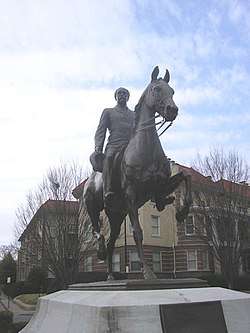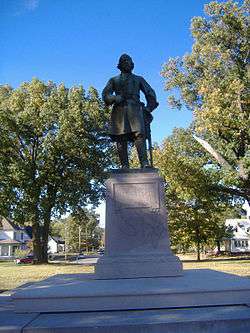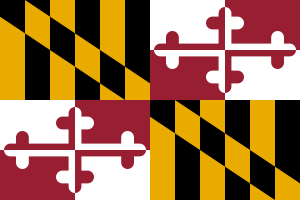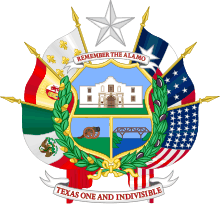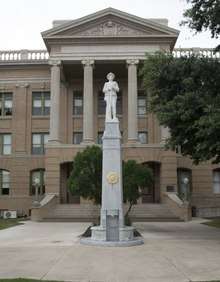List of Confederate monuments and memorials
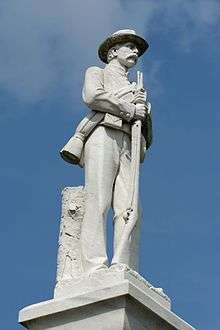
This is a list of Confederate monuments and memorials that were established as public displays and symbols of the Confederate States of America (CSA), Confederate leaders, or Confederate soldiers of the American Civil War. Part of the commemoration of the American Civil War, these symbols include monuments and statues, flags, holidays and other observances, and the names of schools, roads, parks, bridges, counties, cities, lakes, dams, military bases, and other public works.[1]
Monuments and memorials are listed below alphabetically by state, and by city within each state. States not listed have no known qualifying items for the list. [2] Except where noted, cemeteries are not included in this list.
For monuments and memorials which have been removed, consult Removal of Confederate monuments and memorials. Some but by no means all are included below.
This list does not include the removal of figures connected with the origins of the Civil War but not with the Confederacy, including statues of Supreme Court Justice Roger B. Taney in Annapolis, Baltimore, and Frederick, Maryland, and numerous memorials to Southern politician John C. Calhoun (commemorated on the Confederacy's 1¢ stamp). It also does not include post-Civil War white supremacists, such as North Carolina Governor Charles Aycock, some of whose monuments are also being removed.
History
Monument building and dedications
.png)
A small number of memorializations were made during the war, mainly as ship and place names. After the war, Robert E. Lee said on several occasions that he was opposed to any monuments, as they would, in his opinion, "keep open the sores of war".[6] Nevertheless, monuments and memorials continued to be dedicated shortly after the American Civil War.[7] Many more monuments were dedicated in the years after 1890, when Congress established the first National Military Park at Chickamauga and Chattanooga, and by the turn of the twentieth century, five battlefields from the Civil War had been preserved: Chickamauga-Chattanooga, Antietam, Gettysburg, Shiloh, and Vicksburg. At Vicksburg National Military Park, more than 95 percent of the park's monuments were erected in the first eighteen years after the park was established in 1899.[8] Memorials have been erected on public spaces (including on courthouse grounds) either at public expense or funded by private organizations and donors. Numerous private memorials have also been erected.
Confederate monument-building has often been part of widespread campaigns to promote and justify Jim Crow laws in the South, and assert white supremacy.[9][5][4] According to the American Historical Association (AHA), the erection of Confederate monuments during the early twentieth century was "part and parcel of the initiation of legally mandated segregation and widespread disenfranchisement across the South." According to the AHA, memorials to the Confederacy erected during this period "were intended, in part, to obscure the terrorism required to overthrow Reconstruction, and to intimidate African Americans politically and isolate them from the mainstream of public life." A later wave of monument building coincided with the civil rights movement, and according to the AHA "these symbols of white supremacy are still being invoked for similar purposes."[10]
According to historian Jane Dailey from the University of Chicago, in many cases, the purpose of the monuments was not to celebrate the past but rather to promote a "white supremacist future".[3] Another historian, Karen Cox, from the University of North Carolina at Charlotte, has written that the monuments are "a legacy of the brutally racist Jim Crow era", and that "the whole point of Confederate monuments is to celebrate white supremacy".[4] Another historian from UNC, James Leloudis, stated that "The funders and backers of these monuments are very explicit that they are requiring a political education and a legitimacy for the Jim Crow era and the right of white men to rule."[11] They were erected without the consent or even input of Southern African-Americans, who remembered the Civil War far differently, and who had no interest in honoring those who fought to keep them enslaved.[12] According to Civil War historian Judith Giesberg, professor of history at Villanova University, "White supremacy is really what these statues represent."[13] Some monuments were also meant to beautify cities as part of the City Beautiful movement, although this was secondary.[14]
Many Confederate monuments were dedicated in the former Confederate states and border states in the decades following the Civil War, in many instances by Ladies Memorial Associations, United Daughters of the Confederacy (UDC), United Confederate Veterans (UCV), Sons of Confederate Veterans (SCV), the Heritage Preservation Association, and other memorial organizations.[15][16][17] Other Confederate monuments are located on Civil War battlefields. Many Confederate monuments are listed on the National Register of Historic Places, either separately or as contributing objects within listings of courthouses or historic districts. Art historians Cynthia Mills and Pamela Simpson argued, in Monuments to the Lost Cause, that the majority of Confederate monuments, of the type they define, were "commissioned by white women, in hope of preserving a positive vision of antebellum life."[18][19]
In the late nineteenth century, technological innovations in the granite and bronze industries helped reduce costs and made monuments more affordable for small towns. Companies looking to capitalize on this opportunity often sold nearly identical copies of monuments to both the North and South.[20] Another wave of monument construction coincided with the Civil Rights Movement and the American Civil War Centennial.[21] At least thirty-two Confederate monuments were dedicated between 2000 and 2017, including at least 7 re-dedications.[22][23][24][25][26]
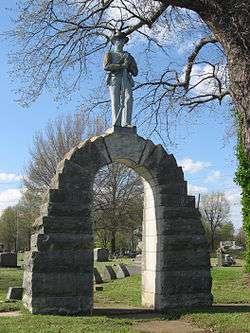
Scholarly studies of the monuments began in the 1980s. In 1983 John J. Winberry published a study which was based on data from the work of R.W. Widener.[27][28] He estimated that the main building period for monuments was from 1889 to 1929 and that of the monuments erected in courthouse squares over half were built between 1902 and 1912. He determined four main locations for monuments; battlefields, cemeteries, county courthouse grounds, and state capitol grounds. Over a third of the courthouse monuments were dedicated to the dead. The majority of the cemetery monuments in his study were built in the pre-1900 period, while most of the courthouse monuments were erected after 1900. Of the 666 monuments in his study 55% were of Confederate soldiers, while 28% were obelisks. Soldiers dominated courthouse grounds, while obelisks account for nearly half of cemetery monuments. The idea that the soldier statues always faced north was found to be untrue and that the soldiers usually faced the same direction as the courthouse. He noted that the monuments were "remarkably diverse" with "only a few instances of repetition of inscriptions".[28]
He categorized the monuments into four types. Type 1 was a Confederate soldier on a column with his weapon at parade rest, or weaponless and gazing into the distance. These accounted for approximately half the monuments studied. They are however the most popular among the courthouse monuments. Type 2 was a Confederate soldier on a column with rifle ready, or carrying a flag or bugle. Type 3 was an obelisk, often covered with drapery and bearing cannon balls or an urn. This type was 28% of the monuments studied, but 48% of the monuments in cemeteries and 18% of courthouse monuments. Type 4 was a miscellaneous group, including arches, standing stones, plaques, fountains, etc. These account for 17% of the monuments studied.[28]
Over a third of the courthouse monuments were specifically dedicated to the Confederate dead. The first courthouse monument was erected in Bolivar, Tennessee, in 1867. By 1880 nine courthouse monuments had been erected. Winberry noted two centers of courthouse monuments; the Potomac counties of Virginia, from which the tradition spread to North Carolina, and a larger area covering Georgia, South Carolina and northern Florida. The diffusion of courthouse monuments was aided by organizations such as the United Confederate Veterans and their publications, though other factors may also have been effective.[28]
Winberry listed four reasons for the shift from cemeteries to courthouses. First was the need to preserve the memory of the Confederate dead and also recognize the veterans who returned. Second was to celebrate the rebuilding of the south after the war. Third was the romanticizing of the Lost Cause, and the fourth was to unify the white population in a common heritage against the interests of African American southerners. He concluded "No one of these four possible explanations for the Confederate monument is adequate or complete in itself. The monument is a symbol, but whether it was a memory of the past, a celebration of the present, or a portent of the future remains a difficult question to answer; monuments and symbols can be complicated and sometimes indecipherable."[28]
Removal

As of April 2017, at least 60 symbols of the Confederacy had been removed or renamed since 2015, according to the Southern Poverty Law Center (SPLC).[29] At the same time, laws in various states place restrictions on the removal of statutes and memorials and in some cases prohibit renaming of parks, roads, and schools.[30][31][32][33][34][35]
A 2017 Reuters poll found that 54% of adults stated that the monuments should remain in all public spaces, and 27% said they should be removed, while 19% said they were unsure. The results were split along racial and political lines, with Republicans and whites preferring to keep the monuments in place, while Democrats and minorities preferring their removal.[36][37] A similar 2017 poll by HuffPost/YouGov found that one-third of respondents favored removal, while 49% were opposed.[38][39]
Distribution
Geographic dispersal
Confederate monuments are widely distributed across the Southern United States.[28] The distribution pattern follows the general political boundaries of the Confederacy.[28] Of the more than 1503 public monuments and memorials to the Confederacy, more than 718 are monuments and statues. Nearly 300 monuments and statues are in Georgia, Virginia, or North Carolina. According to one researcher, "the absence of monuments in eastern Tennessee and western North Carolina indicates those regions' Union sentiment, and the few monuments in Maryland, West Virginia, and Kentucky reflect those states' ambivalent war-time politics." The Northern States that remained part of the Union, as well as the Western States that were largely settled after the Civil War, have few or no memorials to the Confederacy.
National
United States Capitol
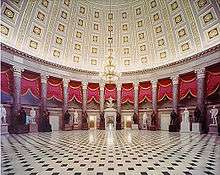
- In the National Statuary Hall Collection, in the United States Capitol, each state has provided statues of two citizens that the state wants to honor. The following Confederate figures are among them, many in Confederate Army uniforms.[40] Dates reflect when the statue was given to the collection:[41][42]
- Robert E. Lee (Virginia, 1909)[43]
- Zebulon Baird Vance (North Carolina, 1916)[44]
- Uriah M. Rose (Arkansas, 1917)[45]
- Edmund Kirby Smith (Florida, 1922). On March 19, 2018, the Governor of Florida signed legislation replacing Smith with African-American educator and Civil Rights advocate Mary McLeod Bethune.[46]
- Joseph Wheeler (Alabama, 1925)[47]
- Alexander Hamilton Stephens (Georgia, 1927)[48]
- Wade Hampton III (South Carolina, 1929)[49]
- Jefferson Davis (Mississippi, 1931)[50]
- James Zachariah George (Mississippi, 1931)[51]
- Jabez Lamar Monroe Curry (Alabama, 1908) was replaced by a statue of Helen Keller in 2009[52]
- Peace Monument, also known as the Naval Monument or Civil War Sailors Monument, stands on the grounds of the United States Capitol in Peace Circle at First Street, N.W., and Pennsylvania Avenue. Erected from 1877-1878 to commemorate the naval deaths at sea during the Civil War.
Coins and stamps
- Robert E. Lee and Stonewall Jackson were portrayed by the US Mint on the 1925 Commemorative silver US half dollar, along with the words "Stone Mountain". The coin was a fundraiser for the Stone Mountain monument, which honors the Confederate Generals. The authorized issue was 5 million coins, to be sold at $1 each, but that proved overly optimistic and only 1.3 million coins were released, many of which ended up in circulation after being spent for face value.[53] The caption on the reverse reads "Memorial to the valor of the soldier of the South".
- Robert E. Lee has been commemorated on at least five US postage stamps. One 1936–37 stamp featured Generals Lee and Stonewall Jackson with Lee's home Stratford Hall.[54][55]
US military
Bases
There are 10 major U.S. military bases named in honor of Confederate military leaders, all in former Confederate States.[5] In 2015 the Pentagon declared it would not be renaming these facilities,[56] and declined to make further comment in 2017.[57]
- Fort Lee, Virginia (1917) named for CSA Gen. Robert E. Lee
- Camp Beauregard, Louisiana (1917) named for CSA Gen. Pierre Gustave Toutant Beauregard.[58]
- Fort Benning, Alabama/Georgia border (1917) named for CSA Brig. Gen. Henry L. Benning
- Fort Gordon, Georgia (1917) named for CSA Maj. Gen. John Brown Gordon
- Fort Bragg, North Carolina (1918) named for CSA Gen. Braxton Bragg. The largest military installation in the world by population.[59]
- Fort Polk, Louisiana (1941) named for CSA Gen. Leonidas Polk
- Fort A.P. Hill, Virginia (1941) named for CSA Lt. Gen. A. P. Hill
- Fort Pickett, Virginia (1942) named for CSA Gen. George Pickett
- Fort Rucker, Alabama (1942) named for CSA Gen. Edmund Rucker[56]
- Fort Hood, Texas (1942) named for CSA Gen. John Bell Hood.[60]
- Camp Breckinridge, near Morganfield, Kentucky (closed) named for John C. Breckinridge, U.S. Vice President and Confederate general. Prisoner of war camp during World War II; used for Army basic training during the Korean War. Currently houses the Earle C. Clements Job Corps Center.
Facilities
- Lee Barracks, named for CSA Gen. Robert E. Lee (1962), at U.S. Military Academy at West Point, New York.[61]
- Lee Barracks (de) (Mainz, Germany), closed in 1992
- U.S. Naval Academy in Annapolis, Maryland:
- Buchanan House, the Naval Academy superintendent's home, named for CSA naval officer Franklin Buchanan.[62] A road near the house is also memorialized in Buchanan's name.
- Maury Hall, home to the academy's division of Weapons and Systems Engineering, named for US naval officer in charge of the Depot of Charts and Instruments at Washington and later CSA naval officer Matthew Fontaine Maury.[62][63]
Current ships
- USNS Maury (T-AGS-66) (2013)
Former ships
- USS Buchanan: Three U.S. Navy destroyers have been named in honor of the highest ranked Confederate Admiral Franklin Buchanan
- USS Buchanan (DD-131) 1919–1940 then transferred to UK Navy
- USS Buchanan (DD-484) 1941–1949 then transferred to Turkey's Navy
- USS Buchanan (DDG-14) 1960–1991 then sank as target in 2000
- USS Maury – 5 former ships have carried the Maury name dating from WWI and WWII.
- USS Robert E Lee (SSBN-601) (ballistic missile submarine) in honor of Gen. Robert E. Lee.
- USS Semmes – two destroyers have been named for Raphael Semmes.
- USS Semmes (DD-189) 1920–1946
- USS Semmes (DDG-18) 1962–1991
- USS Stonewall Jackson (SSBN-634) 1964–1995.
- USS Tom Green County (LST-1159) 1953–1972 then transferred to Spain. The namesake Texas County was named for CSA Brig Gen Thomas Green
- USS Zebulon B. Vance, a World War II liberty ship, named for CSA Colonel and North Carolina Confederate governor Zebulon Baird Vance.
- Three ships named for Confederate leaders fell into Union hands during the Civil War. The Union Navy retained the names of these ships while turning their guns against the Confederacy:
- Beauregard a privateer with letters of marque issued by the Confederacy, named in honor of Gen. P. G. T. Beauregard. Captured as a prize and purchased on Feb. 24, 1862 by the Union Navy which operated it as the USS Beauregard.
- USS General Price (1862) a Confederate ship sunk in battle, raised and used by the Union until sold in 1865.
- Liberty Ship #113, named for Joseph E. Johnston by the US Navy.[64]
- Liberty ship #5, named for Alexander H. Stephens
- Liberty ship #8, named for Jefferson Davis
Within National Parks
- The Robert E. Lee giant sequoia in Kings Canyon National Park in California.
Multi-state highways
- Jefferson Davis Highway, Arlington, Virginia to San Diego, California. Markers that remain are listed under the states.
- Lee Highway, New York City to San Francisco. Markers that remain are listed under the states.
Alabama

There are at least 107 public spaces with Confederate monuments in Alabama.[5]
The 2017 Alabama Memorial Preservation Act was passed to require local governments to obtain state permission before removing Confederate monuments and memorials.[65][66][67]
Capitol
- Confederate Memorial Monument, also known as the "Monument to Confederate Soldiers and Sailors" (1898).[68] On June 24, 2015, in the wake of the Charleston church shooting on June 17, 2015, on the order of Governor Robert J. Bentley, the four Confederate flags, and their poles, were removed.[69]
- Jefferson Davis Presidential Star, marble portico (1897).[70] "Placed by the Sophie Bibb Chapter Daughters of the Confederacy on the Spot where Jefferson Davis Stood when Inaugurated President of the C.S.A. Feb. 18, 1861"[71]
- Jefferson Davis (1940), by UDC[72]
- John Allan Wyeth – M.D., L.L.D., marker. Fought in Confederate Army.
State symbols

- Alabama Coat of Arms (1923) and the State Seal include the Confederate Battle Flag.
- Alabama State Flag (1895) The Alabama Department of Archives and History found in 1915 that the flag was meant to "preserve in permanent form some of the more distinctive features of the Confederate battle flag, particularly the St. Andrew's cross."[73] According to historian John M. Coski, the adoption of Alabama's flag coincided with the rise of Jim Crow laws and segregation,[74] as other former Confederate slave states, such as Mississippi and Florida, also adopted new state flags based off Confederate designs around the same time when those states instituted Jim Crow segregation laws themselves:[74]
- The Governor's version of the State Flag includes St Andrew's Cross plus the State Coat of Arms with the Confederate Battle Flag inclusion and the military crest on the bottom.
State holidays
- Robert E. Lee Day, celebrated together with Martin Luther King Jr. Day on the third Monday in January[75]
- Confederate Memorial Day, celebrated the fourth Monday in April[75]
- Jefferson Davis Day, Celebrated the first Monday in June[75]
Buildings
Monuments
Courthouse monuments


.jpg)
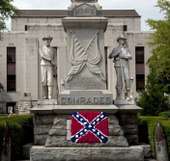
- Ashville: Confederate Soldiers of Ashville Monument, St. Clair County Courthouse (1923) by United Daughters of the Confederacy, (UDC) Ashville Chapter[77]
- Athens: Limestone County Confederate Soldiers Memorial, Limestone County Courthouse (1922) by United Confederate Veterans (UCV) and UDC[78]
- Butler: Confederate Monument, Choctaw County Courthouse (1936) by UDC, Choctaw Ruffin Dragoon Chapter[79]
- Carrollton: Confederate War Memorial, Pickens County Courthouse (1927)[80]
- Centre: Confederate Memorial, Cherokee County Courthouse (1988) by SCV, Emma Sansom Camp No. 27[81]
- Centreville: Confederate Monument, Bibb County Courthouse (1910) by UDC, Leonard Calloway Pratt Chapter No. 1056.[82] "These were men who by the simple manhood of their lives, by their strict adherence to the principles of right, by their sublime courage and unspeakable sacrifices, even to the heroism of death, have preserved for us through the gloom of defeat a priceless heritage of honor."[83]
- Clayton: Confederate Monument (1909); UDC monument at Barbour County Courthouse Square[84]
- Decatur: Confederate Monument, near Morgan County Courthouse (1922) by UDC, Joe Wheeler Chapter No. 291[85]
- Fayette: Confederate Monument, Fayette County Courthouse (1929) by UDC, Fayette Chapter[86]
- Florence: Confederate Monument, Lauderdale County Courthouse (1903) Ladies Memorial Association[87]
- Greensboro: Confederate Monument, Hale County Courthouse (1904) Ladies Memorial Association of Greensboro.
- Huntsville: Confederate Veterans Memorial, Madison County Courthouse (1905) by UDC[88]
- Jasper: Confederate Monument, Walker County Courthouse (1907) Jasper County Chapter 925 by UDC[89]
- Livingston: Confederate Monument, Sumter County Courthouse (1908) by UDC, Sumter Chapter[90]
- Marion: UDC Monument at Marion Courthouse Square to Nicola Marschall, designer of the original Confederate flag and Confederate uniform[91]
- Moulton: Confederate Monument, Lawrence County Courthouse (2006) by SCV, Lt. J. K. McBride Camp No. 241 and the Alabama Division[92]
- Tuscumbia: Confederate Veterans Monument, Colbert County Courthouse (1911) by UDC, Tuscumbia Chapter[93]
Other public monuments
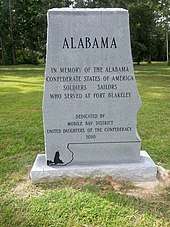

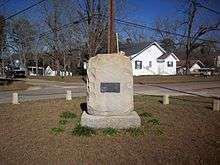

- Anniston: Major John Pelham Monument, Quintard Avenue (1905) through the efforts of Clarence J. Owens, president of Anniston College for Young Ladies[94]
- Athens: Limestone County Confederate Soldiers Memorial, Athens City Cemetery (1909) by UDC, Joseph E. Johnston Chapter
- Birmingham: Confederate Soldiers and Sailors Monument, Linn Park (1905) by UDC, Pelham Chapter No. 67[78][95][96]
- Blakeley: UDC monument (2010) at Historic Blakeley State Park dedicated to Confederate soldiers and sailors who served at Fort Blakeley[97]
- Demopolis:
- Confederate Monument (1910). The statue was toppled on July 16, 2016 when a policeman accidentally crashed his patrol car into the monument; the statue fell from its pedestal and was heavily damaged. In 2017, the Demopolis city council voted 3–2 to move the damaged Confederate statue to a local museum and to install a new obelisk memorial that honors both the Union and the Confederate soldiers.[98][99]
- Breastworks Confederate Memorial (1941)
- Confederate Square (now Demopolis Public Square)[100]
- Eufaula: Confederate Monument (1905) by UDC, Barbour County Chapter[101]
- Fort Mitchell: Inscription on the horse mounting stone of CSA General James Cantey, at Fort Mitchell National Cemetery[102]
- Fort Payne: Confederate Monument (1913) by UDC and SCV of DeKalb County, Alabama[103]
- Gadsden:
- Emma Sansom and Nathan Bedford Forrest Monument (1907) by UDC, Gadsden Chapter.[104]
- Turkey Town Monument (1992) by SCV, Turkey Town Valley Camp #1512[105]
- Greenville: Butler County Confederate Memorial, "Our Confederate Dead", at Confederate Park (1903) by UDC of Butler County, Alabama, Father Ryan Chapter[106]
- Hamilton: Confederate Veterans Bicentennial Memorial (1977)
- Hayneville: Soldiers of Lowndes County Who Died in Service, Hayneville Town Square
- Headland: Henry County Confederate Memorial (1936) by UDC, Headland Chapter No. 1673[107]
- Jacksonville: Confederate Monument, Jacksonville Town Square (1909)[108]
- Lowndesboro: Our Confederate Soldiers Monument (1929) by the Lowndesboro Chapter of UDC of Lowndes County, Alabama.
- Midway:
- Granite boulder marker at Hwy 82 & 51 erected to commemorate the Jefferson Davis Highway and Soldiers of the Confederacy
- Confederate Memorial Marker at corner of Hwy 82 and Main Street in honour of Midway Guards prior drill grounds erected by UDC (1960)[109]
- Millbrook: Robinson Springs Camp Confederate Monument (1913) by UCV Camp No. 396, Elmore County, Alabama[110]
- Mobile:
- Statue of Admiral Raphael Semmes, on Government Street near the Bankhead Tunnel (1900) by SCV, Raphael Semmes Camp 11[111]
- Confederate Fortification Monument (1940), Mobile National Cemetery[112]
- Montgomery:
- State Capitol. See above.
- UDC monument (1942) on Dexter Avenue: "Along this street moved the inaugural parade of Jefferson Davis when he took the oath of office as President of the Confederate States of America February 18, 1861. Dixie was played as a band arrangement for the first time on this occasion."[113]
- Robert E. Lee statue, Robert E. Lee High School (1908)[114]
- Munford: A. J. Buttram Monument (1914) by UDC, John Tyler Morgan Chapter[115]
- Opelika: Confederate Monument (1911) by UDC, Robert E. Lee Chapter[116]
- Newton: Monument dedicated to the Confederate victory in the Battle of Newton[117]
- Ohatchee: Calhoun County Confederate Memorial (2003) at Janney Furnace Park, "the world's largest black granite Confederate Memorial"[118][119]
- Ozark: Dale County Confederate Soldiers Monument (1910) Stonewall Jackson Chapter by UDC No. 667 of Dale County, Alabama
- Prattville:
- Confederate Monument, City Hall Square (1908) by UDC[120]
- UDC monument (1916) to Prattville Dragoons, on grounds of Prattville Primary School[121]
- Rogersville: CSA Gen. Joseph Wheeler Monument, Joe Wheeler State Park (2006) by SCV, Freeman's Battery Forrest's Artillery Camp No. 1939[122]

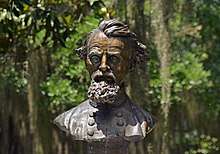
- Selma:
- The Edmund Pettus Bridge (1940), on US Route 80, is named for Edmund Pettus, Confederate General and Alabama Grand Dragon of the KKK.[123] This is the beginning of the Selma to Montgomery National Historic Trail (1996), commemorating the Selma to Montgomery civil rights marches of 1965.
- Defense of Selma Memorial (1907) by UDC[120][124]
- Memorial boulder marking The Selma Ordnance and Naval Foundry "destroyed by the Federals 1865," placed "in honor of the memory of hundreds of faithful men who made these great works a base for war material for the entire Confederate Army and Navy." (1917) Alabama Division United Daughters of Confederacy.[125]
- "Arsenal Place" memorial (1931), marking the site of the Confederate ordnance works "destroyed by the Union Army April 6, 1865"
- A memorial arch on the grounds of the Federal Building / U.S. Courthouse honors Confederate Generals and Senators John Tyler Morgan and Edmund Pettus
- Old Live Oak Cemetery, a Selma city-owned property, incorporates various features including:
- Jefferson Davis Memorial Chair – an inscribed stone chair
- Confederate Memorial Circle (1878) Confederate Memorial Association[120]
- The Nathan Bedford Forrest Bust Monument (2000). Built partly with city funds, sponsored by Friends of Forrest and UDC. It was first located at the Vaughan-Smitherman Museum, but during protest over Forrest's KKK links trash was dumped on it[126] and it was damaged during an apparent attempt to remove the bust from its foundation. It was then moved to the Cemetery's Confederate Circle. The bust was then stolen in 2012[127] and has not been recovered, despite a $20,000 reward; the present bust is a replacement.[128] The base is inscribed, under a Confederate flag: "Defender of Selma, Wizard of the Saddle, untutored genius, the first with the most. This monument stands as testament of our perpetual devotion and respect to Lt. Gen. Nathan Bedford Forrest, C.S.A., 1821-1877, one of the South's finest heroes. In honor of Gen. Forrest's unwavering defense of Selma, the great state of Alabama, and the Confederacy, this memorial is dedicated. Deo vindice."[129][130]
- A Confederate Soldier Monument (pre-1881) with cannons protecting it
- Graves and memorials to four CSA generals: John Tyler Morgan, Edmund Winston Pettus, Nathaniel H. R. Dawson, William J. Hardee and Confederate Navy Commander Catesby ap Roger Jones
- A building historically used for concerts and Confederate Memorial Day celebrations
- Elodie Todd Dawson Monument (sister-in-law to President Lincoln, strong advocate for the Confederacy)[131]
- Tallassee
- Confederate Armory. When Richmond was threatened by Union troops, the Confederacy moved its armory to Tallassee. It is the only Confederate armory to survive the war. Only the brick shell of the large building survives. There is a historical marker.[132]
- Confederate Officers' Quarters, 301, 303 (demolished), 305, and 307 King Street. Made necessary by the relocation of the armory. After the Civil War, Confederate Brigadier-General Birkett Davenport Fry lived at 301 King Street until 1880. The building is currently used as a law firm office, but there is a historical marker.[133]
- Troy: "Comrades" Confederate Monument (1908) Pike Monumental Association, UCV, and UDC of Pike County, Alabama[134]
- Tuscaloosa: University of Alabama Civil War Memorial, South entrance of Amelia Gayle Gorgas Library (1914) by UDC, Alabama Division[135]
- Tuscaloosa County: UDC monument (1977) at Tannehill Ironworks, where Confederate munitions and iron were manufactured[136]
Private monuments
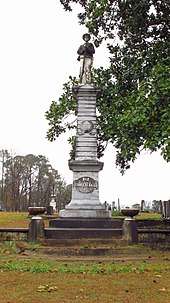
- Auburn: Auburn Guard Monument, Pine Hill Cemetery (1893) Ladies Memorial Association, forerunner of UDC[78]
- Birmingham: Confederate Monument, Elmwood Cemetery (1906), UCV, Camp Hardee[78]
- Boligee: Confederate Monument, Bethsalem Cemetery (1896) Ladies Memorial Association[137]
- Calera: Shelby Springs Memorial
- Camden: Confederate Monument (1880) Ladies Memorial and Wilcox Monumental Associations, Wilcox County, Alabama[137]
- Crenshaw County, near Brantley: In August, 2017, the new Unknown Alabama Confederate Soldiers Monument was installed in Confederate Veterans Memorial Park on Route 331, 3 miles north of Brantley.[138][139] The park, established in 2015, is privately owned.[140]
- Eutaw: Confederate monument in Mesopotamia Cemetery.
- Gainesville:
- Jacksonville: The Gallant Pelham Statue, Jacksonville City Cemetery (1905) by UDC, John H. Forney Chapter[108]
- Mobile: Confederate Rest and Monument, Magnolia Cemetery (1874)[142]
- Plattville: marker in front of Mulbry Grove Cottage, the "meeting place where the Prattville Dragoons, a Civil War unit, was organized in 1861.[143]
- Talladega: Confederate Memorial. Oak Hill Cemetery
- Tuscaloosa: Confederate Monument, Greenwood Cemetery (1880) by the Ladies Memorial Association[144]
- Tuskegee: Tuskegee Confederate Monument, erected October 6, 1906 by UDC of Macon County, Alabama.[145] The UDC owns both the monument and the town park it is located in. There have been several unsuccessful attempts to tear it down or have it removed legally. As of 2018, the UDC has stopped removing spray-painted defacement, "because it would only be repeated".[146]
- Union Springs: Confederate Monument, Old City Cemetery (The Confederate Cemetery) (1893) Ladies Memorial Association[147]
- Wetumpka: Wetumpka Light Guards Memorial
Inhabited places
- Bullock County (1866) named for secessionist politician and CSA Col. Edward Bullock
- Chilton County (1868) named for William Parish Chilton, judge and member of the Confederate Provisional Congress
- City of Clanton (1866) seat of Chilton County named for CSA Brig. Gen. James H. Clanton
- Cleburne County (1866) named for CSA Maj. Gen. Patrick Cleburne
- Hale County (1867) named for CSA Lt. Col. Stephen F. Hale; also a member of the Provisional Confederate States Congress
- Lee County (1866) named for Robert E. Lee.
- Beauregard, Alabama (unincorporated) in Lee County named for CSA Gen. P.G.T. Beauregard
- Wheeler, Alabama (unincorporated), location of the National Register of Historic Places-listed Joseph Wheeler Plantation, both named for the Confederate General Joseph Wheeler.
Parks, water features and dams
- Brantley: Confederate Veterans Memorial Park, privately owned[138]
- Demopolis: Confederate Park is the town square named so in 1923 at the request of UDC.
- Florence: McFarland Park and Recreation Area, named for Confederate Maj. Robert McFarland[148]
- Greenville: Confederate Park (1910)
- Marbury: Confederate Memorial Park. The site operated as the Old Soldiers Home for Confederate Veterans from 1902 to 1939. In 1964, the Alabama State Legislature established the memorial park, which now hosts a museum and archives[149]
- Miami: Robert E. Lee Park
- Mountain Creek: Confederate Memorial Park[150] and Alabama Confederate Soldiers Home
- Rogersville: Joe Wheeler State Park (1949) beside Wheeler Lake and Wheeler Dam all named for Confederate General and U.S. Congressman Joseph Wheeler
Roads
- Dauphin Island: Beauregard Street
- Fair Hope: Jeff Davis Street
- Gardendale: Robert E. Lee Drive
- Hodges: Robert E. Lee Drive
- Leeds: Robert E. Lee Street
- Livingston:
- Forrest Drive
- Hood Street, named for CSA Lt. Gen. John Bell Hood
- Jefferson Davis Drive
- Lee Street
- Longstreet Drive, named for CSA general James Longstreet.
- Morgan Drive, named for CSA Gen. John Hunt Morgan
- Stonewall Street
- McCalla: Confederate Parkway
- Millbrook: Robert E. Lee Drive
- Mobile:
- Beauregard Street
- Forrest Street
- Johnston Street, named for Confederate general Albert Sidney Johnston
- Polk Street, named for CSA Lt. Gen. Leonidas Polk
- Robert E. Lee Street
- Van Dorn Street, named for CSA Maj. Gen. Earl Van Dorn
- Montgomery:
- Beauregard Street
- Jefferson Davis Avenue
- Ozark:
- Jeb Stuart Court
- Stonewall Circle
- Selma:
- Forrest Avenue
- Trussville: Robert Lee Street
Schools
- Brewton: Jefferson Davis Community College (1965)
- Huntsville: Lee High School (1957), home to the Lee Generals[151]
- Montgomery:
- Jefferson Davis High School (1968)
- Robert E. Lee High School (1955). The school mascot is the General[151]
- Sidney Lanier High School (1910)
- Opelika:
- Beauregard Elementary School (2001) new campus on Lee County Rd 300 constructed, previously shared location with high school[152]
- Beauregard High School (1923)
- Satsuma: Robert E. Lee Elementary School
- Selma:
- John Tyler Morgan Academy, a segregation academy founded in 1965
- Vestavia Hills City Schools, home of the Rebels. Until 2017, the school mascot was the Rebel Man, a Confederate Flag-waving Civil War rebel and plantation owner[151]
City symbols
- Mobile: city flag includes the city seal which incorporates a small Confederate Battle Flag along with other flags.
- Montgomery:
- The red and gray city flag includes a strip of stars from the Confederate Battle Flag.
- The city seal (seen here) includes the words "Cradle of the Confederacy" and "Birthplace of the Civil Rights Movement"
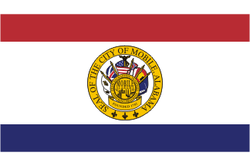
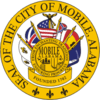
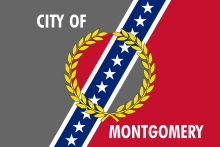
Alaska
- Yukon–Koyukuk Census Area: "Confederate Gulch" and "Union Gulch" both drain the side of a mineralized mountain mass northeast of Wiseman. Gold was discovered in both gulches in the early 20th century, though only Union Gulch was mined.[153][154]
Arizona
There are at least six public spaces with Confederate monuments in Arizona.[155]
| Type of monument | Date | Location | Details | Image |
|---|---|---|---|---|
| Public | 1961 | Phoenix | Memorial to Arizona Confederate Troops, in Wesley Bolin Park, next to the Arizona State Capitol; UDC memorial.[156] |  |
| Public | Picacho Peak State Park | A commemorative sign and a plaque commemorates the Battle of Picacho Pass, the westernmost Confederate engagement of the war. The sign is "dedicated to Capt. Sherod Hunter's 'Arizona Rangers, Arizona Volunteers' C.S.A.", while the plaque states three Union soldiers buried on battlefield and includes both US Union and CSA flags.[156][157][158] | 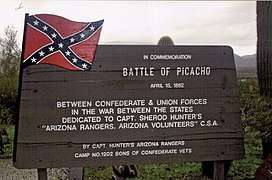 | |
| Public | 2010 | Sierra Vista | Confederate Memorial, Historical Soldiers Memorial Cemetery area of the state-owned Southern Arizona Veterans' Cemetery. The monument was erected in to honor the 21 soldiers interred in that cemetery who served in the Confederate Army during the Civil War and later fought in Indian wars in Arizona as members of the U.S. Army.[156][159] | |
| Private | 1999 | Phoenix | Arizona Confederate Veterans Monument, at Greenwood Memory Lawn Cemetery; erected by SCV.[156] |  |
| Road | 1943 | Jefferson Davis Memorial Highway marker 50 mi (80 km) east of Phoenix; erected by UDC. Tarred and feathered in August 2017.[156][160] | ||
| Former | Fort Breckinridge | Named for John C. Breckinridge, U.S. Vice President, from its opening in 1860 until 1862, when it was renamed Fort Breckenridge to distance it from Breckinridge, who had become a Confederate general. Named Camp Grant (for Union general Ulysses S. Grant) in 1865. Site closed in 1872, when Camp Grant was moved to a new location. |
Arkansas
There are at least 57 public spaces with Confederate monuments in Arkansas.[5]
State capitol
- Confederate Soldiers Monument, also known as Defense of the Flag, Arkansas State Capitol grounds, (1905).[161]
- Confederate War Prisoners Memorial, Arkansas State Capitol grounds.[161]
- Monument to Confederate Women (or "Mother of the South"), Arkansas State Capitol grounds, Little Rock, Arkansas. Statue depicts a mother and daughter saying good-bye to their 16-year-old son and brother who is leaving to join his father in the fighting. (1913)[162]
- Old State House, several on the grounds:[163]
- David O. Dodd Memorial (1923)
- Defenders Memorial Plaque (1932)[164]
- Gen. Thomas J. Churchill Memorial (1928)
- Gen. William Read Scurry Memorial (1928)
- Old State House Confederate Memorial[165]
Monuments
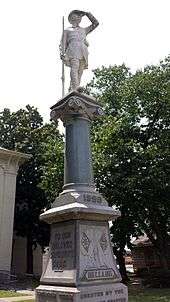
Courthouse monuments
- Arkadelphia: Arkadelphia Confederate Monument (1911)
- Blytheville: Confederate War Memorial (1934)
- Camden: Camden Confederate Monument (1915)
- Conway: Conway Confederate Monument (1925)
- El Dorado: El Dorado Confederate Monument (1909)
- Fort Smith: Ft. Smith Confederate Monument (1903)
- Lake Village: Lake Village Confederate Monument (1910)
- Lonoke: Lonoke Confederate Monument (1910)
- Marion, Crittenden County: Civil War Memorial (1936)
- Osceola: Searcy Confederate Monument (1917)[162]
- Van Buren: Van Buren Confederate Monument (1899)
Other public monuments
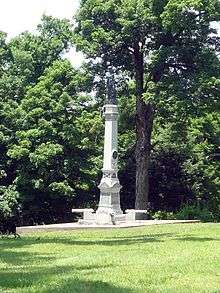
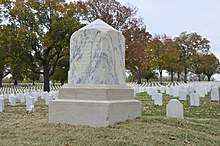
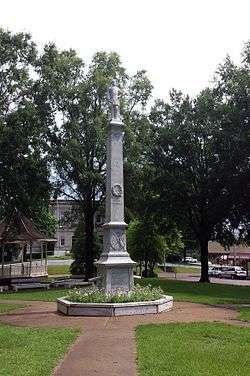
- Batesville: Batesville Confederate Monument (1907)
- Benton: Confederate Veterans' Memorial
- Bentonville: Bentonville Confederate Monument (1908); UDC monument[166]
- Camden: Granite obelisk topped by a cannonball, in fenced-off Confederate section of Oakland Cemetery
- Clarendon: Confederate Memorial
- Clarksville: Clarksville Confederate Monument, (1902) The Oakland Cemetery obelisk inscribed, "Sacred to the memory of our Confederate dead," was added to the National Register of Historic Places in 1999.[167]
- Dardanelle: Dardanelle Confederate Monument (1921)
- Fayetteville: Confederate statue (1897), Fayetteville Confederate Cemetery[168]
- Fort Smith: Jefferson Davis Memorial (1937)
- Grant County: UDC monument (1928) at Jenkins' Ferry Battleground State Park to Confederate soldiers who died at the Battle of Jenkins' Ferry[169]
- Harrison: Boone County Confederate Veterans Memorial, on the grounds of the Boone County Courthouse (1986)
- Hot Springs:
- Confederate State Capital, Bathhouse Row
- Hot Springs Confederate Monument (1934)
- Jacksonport: Jackson County Confederate Memorial (1914)
- Little Rock:
- Children of the Confederacy
- Confederate Bench (1936)
- Confederate Last Stand Monument
- CSS Pontchartrain
- Little Rock National Cemetery:
- Confederate Soldiers Monument (1884); marks the mass burial of 640 Confederate soldiers[170]
- Little Rock Confederate Memorial (1913)[171]
- Memorial to Company A Confederate Soldiers (1911)
- Monument to Confederate Soldiers (1905)
- Southern Soldiers Memorial
- Magnolia: Gen. John Porter McCown Monument
- Marianna: Gen. Robert E. Lee Monument, 1910.
- Marmaduke: John Sappington Marmaduke Memorial
- Monticello: Monticello Confederate Monument
- New Edinburg: Captain Richard Tunball Banks Monument, 1864.
- Newport: Jackson Guards Memorial, built in 1914. Monument consists of a statue of a single Confederate soldier and a roster of the men who served in the Jackson Guards and the slaves who supported them. The only Confederate monument in Arkansas built entirely with funds raised by private subscription, although it was built on a prominent piece of land donated by the city of Hot Springs.[162]
- Pea Ridge:
- Pine Bluff:
- David O. Dodd Memorial
- Pine Bluff Confederate Monument (1910)
- Prescott: Confederate War Memorial (1964)
- Smithville: Confederate War Memorial (1996)[175]
- Star City: Star City Confederate Memorial (1926) Erected on the courthouse grounds, moved in 1943 and moved again to its original position, now the town square, in the 1990s. Consists of a statue of a Confederate soldier.[162]
- Van Buren:
- Confederate Memorial (1906) Originally at Fairview cemetery.
- Fairview Cemetery Confederate Memorial; replacement when original was moved to downtown.[176]
- Washington:
- Confederate Masonic Memorial
- Washington Confederate Monument (1888), Washington Presbyterian Cemetery. Listed on the National Register of Historic Places in 1996.[177][178]
Inhabited places
- Cleburne County (1883), named for CSA Maj. Gen. Patrick Cleburne.[179]
- Faulkner County (1873), named for CSA Col. Sanford Faulkner.[180]
- City of Forrest City (1870), named for CSA Gen. Nathan Bedford Forrest.[181]
- Lee County (1873), named for CSA Gen. Robert E. Lee.[182]
Parks
- Russellville: Confederate Mothers Memorial Park (1921). Land for the public park was donated by UDC and includes three stone monuments, each one placed by a different Confederate veterans or memorial organization, honoring the mothers of the Confederacy.[183]
Roads
- El Dorado: Robert E. Lee Street
- Forrest City: Confederate Drive
- Heber Springs: Jefferson Davis Road
- Hughes: Jeff Davis Street
- Jacksonville: Jeff Davis Avenue
- Lake Village: Confederate Street
- Little Rock:
- Beauregard Drive
- Claiborne Drive
- Longstreet Drive
- Pickett Drive
- Malvern: Robert E. Lee Street
- Wilson: Jeb Stuart Drive
Schools
- Forrest City:
- Forrest City High School (1914)
- Forrest City Junior High School
- Little Rock: Robert E. Lee School
- Pine Bluff: Forrest Park Prep Preschool
- Springdale: Robert E. Lee Elementary School (1951)
State symbols
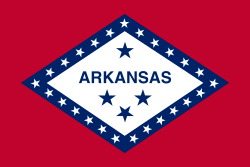
- Flag of Arkansas The blue star above "ARKANSAS" represents the Confederate States of America and is placed above the three other stars for the countries (Spain, France and the US) to which the State belonged before statehood. The diamond represents the nations only diamond mine with bordering 25 stars symbolizing 25th state to join.[73] The design of the border around the white diamond evokes the saltire found on the Confederate battle flag.[184]
California
There are at least eight public spaces with Confederate monuments in California.[5]
Monuments
- San Diego: Confederate Soldiers Memorial (1948), at city-owned Mount Hope Cemetery[185]
- Santa Ana: CSA monument with the inscription "to honor the sacred memory of the pioneers who built Orange County after their valiant efforts to defend the Cause of Southern Independence" in Santa Ana Cemetery. Installed in 2004.[186][187]
Roads
- Los Angeles: Johnston Street in Lincoln Heights, named for CSA Gen. Albert Sidney Johnston.[5]
- There are at least four remaining markers of the Jefferson Davis Highway in the state of California including the following:[5][188]
- Bakersfield in Pioneer Village (1942, rededicated 1968)
- Hornbrook (1944)
- Lebec at Fort Tejon (1956, rededicated 1976)
- Winterhaven at Fort Yuma
Schools
- Anaheim: Savanna High School (1961) mascot has always been Johnny Rebel and a fiberglass statue of a Confederate soldier stood in the courtyard from 1964 until 2009[189] when it was removed due to deterioration. The school colors are red and grey and the school fields the Savanna Mighty Marching Rebel Band and Color Guard.
Mountains and recreation
- Jeff Davis Peak Elevation: 9065 ft / 2763 m 36°38′13″N 119°53′49″W / 36.637°N 119.897°W in the Mokelumne Wilderness[190] mapped by the USGS in 1889; "however, it may have long been used locally, as many of the inhabitants of nearby Summit City (now abandoned [in the late 1860s]) were Confederate sympathizers during the civil war. Jefferson Davis (1809–89) was president of the Confederacy, 1861–65."[191]
- Pickett Peak: named for Confederate General George Pickett Elevation: 9118 ft / 2779 m 38°45′22″N 119°54′11″W / 38.756°N 119.903°W in National Forest, near the Mokelumne Wilderness[192]
- Fortuna: Pickett Peak Campground operated by the National Forest Service[193]
- The Robert E. Lee giant sequoia in Kings Canyon National Park run by the National Park Service.
Mine
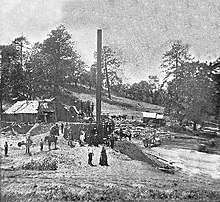
- San Diego County: Stonewall Jackson Mine (1870-1893), the richest gold mine in southern California history[194]
Colorado
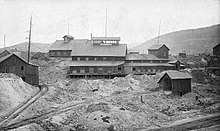
Schools
- Keenesburg: Weld Central Senior High School and Weld Central Middle School share the Weld Central Rebel, a Civil-war-era-soldier which used to appear with depictions of Confederate flags. School teams are named Rebels.[195]
Monument
- Confederate monument Riverside Cemetery, Denver (1973)[196]
Mine
Delaware
There are no public spaces with Confederate monuments in Delaware.[5]
- Georgetown: Delaware Confederate Monument, a private monument built on the grounds of the Georgetown Historical Society, unveiled in 2007.[199][200]
District of Columbia
- Washington: Brigadier General Albert Pike (1901) is an outdoor statue owned by the National Park Service at 3rd and D Streets NW in the Judiciary Square neighborhood of Washington, D.C. Pike was a Confederate General and leading Freemason and is dressed as a Mason in the sculpture.[5][42] The statue is a "portrait of Albert Pike as a Masonic leader and not as a general in the military."[201][202][203] "Eight D.C. elected officials have asked the National Park Service to remove" the statue.[204]
Florida

There are at least 61 public spaces with Confederate monuments in Florida.[5]
An August 2017 meeting of the Florida League of Mayors was devoted to the topic of what to do with Civil War monuments.[205]
State capitol
- Confederate monument of Leon County, on the grounds of the former Florida State Capitol, the "Old Capitol," now a museum.[206] Erected 1882 by "our country women", moved to current location 1923.[207]
State symbol
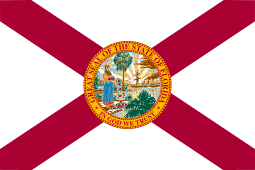
- The current flag of Florida, adopted by popular referendum in 1900, with minor changes in 1985, contains the St. Andrew's Cross. It is believed that the Cross was added in memory of, and showing support for, the Confederacy.[208][209][73][210] The addition of the Cross was proposed by Governor Francis P. Fleming, a former Confederate soldier, who was strongly committed to racial segregation.
Monuments
Courthouse monuments

- Bartow: 7th Florida Infantry Regiment Monument, Old Polk County Courthouse (1982)[211]
- Brooksville: Confederate Soldiers' Memorial, Hernando County Courthouse (1916)[212][27]
- Defuniak Springs: Florida's First Confederate Monument, Walton County Courthouse (1871, historic marker nearby)
- Marianna:
- Battle of Marianna Monument, Jackson County Courthouse lawn (1924)[213][27]:36
- Confederate monument, Jackson County Courthouse lawn (1881)
- Monticello: Confederate monument, Jefferson County Courthouse (1899)[213][214][27]:36
- Ocala: Confederate monument, erected on the grounds of the Marion County Courthouse (1908, moved to Veterans Memorial Park and rededicated 2011)[215][27]:37
- Palatka: Confederate monument, Putnam County Courthouse (1925)[216][27]:38
- Quincy: Our Fallen Heroes monument, Gadsden County Courthouse (1884)[217]
Other public monuments
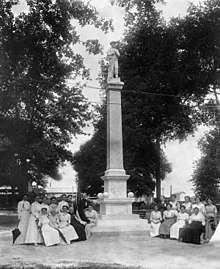
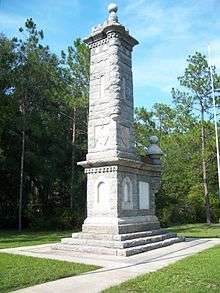
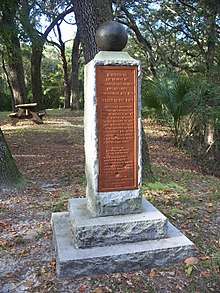
- Daytona Beach:
- Dixie County: American Veteran Monument, Highway 98 west of Old Town, dedicated to Confederate veterans (ca. 2005)[218]
- Jefferson County, Florida: Monument to Stonewall Jackson
- Ellenton:
- Confederate Veterans Memorial Monument, Gamble Plantation Historic State Park (1937)[27][219]
- Judah P. Benjamin Confederate Memorial at Gamble Plantation Historic State Park, established 1925, pursuant to agreement between UDC and State of Florida.[220] Also serves as home to Florida Division of UDC.[221]
- Fernandina Beach: Statue of David Levy Yulee.[222]
- Fort Myers: Lee Bust Memorial, in the median of Monroe Street downtown. The bust was commissioned from Italian sculptor Aldo Pero for $6,000 by the Laetitia Ashmore Nutt Chapter of UDC, chapter 1447 (1966).[223] In 2017, the Mayor sought public opinions on whether it should be removed.[224]
- Jacksonville:
- Confederate Park. It opened in 1907 as Dignan Park, named for a former chairman of the city's Board of Public Works. In 1914, the park was chosen as the location of the annual reunion of the United Confederate Veterans. The UCV chose the park as the location for a new monument to honor the Women of the Southland, and five months after the reunion the city resnamed the park "Confederate Park."
- Florida's Tribute to the Women of the Confederacy, in Confederate Park (1915). The sculptor was Allen George Newman.[225]
- Confederate monument, downtown Hemming Park (1898)[226][27]:34 "The president of Jacksonville City Council, Anna Lopez Brosche, called for all Confederate monuments to be moved from city property to a museum. The most prominent Confederate memorial in Jacksonville is a statue of a Confederate soldier that sits atop a towering pillar in Hemming Park."[227]
- Yellow Bluff Fort Monument, Yellow Bluff Fort Historic State Park (1951)[228]
- Key West:
- Lake City: Confederate Dead of Battle of Olustee, town square in front of the Columbia County Courthouse (1928)[231]
- Lakeland: Confederate soldier statue in Munn Park in downtown, created by the McNeel Marble Works (1910)[27]:34 In May 2018, the Lakeland City Commission approved the removal of the statue to Veterans Park.[232]
- Leon County: A plaque commemorating Robert E. Lee and the Dixie Highway on Thomasville Road (U.S. Highway 319), one mile from the Georgia state line. Erected 1926 by the Anna Jackson Chapter of Daughters of the Confederacy.[213]
- Madison: Confederate monument, Four Freedoms Park (1909). Lists names of men who died from county. Nearby sits a momument to former slaves in the county.[213][27]:35
- Miami: Confederate monument, Confederate Circle in City Cemetery (1914 at the Dade County Courthouse, was moved to cemetery in 1927)[233][27]:36
- Olustee:
- Battlefield monument, Olustee Battlefield Historic State Park (1912). Inscription: Here was fought on February 20, 1864 the Battle of Ocean Pond under the immediate command of General Alfred Holt Colquitt, "Hero of Olustee." This decisive engagement prevented a Sherman-like invasion of Georgia from the south. Erected April 20, 1936, by the Alfred Holt Colquitt Chapter, United Daughters of the Confederacy Ga. Div.
- CSA Brigadier General Joseph Finnegan Monument, Olustee Battlefield Historic State Park (1912). "Placed by The United Daughters of the Confederacy Florida Division In Memory of Brig. Gen. Joseph Finegan Commander of the District of Middle and East Florida So well did he perform his part that a signal victory over the Federals was won in the Battle of Olustee Feb. 20, 1864"
- Pensacola:
- Florida Square was renamed Lee Square in 1889.[234]
- A 50-foot monument to Our Confederate Dead, erected in 1891, is in Lee Square.[235] It commemorates Jefferson Davis, Pensacolian Confederate veterans Stephen R. Mallory (Secretary of the Confederate Navy) and Edward Aylesworth Perry (Confederate General and Governor of Florida 1885-1889), and "the Uncrowned Heroes of the Southern Confederacy." The mayor of Pensacola has called for its removal.[234]
- Perry: Confederate monument, Taylor County Sports Complex (2007)[236][237]
- Quincy: Confederate memorial, Soldiers Cemetery within Eastern Cemetery, part of the town's National Register Historic District (2010). The memorial also notes the restoration of the historic fence.[238][239]
- St. Augustine:
- Confederate monument, on the Plaza de la Constitución (1879).[240] "The Confederate Memorial Contextualization Advisory Committee, a seven-member task force comprised mostly of historians", in 2018 recommended to the City Commission that the monument be kept, with the addition of "some necessary context".[241]
- Memorial to William Wing Loring, on the Plaza de la Constitución, erected behind the Government House (1920)[242]
- St. Cloud: Confederate monument, Veterans Park (2006)[243]
- St. Petersburg: Confederate monument, Greenwood Cemetery (1900)[244]
- Tampa: There is a stained-glass window donated by the United Daughters of the Confederacy in 1906 in honor of Father Abram Ryan, called "Poet of the Confederacy", in the Sacred Heart Catholic Church.
- Trenton: Confederate monument, across from Gilchrist County Courthouse in Veterans' Park (2010)[245]
- White Springs: Confederate monument and large flag, along Interstate 75 (2002)[246]
- Woodville: In Loving Memory Monument, Natural Bridge Battlefield Historic State Park (1922)[27]:37 A plaque placed at the base of the monument in 2000 lists the names of those who died as a result of the battle.[247]
Private monuments
- Alachua: Confederate monument, Newnansville Cemetery (2002) by the Alachua Lions Club[248]
- Bradfordville: Robert E. Lee Monument, dedicated along Highway 319 in 1927 by UDC. Moved in the 1960s and 1990s, it is now located about a mile south of the Georgia border.[249][250]
- Crestview: Florida's Last Confederate Veteran Memorial, City Park (1958). In 2015, ownership was transferred to trustees of Lundy's family and the memorial was moved to private property.[27][251] Soon after research determined the memorialized man had not been a veteran but had falsified his age to get veteran benefits.[252]
- Dade City: Confederate memorial, Townsend House Cemetery (2010)[253]
- Deland: Confederate Veteran Memorial, Oakdale Cemetery (1958)[254]
- Holly Hill: The American, South Carolina, and Confederate flags were erected in 2017 on private land along Florida Highway 176 west of town, along with a sign with the Sons of Confederate Veterans name. It has been vandalized. On July 9, 2018, residents protested to the City Commission what they called the "blatant racism" of the display.[255] The city and the Ministerial Alliance of Eastern Orangeburg County had asked the SCV not to erect the flag.[256][257]
- Lake City:
- Last Confederate War Widow, Oaklawn Cemetery, erected after her death in 1985. The memorial and the cemetery are along the Florida Civil War Heritage Trail.[258][259]
- Our Confederate Dead, Oaklawn Cemetery (1901, rededicated 1996). A tall obelisk in memory of the unnamed soldiers who died at the nearby Battle of Olustee or in the town's Confederate hospital. The cemetery is the focal point of the opening of Lake City's annual Olustee Battle Festival.[260][261]
- Orlando: Confederate "Johnny Reb" monument, Lake Eola Park (1911, moved to Lake Eola Park 1917, moved to a private cemetery 2017)[262][263]
- Seffner: Confederate Memorial Park, large flag visible at the intersection of Interstates 4 and 75 near Tampa (2009). At the time it was built the flag was the largest Confederate flag ever made. Its owner, Marion Lambert, descendant of three Confederate soldiers, said the origin of his project was when then-governor Jeb Bush took down the Confederate flag that flew over a door at the Florida State Capitol. He sued his home county, Hillsborough, for taking the flag out of the county seal, and lost.[264][265] Granite markers there were splashed with red paint and defaced with graffiti in August 2017.[266]
Inhabited places
Counties
- Baker County (1861), named for James McNair Baker, a lawyer and judge who was a Confederate States of America Senator from Florida.[267]
- Bradford County (1861), named for Captain Richard Bradford, who was killed in the Battle of Santa Rosa Island, becoming the first Confederate officer from Florida to die during the Civil War.[267]
- Hendry County (1923), named for Francis Asbury Hendry, a Confederate Captain and one of the first settlers in the area.[267]
- Lee County (1887), named for Robert E. Lee.[268]
- Levy County (1845), named for David Levy Yulee, a Florida businessman, senator, and strong supporter of slavery, who withdrew from the U.S. Senate in 1861 and served nine months in prison after the Civil War for supporting the Confederacy.
- Pasco County (1887), named for Samuel Pasco, who fought for the CSA but spent much of the war as a prisoner of war. Pasco later became a state representative and US Senator from Florida.
Municipalities
- Bartow (1862), renamed for CSA Col. Francis Bartow.[269]
- Fort Myers, named for Abraham Myers, Quartermaster General of the Confederate Army.[205]
- Lee: named for Robert E. Lee.
- Mayo, named for CSA Col. James Mayo.[270]
- Perry (1875), named for Florida Governor and CSA Col. Madison Starke Perry.[213]
- Starke. The origin of the name is unknown. A prominent theory is that it was named in honor of Madison Starke Perry, fourth governor of Florida and a Confederate States Army colonel. The Division of Historical Resources of the Florida Department of State adds that the city may have been named for "Thomas Starke, a slaveholder who once owned much land around the area."[271]
- Titusville (1873), renamed by CSA Col. Henry T. Titus, who also supplied Confederate troops.[271]
- Yulee (1893), named for David Levy Yulee, a supporter of slavery and secession. See Levy County, above.
Parks
- Crestview: Confederate Park (1958). After the removal of the Confederate monument and flag, now referred to as the "former Confederate Park."[252]
- Ellenton: Judah P. Benjamin Confederate Memorial at Gamble Plantation Historic State Park (1925)[272]
- Fort Walton Beach: Heritage Park preserves the Confederate Camp Walton named for the county it was located in.[273]
- Jacksonville:
- Confederate Park, opened in 1907. Originally named Dignan Park, the park was renamed when UCV chose the locale as the site for their annual reunions in 1914.[274]
- Hemming Park/Hemming Plaza (1899) renamed in honor of Civil War veteran Charles C. Hemming, after he installed a 62-foot (19 m)-tall Confederate monument in the park in 1898.[275][276]
- Hemming Park station an elevated rail station taking its name from the park.
- Miami: Robert E. Lee Park, the athletic field of Jose de Diego Middle School which replaced Robert E. Lee Middle School (1924–1989) in the Wynwood neighborhood in 1999.[277] A school district spokesman has said the name is not official and requested agencies with incorrect listings update them.[278]
- Pensacola: Lee Square (1889)[5]
- Tallahassee: Lee Park[5]
Roads
- Stonewall Jackson Memorial Highway, designated by UDC. Chapters placed the following markers in the state:
- Capps: Along U.S. Route 19 in 1940.[279]
- St. Petersburg: Terminus marker at the intersection of Central Avenue and Bayshore Drive in 1939.[280] Removed by the city August 15, 2017.[281]
- Hilliard: General Lee Road
- Jacksonville
- Confederate Point Road
- Confederate Street
- General Lee Road
- Naples: Confederate Drive
- Orlando
- Kirby Smith Road
- Stonewall Jackson Road
- Pensacola: Confederate Drive
- Perry: North Jeff Davis Avenue
- St. Cloud: Robert Lee Road
- Stuart: Southeast General Lee Terrace
- Tampa: Robert E. Lee Road
- Zephyrhills: Jeff Davis Drive
Schools and libraries
- Gainesville:
- J.J. Finley Elementary School (1939), named for CSA Brig. Gen. Jesse J. Finley.[282]
- Kirby-Smith Center (1939), Alachua County Public Schools administrative offices. Constructed in 1900, the building was initially the all white Gainesville Graded & High School.[283] In August 2017, the school board announced plans to rename the center.[284]
- Hillsborough County: Robert E. Lee Elementary School aka Lee Elementary Magnet School of World Studies and Technology was built 1906 and named for Lee in 1943. A school board member pushing for a rename in 2017 noted that had Lee's army won the war "a majority of our students would be slaves."[285]
- Jacksonville[286]
- J.E.B. Stuart Middle School (1966), named for CSA Gen. J. E. B. Stuart.
- Jefferson Davis Middle School (1961)
- Kirby-Smith Middle School (1924), named for CSA Gen. Edmund Kirby Smith.
- Robert E. Lee High School (1928)
- Stonewall Jackson Elementary School
- Orlando: Robert E. Lee Middle School, renamed College Park Middle School in 2017.[287]
- Pensacola: Escambia High School's Rebel mascot riots, 1972–1977. Before a noncontroversial name was chosen, protests and violence occurred at the school and in the community, crosses were burned on school district members' lawns, lawsuits were filed, and the Ku Klux Klan held a rally and petitioned the school board.
- Tampa: Lee Elementary School of Technology / World Studies (1906). The school's mascot is Robert E. Lee's horse Traveller. In July 2015, students asked the school board to change the school's name.[288] In June 2017, a board member asked the board to consider the name change.[289]
City symbols
- Panama City: city flag is quite similar to the Florida state flag with a white background and the St Andrews cross echoing the Confederate Battle Flag, but with the city seal replacing the state seal.
Georgia
There are at least 174 public spaces with Confederate monuments in Georgia.[5]
A law from the early twentieth century, last amended in 2004, says that no publicly-owned military monuments can be relocated, removed, concealed, obscured, or altered unless it is to preserve, protect, or help interpretation.[35]
State flag
The current (2018) Georgia flag is based on the first national flag of the Confederacy, which was nicknamed the "Stars and Bars".[290]
|
State holiday
- Confederate Memorial Day, celebrated the last Monday in April, but officially called only "State Holiday".[291]
Stone Mountain (state monument)
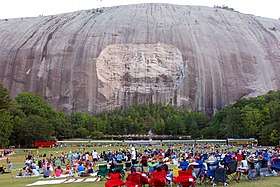
Paid for and owned by the state of Georgia. When Georgia purchased the site, "it was designated as a memorial to the Confederacy".[292] The Stone Mountain Park officially opened on April 14, 1965 – 100 years to the day after Lincoln's assassination.[293] Site of the rebirth of the Ku Klux Klan (the Second Clan), on the top of the mountain, with cross burning, in 1915. Stone Mountain was the location of an annual Labor Day cross-burning ceremony for the next 50 years.[294]
- Four flags of the Confederacy are flown.[295]
- The Stone Mountain Memorial Lawn "contains...thirteen terraces — one for each Confederate state.... Each terrace flies the flag that the state flew as member of the Confederacy."[296]
- Stone Mountain Confederate Memorial Carving, 1923-72, the largest such carving in the world.
Capitol
- CSA Gen. John Brown Gordon Memorial, Georgia State Capitol grounds. (1907, a year after the Atlanta Race Riot. "One of the leading proponents of both the New South creed and the Lost Cause, a philosophy that greatly romanticized the South's role in the war. Moreover, he is generally acknowledged as having been the head of the Ku Klux Klan in Georgia. Gordon defended slavery as 'morally, socially and politically right' and called the Klan 'a brotherhood of peaceable, law-abiding citizens.'"[297]
- Statue of Benjamin Harvey Hill, Confederate Senator, Georgia State Capitol.[296]
- Statue of Joe Brown and his wife. "Brown was the Confederate governor of Georgia and after the war served as [U.S.] senator. He also was an ardent secessionist who played on white fears of interracial mingling. After the war, Brown served briefly as chief justice of the Georgia Supreme Court and authored an opinion upholding the state's ban on interracial marriage that described such marriages as 'productive of evil, and evil only, without any corresponding good.'... That opinion was cited in several briefs in the Supreme Court's recent decision on gay marriage as an example of how government has consistently erred in defining marriage."[297]
- Painting of Hoke Smith, Governor and U.S. Senator. "Smith was a fiery white supremacist who was evangelical in his opinions. In 1911... Smith told The New York Times that blacks were not capable of governing themselves and claimed a half-century of freedom had hurt black farmers. 'Under slavery they were compelled to work and forced to learn within the limits of their capacity,' he said. 'Now there is no compulsion, and many of them neither work nor learn.'" As governor in 1906 "successfully pushed through a literacy test for voters and constitutional amendment known as the 'grandfather clause'".[297]
- Plaque and tree honoring William Ambrose Wright, a lieutenant in the Confederate States Army, and Georgia state comptroller for fifty years, as well as insurance commissioner. Erected by the Atlanta Ladies Memorial Association, January 19, 1930.[298]
Buildings
- Athens: Allen D. Candler Hall at the University of Georgia (1901)[299]
- Athens: Joseph E. Brown Hall at the University of Georgia (1932)[299]
- Augusta Canal National Historic Area, Georgia: includes Sibley Mill and Confederate States Powder Works (1862); rededicated 2010 when listed as National Historic Landmark.
Monuments
Courthouse monuments
- Blakely: Confederate Flagpole, Early County Courthouse (1861)[300]
- Butler: Taylor County Confederate Monument (1911)
- Cairo: Confederate Soldier Monument and Flag, Grady County Courthouse[301]
- Carnesville: Franklin County Confederate Monument (1910)
- Carrollton: Confederate Monument (1910)
- Cartersville: Confederate memorial at the Bartow County Courthouse
- Cedartown: Polk County Confederate Monument (1906)
- Clayton: Confederate Flag, Rabun County Courthouse[302]
- Conyers: Confederate Monument (1913)
- Covington: Confederate War Memorial (1906)
- Crawfordville: Confederate Monument (1898)
- Cusseta: Confederate Veterans Monument
- Decatur: DeKalb County Confederate Monument, Decatur Square, in front of Old DeKalb County Courthouse. The monument, erected 1911, antedates the Square and also antedates the Old Courthouse. Residents are petitioning for its removal.[296] The County Commission of DeKalb County voted 6-1 to ask its attorneys to find a legal way to remove or relocate it.[303]
- Douglasville: Confederate War Memorial (1914)
- Dublin: Laurens County Confederate Monument (1912)
- Eastman: Confederate Monument of Eastman (1910)
- Eatonton: Birthplace of Lucius Quintus Cincinnatus Lamar (1936)
- Ellaville: Schley County Confederate Monument (1910)
- Forsyth: Confederate Monument (1907)
- Greensboro: Greene County Confederate Monument (1898)
- Hartwell: Confederate Monument (1908)
- Hawkinsville: Confederate Monument (1908)
- Hazlehurst: Jefferson Davis Bust
- Hinesville: Liberty County Confederate Monument (1928)
- Jackson: Monument to Butts County Confederate Soldiers (1911)
- Jeffersonville: A shaft called Shannon's Meadow, in front of Twiggs County Courthouse.[304]
- Lawrenceville: Lawrenceville Confederate Memorial (1990)
- Lexington: Oglethorpe County Confederate Monument (1916)
- Lumpkin: Stewart County Confederate Monument (1908), included in Lumpkin Commercial Historic District[305]
- Macon: "Women of the South" (1911), UDC monument featuring a young soldier receiving aid from a mother and young girl, as well as a bas-relief showing both a pre-war family, and one devastated by war. Moved from city hall to a nearby park in 1934.[306]
- McDonough: Confederate Memorial Drinking Fountain (1915)
- Millen: Jenkins County Confederate Monument, Jenkins County Courthouse (1909)
- Monroe: Confederate Monument (1907)
- Moultrie: Colquitt County Confederate Monument, Colquitt County Courthouse (1909)
- Mount Vernon: Confederate Monument, Montgomery County Courthouse (1997)
- Nashville: Confederate Memorial, Berrien County Courthouse
- Newnan. Located at the original County Courthouse, now the Coweta County Probate Court.
- Coweta County Confederate Monument. Erected 1885 by the Ladies Memorial Association; cost $2,000. A uniformed Confederate soldier stands on picket duty, holding his musket by the barrel on his proper right side, the butt of which rests by his proper right foot. The soldier wears a hat and a short cloak over a knee-length jacket. Inscription: "Our Confederate dead, / whom power could not corrupt, / whom death could not terrify, / whom defeat could not dishonor. // (Back of base) It is not in mortals / to command success. / But they did more, deserved it."[307]
- Marker for Confederate Hospitals, on Courthouse Square. Text: "In Newnan between 1862 and 1865 were seven Confederate hospitals — Bragg, Buckner, "College Temple", "Coweta House," Foard, Gamble and Pinson's Springs. More than 10,000 Confederate sick and wounded and about 200 Federal soldiers wounded in the Battle of Brown's Mill were cared for in these hospitals and in private homes. The hospitals were directed and supervised by Samuel H. Stout, Army Medical Director Department of Tennessee. Loyal men and women of the county rendered valuable aid."[308]
- Ocilla: Irwin County Confederate Monument (1911)
- Oglethorpe: Confederate Monument, Courthouse lawn (1923)[27]:70 "Erected by the Oglethorpe Chapter of the UDC in 1924. It consists of a block of Ga marble flanked by marble globes surmounted by a third globe (surrounded by a fence), sits near the courthouse, date on monument is February 20, 1993, but newspaper establishes date of dedication as April 26, 1924. Originally, it was built with a fountain near an old artesian well in the intersection of highway 49 and Sumpter Street and moved to the present site around 1935."[304]
- Perry: Houston County Confederate Monument (1908)
- Quitman: Confederate memorial, Brooks County Courthouse
- Sparta: Hancock County Confederate Monument (1881)
- Statesboro: Confederate Memorial, Bulloch County Courthouse (1906)[309]
- Thomaston:
- At Arms Rest Monument, Upson County Courthouse (1908)[310]
- First Cannon Ball Monument, Upson County Courthouse (1919)[311]
- Thomson: McDuffie and Columbia Counties Confederate Monument, McDuffie County Courthouse (1986)[312]
- Toccoa: Stephens County Confederate Monument, county courthouse (1922)[313]
- Valdosta: Confederate memorial, Lowdnes County Courthouse (1911)[314]
- Vienna: Dooly County Confederate Monument, county courthouse (1908)[315]
- Warrenton: Warren County Confederate Monument, county courthouse (1904)[316]
- Washington: The Dissolution of the Confederate Government/Last Meeting Stone, Wilkes County Courthouse (1938)[317]
- Watkinsville: Confederate monument (1927); first erected in Watkinsville City Park[16]
- Wrightsville: Jefferson Davis Highway Marker located in front of the Johnson County Courthouse[318]
- Wrightsville - Confederate Soldier memorial by Sons of Confederate Veterans
Other public monuments
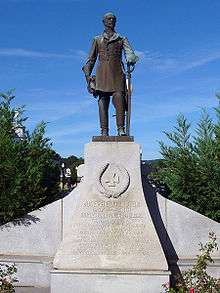
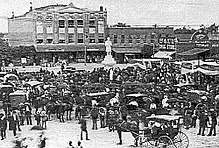
- Abbeville: Confederate Memorial Monument (1909)
- Americus: Confederate Monument (1900)
- Andersonville: Andersonville National Historic Site: Monument to Henry Wirz, Commander of the Confederate prison, Camp Sumter, at Andersonville, "where approximately thirteen thousand Union troops...died of disease, starvation, and exposure."[319] Erected by UDC in 1909.[320]
- Atlanta
- Jefferson Davis Highway Marker, on East College Avenue near South McDonough St. Marked U.D.C. (United Daughters of the Confederacy), June 12, 1931.[296]
- Eternal Flame of the Confederacy Monument (1939), a pre-Civil War gas streetlamp that was part of the Atlanta premiere of the film Gone with the Wind, now at the Atlanta History Center. Its plaque reads:
The Eternal Flame of the Confederacy
Lighted during the "Gone with the Wind" festivities, December 14, 1939 by the Old Guard Battalion of the Gate City Guard.
- The Gate City Guard was "a Confederate-era city militia".[296] The streetlamp was originally located at the corner of Alabama and Whitehall (now Peachtree) Streets, and was moved several times prior to its installation in Underground Atlanta. Redevelopment of that area led the city to want to remove it. Since it was valued at less than $500, the Georgia law controlling historic monuments did not apply.[296] The Atlanta History Center purchased the streetlamp for $10.[321]
- CSA Brig. Gen. Alfred Iverson Jr. Monument[322]
- Oakland Cemetery
- Confederate obelisk, inscribed "Our Confederate Dead 1873", in the Confederate section of the cemetery. Made of Stone Mountain granite, it is the tallest object in the Cemetery.[296]
- Lion of the Confederacy, also known as the Lion of Atlanta,[323] inscribed "Unknown Confederate Dead".[296] Created to memorialize "the lost cause".... "The Lion is actually a locally made copy of the Lion of Lucerne, a memorial to hundreds of Swiss Guards who died in the service of a much different but equally lost cause: defending the royal family in Paris during the French Revolution."[323] Mark Twain called it (the Lion of Lucerne) "the most mournful and moving piece of stone in the world."[323] "Carved by T. M. Brady, who owned the Georgia Marble Finishing Works in Canton." It is surrounded by "the remains of 3,000 unknown Confederate dead.... It was commissioned by the Atlanta Ladies Memorial Association and dedicated on Confederate Memorial Day in 1894."[323]
- Piedmont Park Peace Monument (1911), Allen George Newman, sculptor, inside the 14th Street gate. Features a winged goddess declaring "Cease Firing – Peace Is Proclaimed," to a Confederate soldier holding a rifle. Defaced by protestors after the Charlottesville Unite the Right rally, August 13, 2017.[324] A committee set up by then-Mayor Kasim Reed in 2017 recommended it be removed, but as of July, 2018, no action has been taken.[325]
- Rhodes Hall, formerly a private mansion, features a set of stained-glass windows entitled "The Rise and Fall of the Confederacy."[296]
- W.H.T. Walker Monument, on the spot where he was shot and killed by a Union sniper. At intersection of Wilkinson Drive and Glenwood Avenue.[296] One half mile to the west, at the intersection of Monument and McPherson Avenues, is a memorial erected by the U.S. Army for Major General John B. McPherson on the spot at which he was killed by Confederate forces on the same day (July 22, 1864, during the Battle of Atlanta).[296]
- Westview Cemetery Memorial. Markes the site of the Battle of Ezra Church. A soldier on an obelisk, above two small stone cannons and cannonballs. Inscribed "Nation shall not lift sword against nation" (Isaiah 2:4). Confederate flag flown, along with U.S. and Georgia flags.
- Augusta
- Augusta Confederate Monument. Commissioned by the Ladies Memorial Association in 1875, erected in 1878.[326] Life-size statues of Confederate Generals Robert E. Lee, Stonewall Jackson, T.R.R. Cobb and W.H.T. Walker surround the base of this monument.
- Four Southern Poets Monument, unveiled in April 1913. Commemorates Paul Hamilton Hayne (1830–1886), Sidney Lanier (1842–1881), James Ryder Randall (1839–1908), and Abram Joseph Ryan (1838–1886).[327] All four poets are associated with the Confederate States of America.
- Baxley: Confederate memorial
- Brunswick: Confederate memorial in Hanover Square[328]
- Calhoun: Confederate Soldier and Memorial Arch, 1927.[329]
- Canton: Confederate Memorial Arch, Brown Park, 1923.[330]
- Cochran: Bleckley County Confederate Monument, old Cochran City School, 1910.[331][332]
- Cockspur Island: Immortal Six Hundred at Fort Pulaski National Monument
- Columbus:
- Commerce: UDC monument (1941) in Spencer Park to women and veterans of the War Between the States. High school students sang Dixie at the dedication ceremony.[16]
- Cordele: Crisp County Confederate Monument, community clubhouse, 1911.[335]
- Crawfordville: Alexander H. Stephens statue (1893), A. H. Stephens Historic Park, Crawfordville[336]
- Cuthbert: Randolph County Confederate Monument, city park, 1910.[337]
- Dalton: Two memorials to CSA Gen. Joseph E. Johnston:
- Johnson statue (1912) in downtown Dalton. The UDC commissioned Belle Kinney to sculpt the bronze statue, in which Johnston is posed with "an expression of deep thought, with his sword resting at his feet". Kinney explained, "General Johnston, in command of an army vastly inferior in numbers to General Sherman's army, had to use his brains more than his sword; hence I made the sword subservient to the brain."[338]
- Memorial plaque at Johnston Headquarters, Huff House[339]
- Decatur: Lost Cause Confederate Memorial. Obelisk located behind Old DeKalb County Courthouse on Decatur Square. The monument has been defaced several times.[340] A petition is calling for its removal.[341] According to the DeKalb County Commission, part of the problem is that no one wants it. "The county has spent months trying to find takers for the monument. Officials purchased advertisements and cold called museums and parks."[342]
- Douglas: Confederate memorial, corner of Peterson Avenue (U.S. Route 441 southbound) and Ward Street (U.S. Route 221 Business westbound).
- Eatonton: Eatonton Confederate Monument, median in front of the Putnam County Courthouse, 1908.[343]
- Elberton:
- "Dutchy" (dedicated 1898; removed 1900; placed on display in Elberton 1982). Wanting to promote its granite industry and honor the Lost Cause, Elberton commissioned an Italian immigrant who "had clearly never seen a Confederate soldier" to sculpt a 3,000 lb (1,400 kg) granite monument. Unveiled in 1898, the sculpture had a cartoonish face, bulbous eyes, and appeared to be wearing a Union Army uniform. Nicknamed "Dutchy" because it looked like a cross between a Pennsylvania Dutchman and a hippopotamus, the monument was pulled down and buried where it fell in the town square in 1900. The sculpture was exhumed in 1982, run through a local car wash, and then placed on display in the Elberton Granite Museum, where it remains.[344][345]
- Elbert County Confederate Memorial (1898), Elberton Town Plaza[346]
- Fitzgerald: Jefferson Davis Monument, Jefferson Davis Memorial Historic Site, 1920.
- Fort Oglethorpe: Chickamauga & Chattanooga National Military Park. Numerous monuments and memorials to Confederate soldiers and units, as well as Union monuments.
- Franklin: Heard County Confederate Monument, Veterans Park, 1999.[347]
- Gainesville:
- Hall County Confederate Monument, town square, 1909.[348]
- A totem pole honoring local Confederate soldiers was erected in 1936 at Redwine Methodist Church. The monument no longer exists.[16]
- Statue of CSA General James Longstreet at his home[16]
- Gray: Memorial to soldiers in the War Between the States and the World War.
- Griffin: Confederate Monument, Veterans Memorial Plaza, 1909.[349]
- Hamilton: Memorial honoring Confederate dead.
- Hawkinsville: Confederate Sons of America memorial (Confederate States of America?)
- Jeffersonville: Confederate Memorial, across the street from the Twiggs County Courthouse, 1911.[350]
- Kingston: First Confederate Hospital of the Civil War, Main Street.[351]
- LaFayette: Walker County Confederate Monument, John B. Gordon Hall, 1909.[352][353]
- LaGrange: Monument to the Confederate Soldier, median, 1902.[354]
- Lincolnton: Lincoln County Confederate Monument, center of town.[355]
- Macon: Bibb County Confederate Monument, triangle park downtown, 1879.[356] Moved to present location in 1956.
- Madison: Morgan County Confederate Monument, Hill Park, 1909.[357]
- Marietta: Confederate memorial (1908), Marietta Confederate Cemetery[358]
- McDonough: Confederate Memorial, courthouse square, 1910[359]
- Milledgeville: Confederate Memorial Fountain, downtown median, erected by United Daughters of the Confederacy, 1912. 20 feet (6.1 m) fall. Originally across from Post Office and Courthouse; later moved to street in front of Georgia Military College. "On the front is 'CSA' and the furled battle flag with a broken shaft. Under the lion's head is a covered bowl. The soldier is standing with a gun. His heroism in the presence of the conquering foe was equaled only by his generosity to his fallen enemy. Reading around the monument, starting in the back it reads: '1861'; To the memory of the Confederate soldier who's [ sic ] game is as imperishable as the everlasting hills, who's courage is as unrivaled. Sing the dawn of civilization who's name shines in undying glory to the pages of history this monument is lovingly erected by the Robert E. Lee Chapter Daughters of the Confederacy of Milledgeville, Georgia. Unconquerable patriotism and – self-sacrifice rendered, adopted the effort of his enemies. After his flag had folded forever, to destroy his proud inheritance."[360]
- Montezuma: Macon County Confederate Monument, 1911.[361] "The first Macon County monument is currently located in Fannie Carmichael Park and faces east. It is a soldier with both hands on his grounded rifle. There are lion heads on each side. It was erected by the Phil Cook Chapter of the UDC in January 1911. The monument was moved in 1965 from the middle of Dooly Street in the middle of Montezuma."[304]
- Monticello: Jasper County Confederate Monument, City Square, 1910.[362] "To the Confederate soldiers of Jasper County, the record of whose sublime self sacrifice and undying devotion to duty, in the service of their country is the proud heritage of a local posterity."[83]
- Newnan: Stone monument to William Thomas Overby, called "Nathan Hale" of the Confederacy (1956). Erected 1956 by Alfred Colquitt and Newnan Chapters UDC. "[363]
- Resaca Confederate Cemetery
- Ringgold:
- Statue of CSA Gen. Patrick Cleburne
- "General" (1901), monument erected at the location where Confederate locomotive The General—stolen by Union Army soldiers in 1862—was finally stopped following the Great Locomotive Chase[364]
- Sandersville: "There is a large wooden large wooden cross on a three stepped stone base dedicated by the Ladies Memorial Association in the cemetery. It was intended to serve as a tribute to Confederate war dead until a marble memorial could be erected. Now, a marble obelisk dates from 1897 (the year the local UDC chapter came about) in the Sandersville cemetery."[304]
- Savannah:
- Colonel Francis S. Bartow Bust, Forsyth Park, 1902.[365][366]
- Confederate Monument, Forsyth Park, 1879 (To be officially renamed "Civil War Monument" in 2018)[17][365]
- General Lafayette McLaws Bust, Forsyth Park, 1902.[366]
- Silence, city-owned Laurel Grove Cemetery, 1875.[367]
- Springfield: Confederate Memorial, across from Effington County Courthouse, 1923.[368]
- Talbotton: Confederate memorial
- Tennille: "A Confederate monument was dedicated in April 1917 by the J.D. Franklin Chapter of the UDC. It originally stood in a park called the square in the middle of the town and was originally a fountain with bowls on four sides of an eight-foot shaft. The Confederate battle flag is incised on the shaft. It is currently located at the police station."
- Thomson: Monument to the Women of the Sixties, McDuffie County Chamber of Commerce, 1911.[369]
- Tifton: Tift County Confederate Memorial, Fulwood Park, 1910, rededicated 1992.[370]
- Trenton: Confederate Memorial in Veterans Park next to the town square.
- Union Point:
- Waynesboro: Confederate Memorial Cemetery, burial site of 49 Confederate soldiers[373]
- Waynesville: Confederate Soldiers Park[374]
- Waycross: Ware County Confederate, Phoenix Park, 1910.[375]
Private monuments
- Albany: Confederate Memorial Park, owned and maintained by SCV and UDC.
- Augusta: Confederate Monument at St. James United Methodist Church.[376] (No longer there as of 2017, according to street view)
- Cordele: A retired Titan I intercontinental ballistic missile standing upright next to an interstate highway is entitled "Confederate Air Force Pad #1", commemorating Georgia's role in the Civil War. Erected 1969.[377] It is a tourist attraction and was dubbed "Confederate Air Force Pad #1" by a representative of Cape Kennedy (now Kennedy Space Center or Cape Canaveral).[378]
- Rome: Confederate monuments at Myrtle Hill Cemetery include:
- Nathan Bedford Forrest Monument (1909), UDC Monument[379]
- Women of the Confederacy Monument, "erected by the Floyd County Camp of Sons of Confederate Veterans, March 9, 1910." Dedicated by Theodore Roosevelt.[379]
Gallery
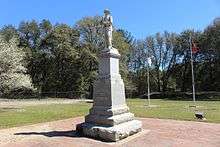 Confederate Memorial Park, Albany
Confederate Memorial Park, Albany Nuclear missile - a roadside attraction named "Confederate Air Force Pad No. 1", Cordele, Georgia[380]
Nuclear missile - a roadside attraction named "Confederate Air Force Pad No. 1", Cordele, Georgia[380]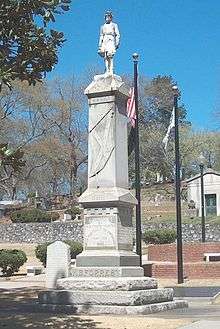 Nathan Bedford Forrest Monument, Myrtle Hill Cemetery, Rome
Nathan Bedford Forrest Monument, Myrtle Hill Cemetery, Rome
Inhabited places
- Bartow, renamed for Francis S. Bartow in 1861.
- Bartow County, named for CSA Gen. Francis S. Bartow.
- Ben Hill County, named for CSA Sen. Benjamin Harvey Hill.
- Bleckley County, named for Logan Edwin Bleckley.
- Cook County, named for CSA Brig. Gen. Philip Cook.
- Jeff Davis County, named for CSA President Jefferson Davis.
- Lamar County, named for Lucius Quintus Cincinnatus Lamar II.
- Stephens County, named for Alexander H. Stephens, Vice President of the Confederate States of America.
- Toombs County, named for Robert Toombs, first Sec. of State of the Confederate States of America.
- Wheeler County, named for CSA Gen. Joseph Wheeler.
Parks
- Catoosa County: monument (1977) to Confederate Gen. Bushrod Johnson, located within Chickamauga and Chattanooga National Military Park.[381]
- Cobb County: Kennesaw Mountain National Battlefield Park, tribute to 14 generals from Georgia (1917)
- Fitzgerald: Jefferson Davis Memorial Historic Site (1920)
Public works
- Muscogee: Stonewall Jackson Dam
Roads
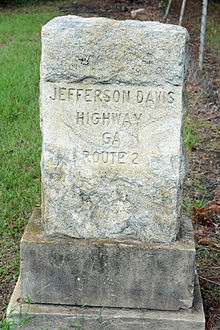
- Andersonville: Robert E. Lee Street
- Atlanta:
- Bell Street, possibly named for Confederate congressman Hiram Parks Bell[382]
- Confederate Avenue and East Confederate Avenue. After calls for their renaming,[383][325] residents of the streets and their neighborhoods chose "United Avenue" as the new name.[384] As of September 27, 2018, not yet approved by the city council.[382]
- Confederate Court
- Gordon Place, named for Confederate general John B. Gordon
- Memorial Drive, links downtown Atlanta with the Confederate Memorial at Stone Mountain
- Walker Street, named for Confederate general James George Walker
- Augusta: Wheeler Road
- Brunswick: General Robert E. Lee Road
- Buford: General Lee Way
- Columbus: Robert E. Lee Drive
- Dallas: Confederate Avenue
- Eastman: Jefferson Davis Memorial Road
- Fayetteville: Jeff Davis Drive
- Fitzgerald:[note 2]
- Bragg Street
- Gordon Street
- Hill Street
- Jackson Street
- Jeff Davis Park Road
- Lee Street[5]
- Logan Street
- Longstreet Street
- Thomas Street
- Forest Park:
- Hood Avenue
- Wheeler Drive
- Fort Oglethorpe:
- Forrest Road
- Polk Circle
- Robert E. Lee Street
- Shelby Street
- Franklin: Jeff Davis Road
- Gainesville: Longstreet Bridge
- Greensboro: Jefferson Davis Road
- Hazlehurst: Jeff Davis Street
- Jonesboro:
- Jeb Stuart Drive
- Jeff Davis Drive
- Robert E. Lee Parkway
- Stonewall Jackson Drive
- Kennesaw: Dreux Court, named for Confederate Colonel Charles Didier Dreux
- LaGrange: Ben Hill Street
- Lyons: Jeff Davis Avenue
- Macon:
- General Lee Road
- Jeff Davis Street
- Newnan:
- General Lee Drive
- General Longstreet Line
- Jeb Stuart Drive
- Ringgold: Robert E. Lee Drive
- Savannah:
- Sharpsburg:
- Bedford Forrest Drive
- Thomas Overby Drive
- Stone Mountain:
- Jefferson Davis Drive
- Robert E. Lee Boulevard
- Stonewall Jackson Drive
- John B. Gordon Drive
- Thomaston: Jeff Davis Road
- Thomasville: John B. Gordon Spur
- Warner Robins: General Lee Road
- Washington: Robert Toombs Avenue
- Waycross:
- Jeb Stuart Drive
- Stonewall Jackson Place
Schools
- Atlanta:
- Joseph E. Brown Middle School
- A granite memorial to the Confederacy is in front of E. Rivers Elementary School[325]
- Hazlehurst: Jeff Davis Elementary, High School, Middle School, and Primary School.
- Thomaston: Robert E. Lee High School (Thomaston, Georgia)
- Trenton: Davis Elementary School
City symbols
- Trenton, Georgia: City council was upset the State's 1956 flag was being changed. Faced with the threat of a funding cut if they refused to fly the 2001 State flag, the city adopted a modified 1956 flag complete with the Confederate Battle Flag as their city flag in 2002. When the new mayor removed the city flag in 2004, objections were raised by the Sons of Confederate Veterans and a 2005 referendum confirmed the flag 278–64.[385]
Photos
 Augusta
Augusta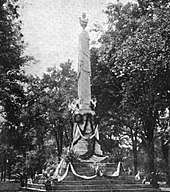 Columbus
Columbus Savannah
Savannah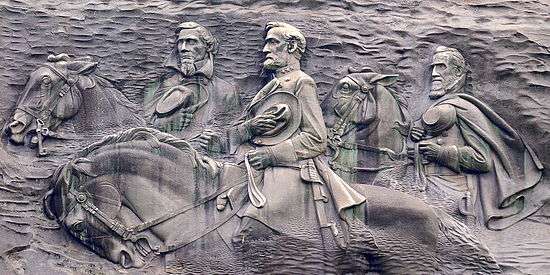 Stone Mountain
Stone Mountain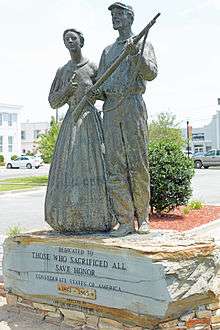 Baxley
Baxley- Nashville
- Irwin County
 Fort Pulaski (Immortal Six Hundred)
Fort Pulaski (Immortal Six Hundred)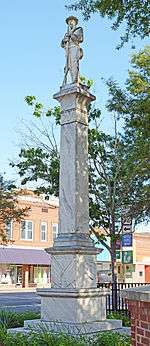 Douglas
Douglas Jeffersonville
Jeffersonville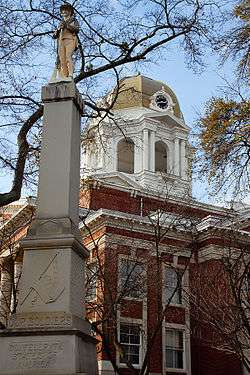 Cartersville
Cartersville- Hawkinsville
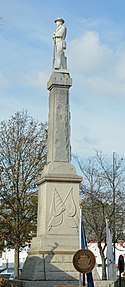 McDonough
McDonough Hinesville
Hinesville Dublin
Dublin Eastman
Eastman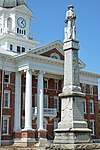 Millen
Millen Valdosta
Valdosta Waycross
Waycross- Butler
- Talbotton
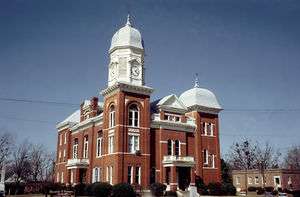 Crawfordville
Crawfordville- Thomaston
- Thomaston
- Oglethorpe
.jpg) Gray
Gray.jpg) Mount Vernon
Mount Vernon Quitman
Quitman Statesboro
Statesboro Patrick R. Cleburne statue, Ringgold
Patrick R. Cleburne statue, Ringgold.jpg) Kennesaw Mountain – 14 generals
Kennesaw Mountain – 14 generals- Hamilton
 Brunswick
Brunswick Montezuma
Montezuma%2C_Waynesville%2C_GA%2C_US.jpg) Waynesville
Waynesville Lumpkin
Lumpkin Wrightsville
Wrightsville
Hawaii
- A plaque in the National Memorial Cemetery of the Pacific commemorates Hawaiians who fought for the Confederacy, as well as Hawaiians who fought for the Union.
Idaho
There are several places named for the Confederacy in Idaho.[5] The settlement of Idaho coincided with the Civil War and settlers from Southern states memorialized the Confederacy with the names of several towns and natural features.[386][387][388]
Inhabited places
- Atlanta: unincorporated, and its Atlanta Airport. The area was named by Southerners after reports of a Confederate victory over Gen. Sherman in the Battle of Atlanta, which turned to be wholly false, but the name stuck.
- Confederate Gulch: unincorporated former mining community[389][388]
- Grayback Gulch: unincorporated former mining community, settled by Confederate soldiers and named for the color of their uniforms. Now a government campground[390]
- Leesburg: an unincorporated former goldmining town settled by southerners and named for Robert E. Lee.[391]
Natural features and recreation
- Elmore County: located within Boise National Forest are:
- Robert E. Lee Campground[392]
- Robert E Lee Creek[393]
Illinois

The only memorials in Illinois are in cemeteries and connected with prisoners of war.
Federal cemeteries
- Alton: UDC monument (1909), North Alton Confederate Cemetery. Dedicated to Confederate soldiers who died at Alton Military Prison[394]
- Rock Island: UDC obelisk (2003), Rock Island Confederate Cemetery. Dedicated to Confederate soldiers who died at Rock Island Military Prison[395]
- Springfield: UDC/SCV monument (2005), Camp Butler National Cemetery. Dedicated to Confederate soldiers who died at Camp Butler.[396]
Federal plot within private cemetery
- Chicago: Confederate Mound (1895), Oak Woods Cemetery. Mass grave and monument dedicated to Confederate soldiers who died at Camp Douglas.[397]
Indiana
- Corydon: Corydon Battle Site is a memorial to both sides that fought in the Civil War Battle of Corydon.
- Evansville: The Confederate monument (1904) at Oak Hill Cemetery marks the burial site of 24 Confederate prisoners who died at Evansville.[398]
- Indianapolis:
- Confederate Soldiers and Sailors Monument, Garfield Park,[399] erected, according to its inscription, "to mark the burial place of 1616 Confederate soldiers and sailors who died here as prisoners of war and whose graves cannot now be identified." Plans to remove it have been announced.[400] As of August, 2018, it is still in place; "Parks Department spokeswoman Ronnetta Spalding says that finding a new spot to move it to has proven difficult." The plans to move it have not been abandoned.[401]
She tells WRTV-TV that the department hasn't ruled out moving the monument
- A granite monument was erected in 1933 at Crown Hill National Cemetery, a burial site for Confederate prisoners who died at Camp Morton[402]
- Terre Haute: Woodlawn Monument Site (1912), Woodlawn Cemetery. Erected by the Federal Government to commemorate 11 Confederate soldiers who died in a local prison camp.[403]
Iowa
There are at least three public spaces with Confederate monuments in Iowa.[5]
- Bentonsport: Monument to Lawrence Sullivan Ross (2007), Iowa's only Confederate general[404]
- Bloomfield:[404]
- Confederate Invasion of Iowa Monument (2005)
Kansas
There is one public space dedicated to the Confederacy in Kansas.[5]
- Humboldt: Confederate Soldier Shot Historical Marker. The marker sits at the site of where the Union Flag was flying in Humboldt, Kansas, when a Confederate Soldier attempted to chop down the Union flag pole. The Confederate Soldier was shot as he tried to remove the flag. The marker is less of a monument to the Confederacy, and more of a historical marker describing the events when Humboldt was raided by Confederate Captains John Mathews and his friend Tom Livingston; they led other white Confederate proslavers, Southern-sympathizing Indians, and Missouri bushwhackers seeking fugitive slaves from Missouri who were hiding in Humboldt.[405]
Kentucky
There are at least 56 public spaces with Confederate monuments in Kentucky.[5]
Capitol
Monuments


- Augusta: Confederate Monument, Payne Cemetery, 1903.
- Bardstown: Confederate Monument, Bardstown/St. Joseph's Cemetery, 1903.
- Bowling Green:
- Confederate Monument of Bowling Green, Fairview Cemetery, 1876.
- William F. Perry Monument, Fairview Cemetery, 1901.
- Brandenburg: Confederate monument (2016) removed from Louisville[409]
- Cadiz: Confederate Monument, Trigg County Courthouse, 1913.[410]
- Covington: Veteran's Monument, Linden Grove Cemetery, 1933. It was dedicated by the American Legion and honors both Confederate and Union veterans.
- Crab Orchard: Confederate Monument, Crab Orchard Cemetery, 1872.
- Cynthiana: Confederate Monument, Battle Grove Cemetery, 1869.
- Danville: Confederate Monument, McDowell Park, 1910.[411]
- Eminence: Confederate Soldiers Martyrs Monument, Eminence Cemetery, 1870.
- Fairview: Confederate monument at the Jefferson Davis Monument State Historic Site, a state park commemorating Davis's birthplace, completed in 1924. It contains a "35-story obelisk."[412]
- Frankfort: Confederate Monument, Frankfort Cemetery, 1892.
- Fulton: Confederate Monument, Fairview Cemetery, 1902.
- Georgetown: Confederate Monument, Georgetown Cemetery, 1888.[413]
- Graves County: Camp Beauregard Memorial (1909), Camp Beauregard Cemetery. UDC memorial to Confederate soldiers who died at Camp Beauregard "for the Confederate State of America and were denied the glory of heroic service in a battle".[414]
- Glasgow: Confederate Monument, Barren County Courthouse, 1905.
- Harrodsburg: Confederate Monument, Spring Hill Cemetery, 1902.
- Hickman: Confederate Memorial Gateway, Hickman City Cemetery, 1913.
- Hopkinsville:
- Confederate Memorial Fountain, Christian County Courthouse, 1911.
- Latham Confederate Monument, Riverside Cemetery, 1887.
- Horse Cave: Unknown Confederate Soldier Monument, Old Dixie Highway, 1934.
- Jeffersontown: Confederate Martyrs Monument, Jeffersontown City Cemetery, 1904.
- Lawrenceburg: Confederate Monument, Anderson County Courthouse, 1894.
- Lexington:
- Louisville:
- John B. Castleman Monument, Cherokee Triangle, 1882. On the night of August 12–13, 2017, the statue and the historical marker near it were disfigured with red paint.[415]
- Confederate Monument, dedicated in 1895 and was placed next to the University of Louisville on city property. It was removed and re-located to a riverfront park in Brandenburg, Kentucky in December 2016.[416]
- Madisonville: Confederate Monument, Hopkins County Courthouse, 1909.[417]
- Mayfield:
- Confederate Monument, Graves County Courthouse, 1920.
- Confederate Monument, Maplewood Cemetery, 1924.
- Midway: Martyrs Monument, Midway City Cemetery, 1890.
- Morganfield: Confederate Monument, City Cemetery/Odd Fellows Cemetery, 1870.
- Morgantown: Confederate-Union Veterans' Monument, Butler County Courthouse, 1907.
- Mt. Sterling: Confederate Monument, Machpelan Cemetery, 1880.
- Munfordville: Colonel Robert A. Smith Monument, near the Green River, 1885.
- Murray: Confederate Monument, Calloway County Courthouse, 1917.
- Nancy: General Felix K. Zollicoffer Monument, Zollicoffer Park, Mill Springs Battlefield, 1910.
- Nancy: Confederate Mass Grave Monument, Zollicoffer Park, Mill Springs Battlefield, 1910.
- Nicholasville: Confederate Memorial, Jessamine County Courthouse, 1896.[418]
- Owensboro: Confederate Monument, Daviess County Courthouse, 1900.
- Owingsville: Confederate Monument, Owingsville Cemetery, 1907.
- Paducah:
- Confederate Monument, Oak Grove Cemetery, 1907.[419]
- First Confederate Volunteer From Paducah, marker embedded in city sidewalk.[419]
- General Lloyd Tilghman Statue, Lang Park, 1909.[419]
- Paris: Bourbon County Confederate Monument, Paris Cemetery, 1887.
- Perryville:
- Confederate Monument, Perryville Battlefield State Historic Site, 1902. Commissioned by the state of Kentucky.[420]
- Unknown Confederate Dead Monument, Goodknight Cemetery, 1928.[420]
- Pewee Valley: Pewee Valley Confederate Monument, Pewee Valley Confederate Cemetery, 1904.
- Princeton: Confederate Soldier Monument, Caldwell County Courthouse, 1912.[421]
- Russellville: Confederate Monument, Town Square, 1910.
- Somerset:
- Battle of Dutton's Hill Monument, Old Crab Orchard Road, 1875.[422]
- St. Joseph: Thompson and Powell Martyrs Monument, St. Alphonsus Catholic Church Cemetery, 1880.[423]
- Versailles: Confederate Monument, Versailles Cemetery, 1877.
Gallery
Inhabited places
- Breckinridge Center: a census-designated place in Union County, Kentucky. Named because of nearby Camp Breckinridge, which was named for John C. Breckinridge, U.S. Vice President and Confederate general.
- Lee County (1870)
- Confederate, Kentucky
Parks
- Fairview: Jefferson Davis State Historic Site (1957) the site includes Davis's birthplace, a memorial to Davis that includes a 341 ft obelisk (the second tallest obelisk in the world after the Washington Monument), Confederate flags and other signs and plaques.[424]
Roads
- Elkton:
- Jefferson Davis Highway
- Jefferson Davis Road
- Erlanger:
- General Ross Drive
- General Stuart Drive
- Jefferson Davis Place
- Robert E. Lee Drive
- Madisonville: Jefferson Davis Drive
- Mayfield: Jeff Davis Road
- Raywick: Robert Lee Road
- Vine Grove: Stand Watie Road
Highways
- Jefferson Davis Memorial Highway: Marker located in the Fountain Avenue median in Paducah, 1935. The marker is along an auxiliary route that follows U.S. Route 68 from Bowling Green, Kentucky to Paducah, Kentucky.[419]
Schools
- Eastern: Allen Central High School: Allen Central athletic teams are nicknamed the "Rebels." The school features various Confederate iconography[425]
- Richmond: Eastern Kentucky University. EKU athletic teams are nicknamed the "Colonels," a Confederate figure.[426]
Former
- Florence: Boone County High School. The mascot for the school was Mr. Rebel, a Confederate general who stands tall in a light blue uniform, feathered cap, and English mustache. It was removed in 2017.[427]
- Lexington:
- John C. Breckinridge Memorial, Fayette County Courthouse, 1887.[428] In November 2015, a committee, the Urban County Arts Review Board, voted to recommend removal of both the John Hunt Morgan Memorial and the John C. Breckinridge Memorial.[428] They were removed October 17, 2017.[429]
- John Hunt Morgan Memorial, Fayette County Courthouse, 1911.[428] Removed October 17, 2017 [429]
Louisiana
There are at least 91 public spaces with Confederate monuments in Louisiana.[5]
State Capitol
- Gov. Francis T. Nicholls Statue (1934). Nicholls was a Brigadier General in the Confederate Army.
- Gov. Henry Watkins Allen Statue (1934). Allen was a Brigadier General in the Confederate Army. He is buried on the Old Louisiana State Capitol grounds.
- "Silent Sentinel" Monument, officially the Confederate Soldiers of East and West Baton Rouge Parishes Memorial. Plinth erected 1886 and statue in 1890. Dedicated by Gov. John McEnery. Original granite and marble plinth cracked; replaced in the 1960s with a small brick plinth that was aesthetically unappealing. Formerly at North Boulevard and 3rd Street, near City Hall. In 2012, to make room for Town Square construction, it was moved to the nearby Old Louisiana State Capitol, now a museum.[430] Plaque reads: "Erected by the men and women of East and West Baton Rouge to perpetuate the heroism and patriotic devotion of the noble soldiers from the two parishes who wore the gray and crossed the river with their immortal leaders to rest under the shade of the trees. Original monument erected 1886 A.D."
Buildings
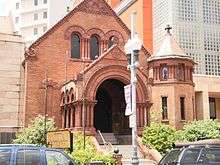
- Baton Rouge: Edmund Kirby Smith Hall at Building Louisiana State University (1965/ 2011). In 2017 "slated for demolition".[430]
- Thibodaux: P.G.T. Beauregard Hall at Nicholls State University (1961/ 2010). The school is named for Confederate General and later Governor Francis T. Nicholls.
- New Orleans:
- Gibson Hall at Tulane University (1894), named for Randall L. Gibson
- Confederate Memorial Hall (1891), the oldest museum in Louisiana[431]
Monuments
Courthouse monuments
- Alexandria: Rapides Parish Confederate Monument (1914)
- Benton: Confederate Soldier Monument (1910)
- East Feliciana Parish – Confederate Soldiers Monument in Front of the East Feliciana Courthouse Clinton Louisiana[432]
- Franklin: Confederate Monument (1913)
- Lake Charles: South's Defenders Monument (1915)
- Opelousas: Confederate Monument (1920)
- Port Allen: Henry Watkins Allen Statue (1962)
- Shreveport: Confederate Monument, on grounds of the Caddo Parish courthouse, dedicated in 1906 by UDC, NRHP-listed.[433] The Caddo Parish Commission voted to remove it; a legal challenge by the UDC was unsuccessful.[434]
- St. Francisville: Confederate Monument (1903). Has Confederate flag above the inscription: "In memory of West Feliciana's Confederate dead, wherever at rest. Co. C 1st Regt. La. Cavalry".
- Tallulah: Confederate Monument (1912)
- Winnfield: Confederate Monument (1926)
Other public monuments

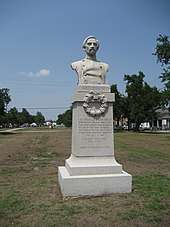
- Baton Rouge:
- Breckinridge's March Monument (1931)
- Confederate Monument (1886)
- Jefferson Davis Highway Monument
- Belle Chasse: Judah P. Benjamin Monument (1968)
- Clinton: Confederate Monument (1909)
- DeSoto Parish: monuments commemorating the Battle of Pleasant Hill include:
- Lieutenant Gen. Richard Taylor memorial (1994) outside Pleasant Hill American Legion Hall[435]
- Red River Campaign memorial (1994)[436]
- UDC Confederate memorial[437]
- Donaldsonville: Fort Butler Memorial (1999)
- Gretna: Jefferson Davis Highway Marker
- Homer: Confederate Monument (1940)
- Johnson Bayou: Robert E. L Statue (1984)
- Lafayette: Brig. Gen. J.J. Alfred A. Mouton Statue (1922). There has been considerable local discussion about what to do with the monument.[438][439]
- Marthaville: Unknown Confederate Soldier Monument (1970)
- Minden: Confederate Monument (1933)
- New Orleans:
- Confederate Monument (1874), Greenwood Cemetery[440]
- Army of Tennessee Tomb (1886) at Metairie Cemetery, consisting of a Gothic chapel tomb containing 48 vaults, surmounted by an equestrian statue of Albert Sidney Johnston. A marble statue near the tomb's entrance shows a Confederate sergeant calling the roll. Johnston, P. G. T. Beauregard, and other Confederate soldiers are entombed there.[441]
- Monument to Confederate Colonel Charles Didier Dreux, first Confederate officer killed in action. At intersection of South Jefferson Davis Parkway and Canal Street, across from former location of Jefferson Davis Monument.[442]
- Monument to Catholic priest Abram J. Ryan, called poet-priest of the Confederacy. At South Jefferson Davis Parkway and Banks Street. Erected in 1949 by the United Daughters of the Confederacy.[442]
- Monument to General Albert Pike, at South Jefferson Davis Parkway and Tulane Avenue. Erected 1957. Defaced with "Black Lives Matter" in 2015.[442]
- Plaquemine: Confederate Memorial (1914)
- Shreveport: Fort Humbug Confederate Memorial (1927)
- Tangipahoa Parish: Confederate monument (1907) at Camp Moore, a museum and former Confederate training camp[443]
- Zachary: Port Hudson Confederate Monument (1930)
Inhabited places
- Allen Parish. Named after Henry Watkins Allen, Confederate General and Governor of Louisiana during the Confederacy.
- Allendale, a neighborhood in Shreveport, where Allen lived.
- Beauregard Parish (1913)
- Jefferson Davis Parish (1912)
- Village of Longstreet (unincorporated)
- City of Stonewall (named 1862, incorporated 1972)
- City of Slidell, named for John Slidell, Confederate ambassador to France.
Parks
- Marthaville: Rebel State Historic Site (1962)
Roads
- Baton Rouge:
- Confederate Avenue
- Jeff Davis Street
- Lee Drive[5]
- Bell City: Jeff Davis Road
- Bogalusa: Jefferson Davis Drive
- Bossier City
- General Bragg Drive
- General Ewell Drive
- General Polk Drive
- General Sterling Price Drive
- Jeb Stuart Drive
- Kirby Smith Drive
- Longstreet Place
- Robert E. Lee Boulevard
- Robert E. Lee Street
- Chalmette: Beauregard Street
- Gretna: Beauregard Drive
- Houma: Jefferson Davis Street
- Lafayette: Jeff Davis Drive
- Lake Charles:
- Beauregard Drive
- Beauregard Avenue
- Beauregard Street
- Merryville: Robert E. Lee Road
- Monroe: Jefferson Davis Drive
- New Orleans
- Beauregard Drive
- Dreux Avenue, named for Confederate General Charles Didier Dreux
- Gayarre Place, named for Charles Gayarré, white supremacist and financial supporter of the Confederacy. Clio, muse or goddess of history, is on a monument. (Gayarré was a historian.) The monument was paid for by George Hacker Dunbar, an artilleryman during the Civil War, married to a niece of General Beauregard. The original statue was replaced in 1938, after vandals damaged it.[444]
- Governor Nicholls Street
- Jefferson Davis Parkway. Originally named Hagan Avenue; name changed in 1911 to coincide with the unveiling of the Jefferson Davis Monument.[442]
- Lee Circle[5]
- Polk Street
- Robert E. Lee Boulevard
- Slidell Street
- Pineville:
- Jefferson Davis Drive
- Longstreet Drive
- Rayne: Jeff Davis Avenue
Schools
- Baton Rouge: Lee Magnet High School, formerly Robert E. Lee High School, on Lee Drive.[430]
- De Ridder:
- Beauregard Alternative School
- East Beauregard Elementary School (2001)
- De Ridder: East Beauregard High School (1962)
- Monroe: Robert E. Lee Junior High School
- Longville:
- South Beauregard Elementary School
- South Beauregard High School
- Louisiana State University is home of the LSU Tigers (1896) and Lady Tigers teams also known as the Fighting Tigers named for the Louisiana Tigers, several Confederate Civil War regiments.[445][446]
- Saint Bernard: P.G.T. Beauregard Middle School (closed)[447]
- Thibodaux: Nicholls State University (1948), named for CSA Brig. Gen. Francis Redding Tillou Nicholls. The school's mascot, Colonel Tillou, is also named for Nicholls.[448]
Confederate flag display
- Baton Rouge: The Stars and Bars Confederate flag and the Bonnie Blue Flag are flown behind City Hall, along with the Flag of Louisiana.[430]
Maryland


State symbols
- Flag of Maryland (1904). The state flag of Maryland features the red-and-white Crossland Banner, the unofficial state flag of Maryland used by secessionists and Confederates during the American Civil War.[449][450][451][452] The current state flag started appearing after the Civil War as a form of reconciliation. The flag became official in 1904.
|
- The state song "Maryland, My Maryland" calls on the state to join the Confederacy.[453] As of 2018, the Maryland General Assembly has eight times taken up the question of the state song, without enacting any change. In 2017, the Mighty Sound of Maryland, the marching band of the University of Maryland at College Park, stopped playing the song.[454]
Monuments
Public monuments
- Baltimore: Confederate monuments at Loudon Park National Cemetery include:
- The Confederate Soldier (1874)[455]
- Fort McHenry Monument (1912), dedicated to Confederate soldiers who died at Fort McHenry, when it was a prisoners-of-war camp.[456]
- Charlotte Hall: UDC monument (1993) to CSA Rear Admiral Raphael Semmes[457]
- Easton: "Talbot Boys" Monument (1914), Talbot County Courthouse[458] A statue of Frederick Douglass was added in 2011. "The county council approved it after months of debate and stipulated it could not exceed the height of the Confederate statue it parallels."[459]
- St. Mary's County: Confederate Soldiers and Sailors Monument (1876), and Point Lookout Confederate Cemetery Monument (1910), located at Point Lookout Confederate Cemetery.[460]
- Washington County:
- Robert E. Lee Statue at Antietam Creek, Antietam National Battlefield (2003)[461]
- Samuel Garland, Jr. Monument (1993)[462]
Private monuments
- Beallsville: Memorial to Confederate soldiers at Monocacy Cemetery (1911; replaced 1975).[463]
- Frederick: Monument to the Unknown Confederate Soldiers (1881), Mount Olivet Cemetery[464]
- Silver Spring: Confederate Monument, Grace Episcopal Church Cemetery, 1896. Commemorates the death and burial of 17 unknown Confederate Soldiers who died at the Battle of Fort Stevens. The monument, a stone obelisk, can be seen from Georgia Ave.[465][466]
Inhabited places
- Confederate Hills: A residential community near Antietam National Battlefield where the streets are all named after Confederate generals, including: Longstreet Circle, General Anderson Court, General Branch Court, General Gordon Circle, General Hill Circle, General Lee Drive, General Stonewall Jackson Circle, and General Stuart Court.[467][468]
Roads
- Potomac:
- Jubal Early Court
- J. E. B. Stuart Road
Ferry
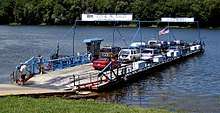
- Montgomery County: A passenger and vehicle ferry, Gen. Jubal A. Early (1954), connects Montgomery County, Maryland and Loudoun County, Virginia. Owned by White's Ferry and named for Confederate General Jubal Early, it is the only ferry still in operation on the Potomac River.[469]
Gallery
- Point Lookout Confederate Cemetery Monument (center) and Confederate Soldiers and Sailors Monument
 Samuel Garland, Jr. Monument
Samuel Garland, Jr. Monument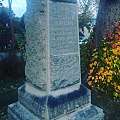 Confederate Memorial in Silver Spring to 17 unknown soldiers buried at Grace Episcopal Church Cemetery after the Battle of Fort Stevens
Confederate Memorial in Silver Spring to 17 unknown soldiers buried at Grace Episcopal Church Cemetery after the Battle of Fort Stevens
Massachusetts
There are no public spaces dedicated to the Confederacy in Massachusetts.[5]
Private memorials
- Cambridge
- Memorial Hall, Harvard University. Stained-glass windows to commemorate various figures, among them:
- Honor and Peace Window (1900). There is no inscription, but a Harvard University page () explaining the windows says: "This window commemorates those who surrendered their lives in the War of the Rebellion." Portrays two warriors, one with sword high in triumph, one kneeling in defeat, who from the ribbons can be seen to be from different but related countries.
- Student and Soldier Window (1889). Soldier wears gray uniform.
- Memorial Hall, Harvard University. Stained-glass windows to commemorate various figures, among them:
Mississippi
There are at least 131 public spaces with Confederate monuments in Mississippi.[5]
State capitol
- Confederate Monument, Mississippi Department of Archives and History Building, dedicated June 1891.[470][471][472] In front of the Old Capitol Museum. Unusual in that a former slave and Republican member of the legislature, John F. Harris, spoke passionately in favor of it, while some whites spoke against it. "Every colored member voted 'Aye'."[472]
- Women of the Confederacy Monument (1917), on south side of Capitol grounds. Cost was $20,000, sculpted by Belle Marshall Kinney. "The monument features two female figures and one male figure, a wounded and dying soldier. To the left of the soldier, a sympathetic woman is presenting a palm of glory to the soldier, a symbol of triumph even in death. Above both the soldier and the woman stands 'Fame'. She, in turn, is placing a wreath on the head of the woman in recognition of her contribution to the Confederate cause. Below the bronze figures are four inscriptions facing each direction, and dedicated to 'our' mothers, daughters, sisters and wives. On the southern face, which is the front of the monument, is a quote from Jefferson Davis which, among other virtues, praises the women 'whose pious ministrations to our wounded soldiers soothed the last hours of those who died far from the objects of their tenderest love.'"[473]
State symbols
- The flag of Mississippi (1894) features the Confederate Battle Flag[73]
|
- Various state insignia incorporate the state flag
- Mississippi National Guard seal features the Flag of Mississippi (incorporating the Confederate Battle Flag) flying over a soldier at attention.
- "Several city and county governments and all eight of Mississippi's public universities have stopped flying the state flag in recent years amid critics' concerns that it does not properly represent a state where 38 percent of residents are African-American."[474]
State holidays
- Robert E. Lee Birthday, celebrated with Martin Luther King, Jr. Day on the third Monday of January[475]
- Confederate Memorial Day, celebrated the last Monday of April[475]
Buildings
- Greenwood: Confederate Memorial Building
- Hattiesburg: Jefferson Davis Hall at Pearl River Community College
- Oxford: Lamar Hall (1977) at University of Mississippi see schools below
Monuments
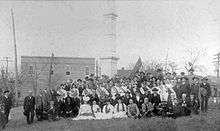
Courthouse monuments
- Brandon: Rankin County Confederate Monument (1907)[30]
- Carrollton: Confederate Monument and flag, Carroll County Courthouse (1905)[476][477]
- Charleston: Confederate Monument
- Cleveland: Confederate Monument (1908) by the Bolivar Troop Chapter of UDC, Bolivar County
- Columbus: Lowndes County Confederate Monument (1912)
- Corinth: Col. William P. Rogers statue (1895, moved to grounds of Alcorn County courthouse 1920)[478]
- De Kalb: Confederate Monument on courthouse grounds[479]
- Ellisville: Jones County Courthouse and Confederate Monument
- Greenville: Confederate Monument (1909), erected by United Daughters of the Confederacy. One face: "For those who encountered the perils of war in the defense of the sacred cause of states rights and constitutional government. // Jefferson Davis." Another side: "The sublimest word in the English language is duty. // Robert E. Lee // No brave battle for truth and right was ever fought in vain. // Randolph H. M'Kim." Another side: "It is due the truth of history that the fundamental principles for which our fathers contended should be often reiterated in order that the purpose which inspired them may be correctly estimated and the purity of their motives be abundantly vindicated. // Charles B. Galloway"
- Greenwood: Confederate Monument (1913)
- Gulfport: Confederate Monument (1911) by UDC and Board of Supervisors of Harrison County
- Hattiesburg: Confederate Memorial (1920) by UDC
- Hazlehurst: Confederate Monument (1917)
- Kosciusko: Attala County Courthouse and Confederate Monument (1911)
- Laurel: Confederate Memorial (1912)
- Lexington: Confederate Monument (1908)
- Macon: Confederate Memorial Monument (1901)
- Meridian: Confederate Monument (1912)
- Oxford: "Oxford is one of the few small Southern towns with two Confederate monuments. It was a compromise between two factions of the United Daughters of the Confederacy, one group wanting the statue placed on Courthouse Square, the other arguing that it should be on the campus of the University of Mississippi."[480] Confederate Monument (1907). Artist: John A. Stinson. Figure of Confederate soldier at parade rest, facing south. Furled Confederate flag.[481]
- Philadelphia: Confederate Monument (1912)
- Port Gibson: Confederate Monument (1900)[482]
- Quitman: Clarke County Courthouse and Confederate Monument (1911)
- Raymond: Confederate Monument (1908)
- Ripley: Confederate Monument (1911, destroyed 1970)[note 3]
- Sumner: Confederate Monument (1913)
- Tupelo: Confederate Monument (1906, moved to Lee County Courthouse square in the 1930s)[483]
Other public monuments
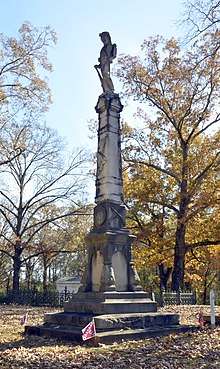
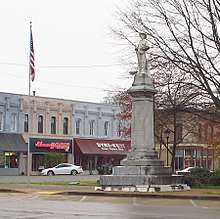
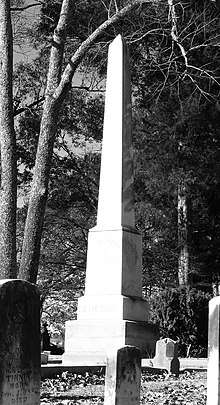
- Aberdeen: Confederate Monument in Old Aberdeen Cemetery (1900)
- Amory: Amory's Tribute to the Heroes of 1861–1865 (1924)
- Beulah: Confederate Monument (1905), Beulah Cemetery[484]
- Biloxi:
- Tomb of the Unknown Confederate Soldier
- Beauvoir, the post-war home to Jefferson Davis, contains many monuments including:
- President Jefferson Davis and Sons (2008), a life-size bronze statue commissioned by the Sons of Confederate Veterans (SCV) to commemorate the 150th anniversary of the birth of Jefferson Davis.[485][486][487] The statue features Davis standing with his arms around both his son Joe, and Jim Limber, a mixed-race stepchild of the Davis family who the SVC called "a person lost in history by revisionist historians, who felt his existence would impair their contrived notions of Davis".[486] The SCV first offered the statue to the American Civil War Center at the Tredegar Iron Works in Richmond, Virginia in order to balance the importance of a statue already located there depicting Lincoln with his son while they visited the burned-out Confederate capital in 1865.[486][487] When the center would not "guarantee where or whether the statue would be displayed or explain how it might be interpreted", the SCV rescinded its offer.[486] The statue was eventually placed at the SVC-managed Jefferson Davis Presidential Library and Museum at Beauvoir in 2010.[485]
- Brookhaven: Confederate Monument, Rose Hill Cemetery[479]
- Brooksville: Our Heroes Monument (1911)
- Canton: Howcott Monument to Loyal Servants of the Harvey Scouts (1894)
- Clinton: Confederate Monument (1928), Clinton Cemetery[488]
- Columbus:
- Confederate Monument (1894), Friendship Cemetery[489]
- Monument to Confederate Dead (1873), Friendship Cemetery[490]
- Corinth: Corinth Confederate Memorial (1992)
- Crystal Springs: Confederate Monument, Crystal Springs Cemetery[479]
- Duck Hill: Confederate Soldiers Monument (1908)
- Fayette: Confederate Soldier Sculpture (1904)
- Forest: Confederate Monument, Western Cemetery[479]
- Greenville: Confederate Monument, Greenville Cemetery[479]
- Greenwood: Confederate Memorial Building (1915)[491]
- Grenada: Confederate Monument (1910) in Public Square[492]
- Hattiesburg: Forrest County Confederate Memorial (1910)
- Heidelberg: Confederate Statue (1911)
- Hernando: DeSoto County Confederate Monument, Hernando Memorial Cemetery[493]
- Liberty: Confederate Monument (1871), the first Confederate monument in Mississippi. Dedicated by the Liberty Lodge of Masons.[494]
- Louisville: Confederate Monument (1921)
- Natchez: Confederate Monument (1890)
- Okolona: Our Confederate Dead (1905)
- Oxford: To Our Confederate Dead 1861-1865. In University Circle, at the intersection of University Ave. "Oxford is one of the few small Southern towns with two Confederate monuments. It was a compromise between two factions of the United Daughters of the Confederacy, one group wanting the statue placed on Courthouse Square, the other arguing that it should be on the campus of the University of Mississippi."[495] Erected 1906 by Albert Sidney Johnston Chapter 379 U.D.C.
- Pontotoc: Confederate Monument in town square, dedicated in 1919,[496] or the 1930s[497]
- Port Gibson: Claiborne County's Tribute to Her Sons Who Served in the War of 1861–65. (1906)
- University: Confederate Monument
- Vaiden: Vaiden Confederate Monument (1912)
- Vicksburg:
- Cedar Hill Cemetery: Soldiers' Rest Confederate Monument (1893), where an estimated 5,000 Confederate soldiers are buried.[498]
- Vicksburg National Military Park: Kentucky memorial composed of bronze statues of Abraham Lincoln and Jefferson Davis, both native Kentuckians.[499]
- Vicksburg National Military Park: Lt. Gen. Stephen D. Lee statue (1909).[500]
- Vicksburg National Military Park: Lt. Gen. John C. Pemberton statue.
- Vicksburg National Military Park: Texas Monument, listing all Texas units on the Vicksburg defensive line, in Walker's Texas Division, and in Joseph E. Johnston's Army.[501]
- Vicksburg National Military Park: Missouri Monument, one of two state memorials on the battlefield dedicated to soldiers of both armies, located where two opposing Missouri regiments clashed in battle, dedicated on October 17, 1917, during the National Peace Jubilee.
- West Point:
- Winona: Confederate Memorial Statue (1909)
- Yazoo City: Confederate Monument
Inhabited places
- Benton County (1870) named for CSA Brig. Gen. Samuel Benton who was also a politician that attended the Mississippi secessionist convention.
- Forrest County (1908)
- Jefferson Davis County (1906)
- Lee County (1866)
- City of Stonewall
Water features and dams
- Hattiesburg:
- Jefferson Davis Lake
- Jefferson Davis Lake Dam
Roads
- Bay St. Louis: Jeff Davis Drive
- Beaumont:
- Jeff Davis Parkway
- Robert E. Lee Street
- Biloxi: Jefferson Davis Avenue
- Bogue Chitto:
- Beauregard Street
- Lee Drive[5]
- Corinth: Confederate Street
- De Kalb: Jeff Davis Road
- Duck Hill: Jeff Davis Road
- Florence: Robert E. Lee Drive
- Greenwood: Robert E. Lee Drive
- Hattiesburg:
- Bedford Forrest Road
- Robert E. Lee Road
- Hollandale: Jeff Davis Road
- Indianola:
- Jefferson Davis Drive
- Stonewall Drive
- Leakesville: Jeff Davis Road
- Lexington: Robert E. Lee Street
- Long Beach: Jeff Davis Avenue
- Lucedale: Robert E. Lee Road
- Meridian: Jeff Davis School Road
- Moss Point:
- Anderson Road
- Barron Road
- Beauregard Road
- Bragg Road
- Breckinridge Road
- Cleburne Road for Patrick Cleburne
- Early Road
- Ewell Road for Richard Stoddert Ewell
- Forrest Road
- Hood Road
- Joseph E. Johnston Road
- Kirby Smith Road
- Longstreet
- Magruder Road
- Pemberton Road
- Pickett Road
- Robert E. Lee Road
- Van Dorn
- New Albany: Robert E. Lee Drive
- Oxford:
- Jefferson Davis Drive
- Lamar Avenue (the main thoroughfare) named for Lucius Q. C. Lamar drafter of Mississippi's articles of succession.[504]
- Pascagoula:
- Baker Road
- Hardee Road
- Imboden Road
- Jeb Stuart Road
- Mosby Road
- Robertson Road
- Wheeler Road
- Picayune:
- Jefferson Davis Parkway
- Longstreet Lane
- Pemberton Place
- Prairie: Jeff Davis Road
- Senatobia:
- Beauregard Street
- Forrest Avenue
- Longstreet Lane
- Tupelo:
- Beauregard Street
- Confederate Avenue
- Jeb Stuart Street
- Robert E. Lee Drive
- Vicksburg National Military Park
- Pemberton Circle, at the location of the John C. Pemberton monument.
- Pemberton Avenue, road passing the site where Pemberton surrendered his forces to Ulysses S. Grant.
- Waveland: Jeff Davis Avenue
- Wesson: Beauregard Road
Highways
- Jefferson Davis Highway
- Lee Highway[5]
Schools
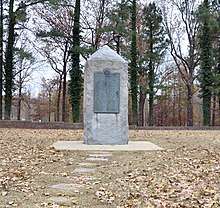
- Biloxi: Jeff Davis Elementary School
- Brooklyn:
- Forrest County Agricultural High School (1916)
- South Forrest Attendance Center (1960)
- Caledonia: Caledonia High School: The school's athletic teams are nicknamed the "Confederates."[505]
- Greenwood: Davis Elementary School
- Gulfport: Jefferson Davis Campus, Mississippi Gulf Coast Community College
- Hattiesburg:
- North Forrest Elementary School
- Jefferson Davis Hall at Pearl River Community College
- Jackson: The School Board has announced the following elementary schools will be renamed before the 2018–2019 school year:[506]
- Lee Elementary School (1922)[5]
- Jefferson Davis Elementary School
- George Elementary School, named for James Zachariah George, who signed the Mississippi Secession Ordinance and drafted the state constitution that denied voting rights to black citizens.[507]
- Oxford:
- Jeff Davis Elementary School (1959)
- University of Mississippi ("Ole Miss").
- Confederate Cemetery Memorial (1906)[508]
- The school's athletic teams are nicknamed the "Rebels."
- From 1979 to 2003, its mascot was Colonel Reb.
- The name "Ole Miss" itself was how slaves once addressed the mistress of the plantation.[509][510][511] It can be found on campus, on signs, sweatshirts, and in the football cheer.
- Various plaques have been installed and modified to try and contextualize the school's history.
- Lamar Hall (1977) memorializes Lucius Q. C. Lamar, a slaveholder who drafted the Mississippi's order of secession and funded his own CSA regiment. Post-war, he agitated for white supremacy, such as a speech before the 1875 election which he said "involved the supremacy of the unconquered and unconquerable Saxon race,"[504]
- Rolling Fork: Sharkey Issaquena Academy (private school). The school's athletic teams are nicknamed the "Confederates."[505]
- Starkville: statue of Stephen D. Lee, the youngest Confederate general and first president of the college which became Mississippi State University. Erected in 1909.[512]
Photos
 Amory
Amory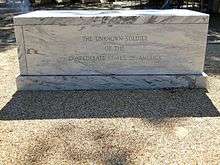 Biloxi
Biloxi Brandon
Brandon Charleston
Charleston.jpg) Corinth
Corinth Gulfport
Gulfport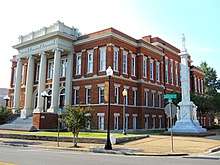 Hattiesburg
Hattiesburg Jackson
Jackson Kosciusko
Kosciusko Lexington
Lexington Liberty
Liberty Oxford
Oxford Philadelphia
Philadelphia Pontotoc
Pontotoc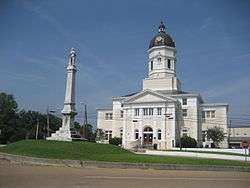 Port Gibson
Port Gibson- Quitman
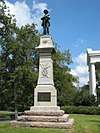 Raymond
Raymond_May_2103.jpg) Tupelo
Tupelo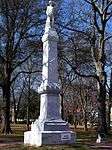 University of Mississippi
University of Mississippi Vicksburg
Vicksburg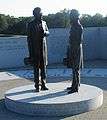 Kentucky Memorial, Vicksburg NMP
Kentucky Memorial, Vicksburg NMP The Missouri Memorial, Vicksburg NMP
The Missouri Memorial, Vicksburg NMP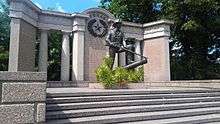 Texas Memorial, Vicksburg NMP
Texas Memorial, Vicksburg NMP.jpg) West Point
West Point
Missouri
There are at least 20 public spaces with Confederate monuments in Missouri.[5]
Monuments
Courthouse monuments
- Cape Girardeau: Confederate War Memorial (1931)
- Columbia: Confederate Monument (1935). Relocated to the Centralia Battlefield in September, 2015.
- Huntsville: Captain Delaney S. Washburn Memorial (1976).
- Neosho: Confederate Captain of Missouri Monument.
- Palmyra: Palmyra Massacre Monument (1907).
Other public monuments
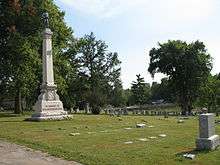
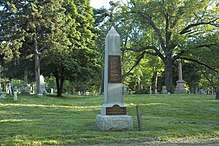
- Brookline: Missouri State Guard Monument (2001)
- Centralia: Boone County Confederate Memorial (1935)
- Dexter: Frenchman's Spring Monument (1996). A natural gathering place for soldiers. In July, 1861, 2,000 soldiers from 15 southeast Missouri counties met to organize as the First Division, Missouri State Guard — the pro-Confederate state militia, known as the Swamp Fox Brigade.
- Higginsville: Confederate Memorial State Historic Site; also called "Lion of Lucerne" (1906)
- Kansas City:
- UDC monument at Forest Hill and Calvary Cemetery to CSA soldiers killed at the Battle of Westport. Buried nearby is CSA General Joseph O. Shelby.[513]
- Union Confederate Monument, Union Cemetery (1911)
- Keytesville: Sterling Price Monument, Price Park (1915)
- Lone Jack: Cemetery monument to Confederate soldiers who died in the Battle of Lone Jack[514]
- Marshall: Confederate Monument of Saline (1901)
- Roanoke: Shelby's Homecoming Monument (1997)
- Springfield: Two monuments are located at Springfield National Cemetery: the Monument to Confederate Soldiers of Missouri and General Sterling Price (1901), and a UDC granite marker to the unknown Confederate dead at the Battle of Wilson's Creek (1958).[515]
- St. Louis:
- Waverly: CSA Gen. Joseph O. Shelby Statue (2009).
- West Alton: Confederate Memorial, Lincoln Shields Recreation Area (1909).[517]
Inhabited places
- Breckenridge: Named for U.S. Vice President and Confederate general John C. Breckinridge, although the name was misspelled.[518]
Parks
- Keytesville: Price Park memorializes Major General Sterling Price. (1915)
Roads
- Battlefield: South Robert E. Lee Street
- Hilsboro: Jefferson Davis Drive
- Sappington:
- General Lee Drive
- Confederacy Drive
Schools
- Columbia: Robert E. Lee Elementary School (1934)
- Southland C-9 School District: Rebelman mascot, school colors red, gray, and white.
Montana
There is at least one public space dedicated to the Confederacy in Montana.[5]
- Beaverhead: Confederate Dam[519][520]
- Beaverhead: Jeff Davis Creek[521]
- Confederate Gulch: historic gold mining camp founded in 1864 by Confederate soldiers, including parolees.[522][523]
New Jersey
There is at least one public space dedicated to the Confederacy in New Jersey.[5]
- Pennsville Township: Confederate Monument (1910), Finn's Point National Cemetery. Commemorates the 2,436 Confederate prisoners-of-war who died at Fort Delaware.[524]
New Mexico
- Santa Fe: Confederate memorial (1993), Santa Fe National Cemetery. Granite and bronze memorial dedicated to 31 Confederate soldiers discovered in shallow graves in 1987 at Glorieta Pass Battlefield, then re-interred at Santa Fe National Cemetery.[525][526]
- Socorro: Confederate monument (2012) entitled Victory Awaits You[527]
New York
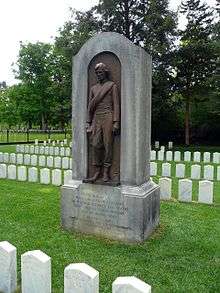
There are at least four public spaces with Confederate monuments in New York.[5][528]
Monuments
Private monuments
- Brooklyn: A tree at St. John's Episcopal Church bears a plaque, installed by UDC in 1912, reading "This tree was planted by CSA Gen. Robert Edward Lee, while stationed at Fort Hamilton."[529] The plaque was removed in 2017.[530]
- Elmira: UDC momument (1937) at Woodlawn National Cemetery, dedicated to Confederate soldiers who died in Elmira Prison[531]
- Hastings-on-Hudson: Confederate marker at Mount Hope Cemetery[532]
- The Bronx: Busts of Stonewall Jackson and Robert E. Lee are in the Hall of Fame for Great Americans at Bronx Community College. The college plans to remove the statues.[530][533]
Roads
- Fort Hamilton, Brooklyn:
- General Lee Avenue
- Stonewall Jackson Drive.
- Governor Andrew Cuomo has twice requested the Army, unsuccessfully, to have these streets renamed.[533]
- Throggs Neck, The Bronx: Longstreet Avenue, named for CSA Gen. James Longstreet[534]
North Carolina
There are at least 140 public spaces with Confederate monuments in North Carolina.[5]
Governor Roy Cooper "has called for the removal of monuments honoring Confederate soldiers and generals", including the Chapel Hill Silent Sam statue. He has called for the repeal of a 2015 law requiring legislative approval to remove Confederate monuments.[535]
State capitol
- North Carolina State Capitol. The Capitol currently houses the offices of the Governor of North Carolina. The legislature relocated to its current location in the North Carolina State Legislative Building in 1963. In 2017, Governor Roy Cooper unsuccessfully petitioned the N.C. Historical Commission to move three Confederate monuments from the grounds of the state Capitol to the Bentonville Battlefield, a Civil War site in Johnston County.[536][537]
- North Carolina State Confederate Monument (1895), also known as the Soldiers and Sailors Monument. "This 75-foot-tall monument to fallen Confederate soldiers is located on the State Capitol grounds. At the top of the column is a statue depicting a Confederate artillery soldier holding a gun. Near the bottom of the column are two statues, one representing the Confederate infantry and the other a Confederate cavalryman. Two 32 pounder naval cannons stand on each side of the monument."[538] Contains the Seal of North Carolina. Front: "To Our Confederate Dead." Rear: "First at Bethel, last at Appomattox".
- Monument to North Carolina Women of the Confederacy, also called Confederate Women's Monument (1914). "The seven foot tall monument, made possible through a private donation, honors the hardships and sacrifices of North Carolina women during the Civil War. A bronze sculpture depicts an older woman, a grandmotherly figure, holding a book as she sits next to a young boy holding a sword. It sits on top of a granite base with bronze bas-relief plaques. The woman, representing the women in the South as the custodians of history, imparts the history of the Civil War to the boy. The two relief plaques portray the Civil War; the eastern side shows soldiers departing for war and leaving their loved ones behind, while the western side depicts a weary or injured Confederate soldier returning home."[539]
- Henry Lawson Wyatt Monument (1912). He was the first Confederate soldier to die in battle. Inscription on the front: HENRY LAWSON WYATT / PRIVATE CO. A / BETHEL REGIMENT / NORTH CAROLINA VOLUNTEERS / KILLED AT BETHEL CHURCH / JUNE 10, 1861 / FIRST CONFEDERATE SOLDER | TO FALL IN BATTLE IN THE | WAR BETWEEN THE STATES. Rear: WYATT'S COMRADES / IN DASH TO BURN THE HOUSE / GEORGE T. WILLIAMS / JOHN H. THORPE / ROBERT H. RICKS / ROBERT H. BRADLEY / THOMAS FALLON / ERECTED BY THE NORTH CAROLINA | DIVISION, UNITED DAUGHTERS | OF THE CONFEDERACY. / JUNE 10, 1912 Base, east face: GORHAM. Co. FOUNDERS.[540]
- Samuel A'Court Ashe Monument (1940) (two plaques on a large granite block).[541]
Monuments
Courthouse monuments
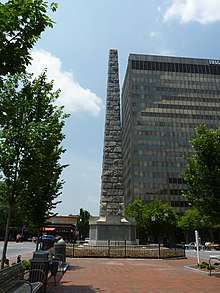
- Albemarle: Confederate Soldiers Monument (1925)[542]
- Asheville:
- Zebulon Baird Vance Monument, a granite obelisk erected in 1896.[543] Near the obelisk, a small granite marker memorializes the Dixie Highway, Confederate Gen. Robert E. Lee, and Col. John Connally, a Confederate officer who was wounded at the Battle of Gettysburg. Near the Buncombe County Courthouse entrance, a smaller obelisk memorializes Confederate soldiers from Buncombe County who fought at Chickamauga and in other Civil War battles.[543] The monument was vandalized in August 2017 and 4 individuals out of 30–40 protesters were arrested for trying to remove it with crowbars.[544]
- Monument to 60th Regiment North Carolina Volunteers (1905)
- Memorial plaque to Lieutenant William Henry Hardy (1930), "the First Soldier from Buncombe County to Fall in the War Between The States"[545]
- Bakersville: Mitchell County's Confederate Dead Monument (2011) commemorates 79 men "who died for their freedom and independence. And not for slavery."[412]
- Burgaw: Confederate Soldiers Monument (1914)
- Burnsville: Confederate Soldiers Monument (2009)
- Clinton: Confederate Soldiers Monument (1916). "In honor of the Confederate soldiers of Sampson County who bore the flag of a nation's trust and fell in a cause though lost still just and died for me and you."[83]
- Columbia: Confederate Soldiers Monument (1902); "In appreciation of our faithful slaves"[546]
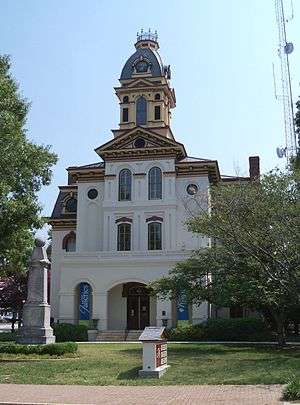
- Concord: Confederate Soldiers Monument (1892) at Old Cabarrus County Courthouse[542]
- Currituck: Confederate Soldiers Monument "To Our Confederate Dead 1861–1865" (1918)[547]
- Dallas: Gaston County Confederate Soldier Monument (2003)
- Danbury: Confederate Soldiers Monument (1990)
- Dobson: Confederate Soldiers Monument (2000)
- Elizabeth City: Confederate Soldiers Monument (1911)
- Gastonia: Confederate Soldiers Monument, Gaston County Courthouse, dedicated November 21, 1912[542]
- Graham: Confederate Soldiers Monument (1914), Alamance County Courthouse[542]
- Greenville: Confederate Soldiers Monument (1914)
- Hendersonville: Confederate Soldiers Monument (1905)[542]
- Hertford: Confederate Soldiers Monument (1912)
- Laurinburg: Confederate Soldiers Monument (1912)
- Lincolnton: Confederate Soldiers Memorial Drinking Fountain (1911)
- Louisburg: The Confederate Memorial Drinking Fountain (1923) is dedicated to Orren Randolph Smith, who designed the Stars and Bars, the first official flag of the Confederacy[542][548]
- Lumberton: Confederate Soldiers Monument (1907)
- Marion: Veterans Memorial
- Morganton: Confederate Soldiers Monument at Old Courthouse (1918)[542]
- Newton: Catawba County Confederate Soldiers Monument (1907), Old Catawba County Courthouse[542][549]
- Oxford: the Granville Gray- originally dedicated directly in front of the Granville County Courthouse it was moved to the local library after the 1970 protests following the murder of Henry Marrow
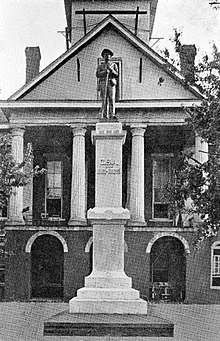
- Pittsboro: Confederate Soldiers Monument (1907), Old Chatham County Courthouse; erected by Winnie Davis Chapter, UDC[542][550]
- Plymouth: Battle of Plymouth monument (1928) at Washington County Courthouse[551]
- Roxboro:
- Confederate Monument (1931)
- Confederate Soldiers Monument, Person County Courthouse, erected in 1922, UDC[542]
- Rutherfordton: Confederate Soldiers Monument (1910)
- Shelby: Confederate Soldiers Monument (1907) at Old Courthouse[542]
- Snow Hill: Confederate Soldiers Monument (1929)[542]
- Statesville: Confederate Soldiers Monument (1906) at Iredell County Courthouse[542]
- Taylorsville: Confederate Soldiers Monument (1958)[542]
- Trenton: Confederate Soldiers Monument (1960)
- Wadesboro:
- Warrenton: Confederate Soldiers Monument (1913)
- Waynesville: Confederate Soldiers Monument (1940)
- Wilkesboro: Confederate Soldiers Monument (1998)
- Wilson: Memorial Drinking Fountain (1926)
- Winston-Salem: Confederate Soldiers Monument (1905), Forsyth County Courthouse[552]
- Winton: Confederate Soldiers Monument (1913)[542]
Other public monuments
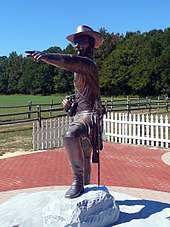
%2C_Fayetteville%2C_North_Carolina.jpg)
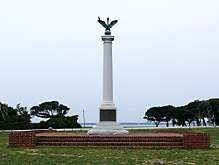
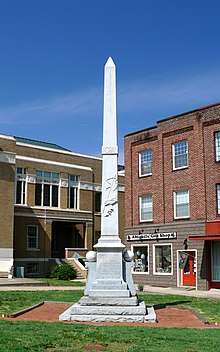
.jpg)

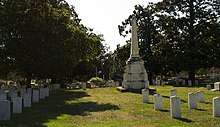
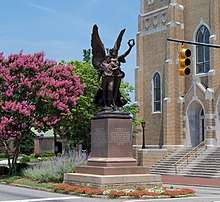
- Asheboro: Confederate Soldiers Monument (1911)
- Asheville: Confederate Soldiers Monument (1903), Newton Academy Cemetery[542]
- Beaufort: Confederate Soldiers Monument (1926), Carteret County Courthouse[542]
- Bentonville: Monuments located at the Battle of Bentonville site include:
- Confederate Monument (1895)[553]
- Joseph E. Johnston Monument (2010)[554]
- Unincorporated Cabarrus County, near Concord: Stonewall Jackson Youth Development Center (a correctional facility)
- Charlotte:
- Confederate Soldiers Monument (1977)
- Jefferson Davis Plaque (1960)
- Last Meetings of the Confederate Cabinet Marker (1915)
- 1929 Confederate Reunion Marker (1929). "Erected by citizens of City of Charlotte and County of Mecklenburg commemorating the 39th Confederate Reunion June 4–7, 1929." Currently (2018) protected by a glass enclosure.[555]
- Judah P. Benjamin Memorial "erected in His Honor by Temple Israel and Temple Beth El, the Jewish Congregations of Charlotte, as a Gift to the North Carolina Division, United Daughters of the Confederacy" (1948)[556]
- Concord:
- Confederate Soldiers Monument (1892)[542]
- Jefferson Davis Camp marker, showing where Davis "hitched his horse to a tree which stood on this spot" (1941)[557]
- Cornelius: Confederate Soldiers Monument (1910), Mt. Zion United Methodist Church. 19600 Zion Avenue.[558]
- Edenton: Confederate Soldiers Monument (1909); moved from courthouse in 1961[542]
- Enfield: Confederate Soldiers Memorial (1928) at Elmwood Cemetery. Originally located in downtown Enfield, the sculpture contains a drinking fountain.[542]
- Faison: Monument to the "Confederate Grays" 20th Regiment North Carolina State Troops (1932)[542]
- Fayetteville:
- Confederate Soldiers Monument (1868) at Cross Creek Cemetery; the first Confederate monument in North Carolina[542]
- Confederate Soldiers Monument (1902)[542]
- Confederate Arsenal (1928)
- Judah P. Benjamin marker (1944)[559]
- Fletcher:
- Jefferson Davis marker (1931), recognizing Davis as "A Statesman with Clean Hands and Pure Heart"[560]
- Orren Randolph Smith marker (1930)[561]
- Henry Timrod marker (1930), recognizing Timrod as "Laureate of the Confederacy"[562]
- Matthew Fontaine Maury marker (1932). A Confederate Navy commander and slave owner, Maury investigated resettling American slaves in Brazil.[563][564]
- Robert E. Lee Dixie Highway marker (1926), "In Loving Memory of Robert E. Lee...'The Shaft Memorial and Highway Straight Attest His Worth – He Cometh to His Own'"[565]
- Zebulon Baird Vance marker (1928)[566]
- Albert Pike marker (1928), "Arkansas Poet of the Confederacy"[567]
- Calvary Episcopal Church Memorial (1927), "During the Civil War this Church was Used as Barracks by Confederate Troops"[568]
- Forest City: Forest City Confederate Monument (1932)
- Franklin: Confederate Soldiers Memorial (1909)
- Gatesville: Confederate Soldiers Monument (1915)[542]
- Greensboro:
- Confederate Soldiers Monument at Green Hill Cemetery (1888)[542]
- Confederate Soldiers Monument (1985)[569]
- Army of Tennessee Monument (1986)[542]
- Halifax: General Junius Daniel marker (1929)[570]
- Harnett County: Confederate Monument (1872) at Chicora Civil War Cemetery to soldiers killed at the Battle of Averasborough, "In Memory of our Confederate Dead Who Fell Upon That Day"[571]
- Hendersonville: Robert E. Lee Dixie Highway Marker (1926; re-dedicated 2008)[572]
- High Point: Confederate Monument (1899), Oakwood Cemetery[573]
- Holly Springs: Confederate Soldiers Monument (1923)
- Jacksonville: Confederate Soldiers Monument (1957)
- Justice: Confederate Soldiers Monument (1912) at Stallings Memorial Park[542]
- Kinston:
- CSA Gen. Robert Hoke Monument (1920)
- Confederate Soldiers Monument (1924)
- CSS Neuse Confederate Ironclad Gunboat Monument
- Kure Beach:
- Confederate Memorial (1921)
- Fort Fisher Confederate Monument (1932); UDC monument erected at former site of Fort Fisher headquarters building[574]
- Lenoir: Confederate Soldiers Monument (1910) in town square[542]
- Lexington: Confederate Soldiers Monument (1905)[542]
- Louisburg:
- Confederate Memorial Drinking Fountain (1911)
- Confederate Soldiers Monument (1914) to "Our Confederate Dead". The monument is owned by the town of Louisburg, and is located at Louisburg College.[575]
- Middletown: Confederate Soldiers Monument (2001)
- Mocksville: Davie County War Memorial (1987)
- Monroe: Located at the Old Union County Courthouse; the obelisk (1910) was erected by the UDC Monroe chapter[576]
- Morgantown: Confederate Soldiers Monument (1918)
- New Bern: Confederate Monument (1885), Cedar Grove Cemetery[577]
- Oxford: Granville Gray (1909), a memorial to the Confederate Veterans of Granville County
- Raleigh:
- See State capitol, above
- Confederate Monument (1870), Historic Oakwood Cemetery[571]
- Reidsville: From 1910 to 2011, the monument stood in Reidsville's downtown area. In 2011, a motorist hit the monument, shattering the granite soldier which stood atop it. Placing the monument back in the center of town sparked a debate between local officials, neighbors and friends – which resulted in it being placed at its current site – the Greenview Cemetery. The new site contains a brand new statue. The original 101-year-old statue was completely destroyed.[578]
- Rockingham: Confederate Soldiers Monument (1930)
- Rocky Mount: Nash County Confederate Monument (1917), honoring Confederate war dead in Edgecombe County and Nash Counties; rededicated to all veterans of all wars in 1976
- Salisbury: Gloria Victis ("Glory to the Defeated"), also called Fame Confederate Monument. Cast in Brussels in 1891, Gloria Victis is one of two nearly-identical sculptures by Frederick Ruckstull (the other being the Confederate Soldiers and Sailors Monument, removed from public display in Baltimore in 2017). Gloria Victis appeared first at an exhibition in Paris, and then at a studio in a New York City, where it was purchased by the UDC as a Confederate monument for Salisbury. The 23 ft (7.0 m) high bronze statue features an allegorical angel with outstretched wings dressed in robes with a laurel wreath on her head. In one hand she supports a dying soldier holding a battered rifle, while in her other hand—held high—she holds a second laurel wreath with which to place on the soldier when he expires. Anna Morrison Jackson, widow of Confederate General Stonewall Jackson, attended the 1909 dedication in Salisbury.[579][580][581] In 2018 the monument was covered in white paint, apparently a response to distributing KKK flyers in black neighborhoods.[537]
- Selma: The Last Grand Review Monument (1990)[582]
- Stanley: Monument at Stanley Community Center and Polling Place
- Sylva: Confederate Soldiers Monument (1915)
- Tarboro:
- Thomasville: Thomasville and Davidson County Civil War Memorial (1910)
- Tuxedo: Robert E. Lee Dixie Highway Marker (1927)[583]
- Washington, Virginia: Confederate Soldiers Monument (1888), Oakdale Cemetery[542]
- Weldon: Confederate Soldiers Monument (1908; relocated 1934)[542]
- Wentworth: Rockingham County Confederate Monument (1998)[584]
- Wilmington:
- Oakdale Cemetery Confederate Mound (1872); North Carolina's first soldier statue[571]
- Confederate Memorial (1924)
- Confederate Monument (1932)
- Confederate Monument (1998)
- George Davis Statue (1909)
- Rose O'Neale Greenhow Monument
- Windsor: Memorial to the Confederate Dead, erected in 1896 by the Confederate Veterans Associations of Bertie County[585]
- Yanceyville: Confederate Soldiers Monument (1921), Old Caswell County Courthouse[542]
Private monuments
- Durham: Confederate memorial, Maplewood Cemetery. About 40 Confederate veterans are buried at the site. Erected in 2015 by the Sons of Confederate Veterans at a cost of about $3,000. Vandalized shortly thereafter with "Black Lives Matter" and "Tear It Down".[586]
Inhabited places
- Carrboro (1882), named for CSA soldier Julian Carr
- Hoke County (1911), named for CSA Maj. Gen. Robert Hoke
- Lee County (1907)
- Pender County (1875), named for CSA Gen. William Dorsey Pender
- Vance County (1881), named for CSA soldier and North Carolina governor Zebulon Baird Vance
- Zebulon, North Carolina
Natural features
- North Carolina Confederate Veterans Forest (1956)[587] 125,000 spruce pine trees were planted by the UDC in the 1940s as a living memorial to North Carolina Confederate Veterans. The forest was rededicated in 2001. The area is located beneath Mt. Hardy near the Blue Ridge Parkway.
Roads
- Charlotte:
- Clinton: General Lee Lane
- Creedmoor:
- N. Durham Avenue, section of US Hwy 15 called the Jefferson Davis Highway
- Fleming Street - Founder of Creedmoor and former Confederate soldier
- Dunn: General Lee Avenue
- Fayetteville: General Lee Avenue
- Flat Rock: Robert E. Lee Drive
- Hope Mills: Jefferson Davis Street
- Kinston: Robert E. Lee Drive
- Lexington: Confederate Street
- Mebane:
- Beauregard Lane
- Hill Lane
- Pickett Lane
- Stonewall Drive
- Stuart Lane
- Monroe: Confederate Street
- Salisbury:
- Beauregard Drive
- Confederate Avenue
- Pickett Avenue
- Stonewall Road
- Stuart Street
- Sanford: Robert E. Lee Drive
- Spencer:
- Beauregard Drive
- Confederate Avenue
- Pickett Avenue
- Stonewall Road
- Stuart Street
- Spring Lake: General Lee Street
- Stonewall: Stonewall Street
- Watha: Robert E. Lee Drive
- Wilmington: (all within the Pine Valley neighborhood)
- Beauregard Drive
- Breckinridge Drive, named for CSA Gen. John C. Breckinridge
- Buckner Drive, named for CSA Brig. Gen. Simon Bolivar Buckner
- Early Drive
- Jeb Stuart Drive
- Johnston Drive
- Longstreet Drive
- Merrimac Drive
- Pemberton Drive, named for CSA officer John C. Pemberton
- Pettigrew Drive, named for CSA Brig. Gen J. Johnston Pettigrew
- Pickett Drive
- Robert E. Lee Drive
- Stonewall Jackson Drive
- Windsor: Confederate Street
Ohio
Monuments
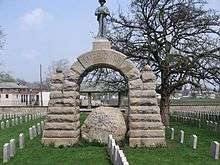

- Columbus: Camp Chase Cemetery's Confederate Soldier Memorial. Dedicated in 1902. Statue on top was toppled and damaged by vandals in August 2017.[590][591] The Veterans Administration stated that the statue will be repaired.[592]
- Ottawa County: Four UDC monuments are located at Confederate Stockade Cemetery on Johnson's Island, the first facility built by the Union Army solely for imprisoning Confederate soldiers[589]
Roads
- Milford:
- Beauregard Court, memorializing CSA Gen. P. G. T. Beauregard
- Jeb Stuart Drive, memorializing CSA Gen. J. E. B. Stuart.
- Stonewall Jackson Drive, memorializing CSA Gen. Stonewall Jackson.
Schools
- Cleveland: John Adams High School uses the Rebels team name, but the mascot more closely resembles a cavalier than a Confederate soldier.[593]
- Willoughby: Willoughby South High School dropped its Confederate uniformed mascot and removed all remaining Confederate imagery from the school while retaining the Rebels team name and school colors grey and blue. In 1993 the school dropped Stars and Bars as the school song and removed Confederate imagery from school uniforms.[593]
- McConnelsville: Morgan High School is named for Confederate General John Hunt Morgan. Their nickname is the "Raiders".
Former
- Franklin: Confederate Gen. Robert E. Lee roadside plaque. Removed August 2017.[594]
- Willoughby: Willoughby South High School: In 2017, the school dropped its "Rebel" mascot – a man dressed in a gray Confederate military outfit – but kept the "Rebel" nickname.[595]
Oklahoma

There are at least 13 public spaces with Confederate monuments in Oklahoma.[5]
Buildings
Monuments
- Ardmore:
- Atoka: Two monuments are located at the Confederate Cemetery for soldiers killed in the Battle of Middle Boggy[597][599]
- Delaware County: Two monuments to CSA General Stand Watie at Polson Cemetery; the first erected c. 1910–20, and the second erected in 1971[597]
- Durant:
- Hugo: Rose Hill
- Mayes County: Confederate Monument at site of Second Battle of Cabin Creek (1961)[597]
- Oklahoma City: Confederate Monument in Fairlawn Cemetery (1923)[597]
- Oktaha: Memorial in Oktaha Cemetery to Confederate soldiers who died in the Battle of Honey Springs (1940)[597]
- Rentiesville:
- Confederate Soldiers Monument (1988) in Honey Springs Battlefield by UDC and Children of the Confederacy.[5][597]
- Texas Confederates Memorial in Honey Springs Battlefield by UDC[597]
- Tahlequah:
- Confederate Monument at Cherokee National Capitol (1913)[597]
- Stand Watie Monument (1971)[597]
- Wynnewood: Confederate Soldier monument (2004)[602]
Schools
- Durant: Robert E. Lee Elementary School[603]
- Oklahoma City: school board studying renaming in 2017
- Robert E. Lee Elementary School (1910)[604]
- Jackson Elementary School (1910)[604]
- Wheeler Elementary School (1910)[604]
- Stand Watie Elementary School (1930)[604]
- Pauls Valley: Lee Elementary School[5]
Inhabited places
- Jackson County (1907) sources dispute if the name is for the CSA General or President Jackson
- Town of Stonewall (1874) for Stonewall Jackson
Roads
- Jay: Stand Watie Road
Oregon
Schools
- Albany: South Albany High School. After splitting from "Albany Union" school in 1971, the new "south" school embraced a Confederate theme. The mascot is the "Rebel", athletic teams are nicknamed "the Rebels", the school colors are red and gray, and a Confederate flag hung in the gymnasium until it was removed during the 1989-90 school year.[605]
Pennsylvania

There are at least three public spaces with Confederate monuments in Pennsylvania.[5]
Monuments
- Gettysburg: Gettysburg Battlefield. In addition to the monuments listed below, the battlefield features monuments to specific Confederate units.[606]
- Alabama State Monument (1933), Joseph Urner, sculptor.
- Arkansas State Monument (1966)
- "Armistead's Last Stand" Marker, for Brig. Gen. Lewis A. Armistead (1887)
- Army of Northern Virginia Marker (1908)
- Culp Brothers Memorial (2013), Gary Casteel, sculptor, near entrance Gettysburg Heritage Center. Honors brothers who fought on opposite sides: Confederate Private Wesley Culp and Union Lieutenant William Culp ("Brother against Brother").[607]
- Lt. Gen. Richard S. Ewell's Headquarters Marker (1920)
- Florida State Monument (1963)
- Georgia State Monument (1961)
- High Water Mark of the Rebellion Monument (1892)
- Lt. Gen. Ambrose P. Hill's Headquarters Marker (1920)
- Gen. Robert E. Lee Equestrian Statue (1917), atop the Virginia State Monument
- Gen. Robert E. Lee Headquarters Marker (1920)
- Lt. Gen. James Longstreet Equestrian Statue (1998)
- Lt. Gen. James Longstreet Headquarters Marker (1907)
- Louisiana State Monument (1971), Donald De Lue, sculptor
- Maryland State Monument (1994). Honors Maryland soldiers on both the Union and Confederate sides.
- Mississippi State Monument (1973), Donald De Lue, sculptor
- North Carolina State Monument (1929), Gutzon Borglum, sculptor. Borglum was also the first sculptor on the Stone Mountain#Confederate Memorial project.
- North Carolina Memorial Tablet
- Soldiers and Sailors of the Confederacy Monument (1965), Donald De Lue, sculptor
- South Carolina State Monument (1963)
- Tennessee State Monument (1982)
- Texas State Monument (1964)
- Virginia State Monument (1917), Frederick William Sievers, sculptor. Features a larger-than-life sculpture group, "Virginia to Her Sons at Gettysburg;" and is topped by an equestrian statue of Gen. Robert E. Lee. The National Park Service says the monument will not be removed.[608]
- McConnellsburg
- Confederate Soldiers Monument, dedicated in 1929.
- Last Confederate Bivouac Monument, dedicated in 1930.
- Philadelphia: Confederate Soldiers and Sailors Monument (1911), Philadelphia National Cemetery. Commemorates 184 Confederate prisoners of war who died in Philadelphia area hospitals and camps.
Roads
- Gettysburg: Confederate Avenue
- McConnellsburg: Confederate Lane
South Carolina
There are at least 112 public spaces with Confederate monuments in South Carolina.[5]
The state restricted the removal of memorials and statues with the South Carolina Heritage Act (2000), which states that "no historical monument can altered or moved without a two-thirds vote in both chambers of the state's General Assembly".[609]
South Carolina State House
- In August 2017, "a coalition of Columbia-area groups is calling for the S.C. Legislature to remove several monuments on the State House grounds."[610]
- South Carolina's Confederate Dead (1879), also known as the South Carolina Soldiers Monument.[611] It was unveiled before a crowd of 15,000.[612] The monument was largely destroyed by lightning in 1882, but was replaced by the state two years later.[612] It is positioned on the northern end of the State House grounds. After a decision by the Legislature to remove the Confederate flag from the dome of the State House, where it had flown since 1962, the monument flew a traditional version of the Confederate Battle Flag from 2000 to 2015; the flag was the subject of protests and national level political debate.[613][614] In 2015 it was removed by a 2/3 vote of both houses of the Legislature.[615] It is displayed in the South Carolina Confederate Relic Room & Military Museum.
- Monument to the South Carolina Women of the Confederacy (1912),[5] a bronze monument by Frederic W. Ruckstull.[611]
- Wade Hampton III Confederate Monument (1906),[5] 16-foot bronze equestrian statue, also by Frederick Ruckstull. There is also a statue of him within the Capitol.[616]
State holiday
- Confederate Memorial Day is celebrated on May 10. Non-essential state employees have the day off.
- On that day only, the Confederate flag is flown at the South Carolina Capitol.[617]
Monuments
Courthouse monuments

- Anderson: Anderson County Confederate Memorial, "Our Confederate Dead," dedicated in 1902.[618] The inscription reads: "The world shall yet decide, in truth's clear, far-off light, that the soldiers who wore the gray, and died with Lee, were in the right."[412]
- Bamberg: Bamberg County Confederate Monument[5]
- Bishopville: Lee County Monument to the Confederate Dead at Lee County Courthouse (1913)[619]
- Darlington: Monument to the Confederate Dead (1880)
- Edgefield Confederate Monument (1900)
- Greenwood: Confederate Monument (1903)[620]
- Lancaster: Our Confederate Soldiers Monument (1909)
- Lexington: Lexington Confederate Monument (1886)
- Manning: Confederate Monument (1914)
- St. Matthews: "Lest We Forget" Monument (1914)
- Union: Union County Confederate Memorial (1917)
- Walterboro: Confederate Monument (1911)
- York County: County removed a Confederate flag and portraits of CSA leaders from inside the court room. Being challenged in court.[621]
Other public monuments
- Abbeville:
- Aiken: Confederate Memorial (1901)[5]
- Barnwell: Confederate Monument[5]
- Bennettsville: Confederate Monument (1907)[5]
- Camden:
- Confederate War Memorial (1883)[5]
- Richard Kirkland Memorial Fountain (1911)[5]
- Charleston: Monument "To the Confederate Defenders of Charleston — Fort Sumter 1861–1865" and around the bottom of the base, "Count Them Happy Who For Their Faith And Their Courage Endured A Great Fight", and "H. A. MacNeil Alexis Rudier, Fondeur Paris" (1932).[623] Contains two bronze allegorical statues. The male figure, nude, is the defending warrior, with a sword in his right hand and a shield bearing the Seal of South Carolina in his left hand. The female figure, in a long dress, "represents the City of Charleston. She holds in her right hand a garland of laurel, symbolizing immortality, and with her left hand points towards the sea to the enemy. On the base are scenes in relief of figures repairing the shattered walls of Fort Sumter with sand bags. Eleven stars on the lower base represent the eleven Confederate states."[624] Defaced with "Black Lives Matter" and "Racism" in 2015. A monument to John C. Calhoun was defaced with "racist" and "slavery" at about the same time.[625]
- Chester Confederate Monument[5]
- Chester County: UDC monument to Confederate dead at Fishing Creek Presbyterian Church cemetery[626]
- Clemson: Old Stone Church Confederate Memorial
- Clinton Confederate Monument[5]
- Columbia:
- See State Capitol, above.
- University of South Carolina
- Longstreet Theater and Annex at the University of South Carolina[5]
- A dormitory is named for Wade Hampton. What was then South Carolina College was his alma mater.
- Conway: Our Confederate Dead Monument
- Cross Hill: Confederate Monument (1908)
- Fort Mill:
- Catawba Indian Monument (1900)
- Defenders of State Sovereignty Monument (1891)
- Faithful Slaves Monument (1895). Local cotton mill owner Samuel E. White and the Jefferson Davis Memorial Association dedicated the memorial to honor the "faithful slaves who loyal to a sacred trust toiled for the support of the army with matchless devotion and sterling fidelity guarded our defenceless homes, women and children during the struggle for the principles of our Confederate States of America."[627] This monument is seen as an example of the Lost Cause of the Confederacy movement.
- Gaffney: Cherokee County Confederate Monument (1922)[628]

- Georgetown: Confederate Monument (1929) at Battery White[629]
- Jonesville Confederate Monument (1907)
- Kingstree: Confederate Soldier, Williamsburg County Monument (1910)
- Laurens Confederate Monument (1910)
- Marion: Marion Monument "To the Dead and Living Confederate Veterans" (1903)
- Moncks Corner: Berkely County Confederate Monument (2011)
- Newberry Confederate Monument (1880)
- Orangeburg:
- Confederate Monument (1893)
- Confederate Flag and Monument (2001)
- Memorial in memory of Confederate soldiers buried in Old Pioneer Graveyard (at the Dixie Library Building)
- Prosperity: Confederate Veterans Monument (1928)
- Rock Hill: Ebenezer Confederate Monument (1908)
- Salem Confederate Monument (2004)
- Seneca: UDC Memorial Gateway (1933) dedicated to Confederate soldiers at entrance to Mountain View Cemetery[630]
- Spartanburg: Confederate Soldier Monument (1910)
- Walhalla: "Our Confederate Dead" Monument (1910)
- Westminster Confederate Monument (1980)
- Williamston: Confederate Monument (1942)
- Winnsboro: Confederate Memorial (1901)
- York: York County Confederate Monument (1906)
Private monuments
- Abbeville: The S.C. Division of the Sons of Confederate Veterans is erecting an 11.5 feet (3.5 m) foot monument on Secession Hill, dedicated to the 170 signers of South Carolina's Ordinance of Secession. The monument will be unveiled on November 10, 2018.[631]
- Aiken: A granite memorial dedicated to Confederate soldiers was erected in 2017.[631]
Inhabited places
- Counties
- Bamberg County (1897)
- Hampton County (1878)
- Lee County (1902)
- Cities
- City of Batesburg-Leesville
- Hampton
- City of Kershaw (1888)
- Other inhabited places
- Bradley (unincorporated)
- Wade Hampton (census-designated place)
Parks
- Charleston: Hampton Park
- Columbia: Hampton Park
Roads
- Aiken: Beauregard Lane
- Anderson:
- Beauregard Lane
- Bonham Court
- Beaufort
- Beauregard Court
- Hampton Street
- Bluffton: Robert E. Lee Lane
- Charleston:
- Beauregard Street
- Hampton Street
- Robert E. Lee Boulevard
- Clinton:
- Beauregard Street
- Stonewall Street
- Columbia:
- Beauregard Street
- Bonham Road
- Bonham Street
- Confederate Avenue
- Hampton Hills (neighborhood)
- South Bonham Road
- Cowpens: Stonewall Drive
- Daufuskie Island: Beauregard Boulevard
- Duncan: Hampton Street
- Early Branch: Robert E. Lee Road
- Easley: Stonewall Drive
- Fort Mill: Confederate Street
- Greenville
- Stonewall Lane
- Wade Hampton Boulevard
- Wade Hampton School Road
- Greenwood: Bonham Court
- Greer
- Beauregard Court
- Wade Hampton Boulevard
- Hartsville: Stonewall Street
- Honea Path: Beauregard Drive
- Lake City: Beauregard Street
- Lancaster: Confederate Avenue
- Lyman: Wade Hampton Boulevard
- Modoc: Beauregard Drive
- Mountville: Jefferson Davis Road
- Orangeburg:
- Beauregard Street
- Robert E. Lee Street
- Stonewall Jackson Boulevard
- Stonewall Jackson Street Southwest
- Rock Hill
- North Stonewall Street
- South Stonewall Street
- Wade Hampton Boulevard
- Saluda
- Bonham Avenue
- Bonham Road
- St. Matthews: Stonewall Lane
- Summerville:
- Beauregard Court
- Stonewall Drive
- Taylors
- Wade Hampton Boulevard
- Timmonsville:
- Robert E. Lee Avenue
- Stonewall Drive
- Trenton: Thomas S. Jackson Road
- Union:
- Bonham Station Road
- General Lee Drive
- Wagener: Stonewall Jackson Road
- Walterboro:
- Hampton Street
- . Robert E. Lee Drive
- Westminster: Stonewall Drive
- Walterboro: Robert E. Lee Drive
Schools
- Bishopville:
- Blackville: Jefferson Davis Academy
- Clemson University: Named after the Confederate soldier and son of John C. Calhoun that bequeathed the land to the state for the creation of an agricultural college.[632]
- Ehrhardt: Jackson Academy (private school): The school's athletic teams are nicknamed the "Confederates"[505]
- Greenville: Wade Hampton High School
- Varnville: Wade Hampton High School
Other
- Greenville: Wade Hampton Fire Department
Tennessee
There are at least 80 public spaces with Confederate monuments in Tennessee.[5] The Tennessee Heritage Protection Act (2016) and a 2013 law restrict the removal of statues and memorials.[30]
The Tennessee legislature designated Confederate Decoration Day, the origin of Memorial Day, as June 3, and in 1969[633] designated January 19 and July 13, their birthdays, as Robert E. Lee Day and Nathan Bedford Forrest day respectively.
Buildings
- Murfreesboro: Forrest Hall at Middle Tennessee State University. The Tennessee Board of Regents has unanimously recommended the name change, on the recommendation of a campus task force, and the university president, but it has yet to pass the Tennessee Historical Commission, which plans "public hearings."[634][635]
Monuments
Courthouse monuments
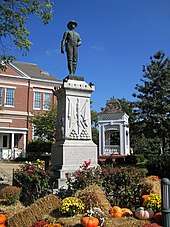

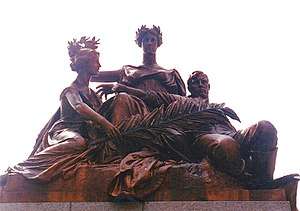
- Blountville: Confederate Memorial (1928)
- Benton: Confederate memorial (2009)[636]
- Blountville: Confederate Memorial (1928)[636]
- Bolivar: Monument to the Memory of Fallen Confederate Sons (1873)
- Brownsville: Confederate Memorial (1909)
- Carthage:
- Charlotte:
- Confederate Monument (2001): "Confederate Veterans Memorial honoring those from Dickson County who served the CSA."
- Confederate Veterans Memorial (2012) "honoring gallant soldiers, veterans and their families."[636]
- Cleveland: Confederate Monument (1911)[27]:191
- Cookeville: Eternal Flame, honors all Putnam County veterans[636]
- Covington: Confederate Monument (1895)[636]
- Decaturville: Confederate Monument[636]
- Dover: Fort Donelson. The Confederate fort was named for CSA General Daniel Smith Donelson but captured by Union General Grant in 1862, who retained the Fort's name saying "Fort Donelson will hereafter be marked in Capitals on the maps of our United Country..." Also contains Confederate Monument donated by United Daughters of the Confederacy in 1933.[637]
- Dresden: Weakley County Confederate Monument (1915)
- Dyersburg:
- Confederate Monument (1905)
- United Confederate Veterans Civil War Plaques (1926)[636]
- Erwin: War Memorial[636]
- Fayetteville:
- Civil War Memorial in memory of the three thousand Confederate soldiers of Lincoln County (1906)
- Women's Monument to those who kept up the responsibilities of farms and businesses during the Civil War (1904)[636]
- Franklin: "Our Confederate Soldiers" Monument (1899), UDC monument known locally as "Chip" memorializes soldiers who died in the Battle of Franklin. Some local residents are calling for its removal.[638]
- Greeneville: John Hunt Morgan Memorial[636]
- Jackson: "Our Confederate Dead" Monument (1888)
- Lafayette: Macon County Counfederate Monument (2001)
- Lebanon:
- 1901 monument to the Confederacy
- 2011 memorial to those from the County who served in the Army of Tennessee.
- General Robert Hopkins Hatton marker (1912)[636]
- Lewisburg: Confederate Soldier Monument (1904)
- Manchester: Erected 1991 by United Daughters of the Confederacy.[636]
- McMinnville: Warren County Civil War Memorial (2004)[636]
- Murfreesboro:
- Rutherford County Confederate Memorial (1901)
- Rutherford County Confederate Veterans Memorial (2011)
- Nathan Bedford Forrest Memorial Tablet (1912)
- Nashville: Tennessee Confederate Women's Monument, Belle Kinney Scholz, sculptor (1926)
- Paris: Confederate Monument (1900)
- Pulaski: "Rebel Martyr" Sam Davis Statue (1906)
- Savannah: Confederate Monument (1995)
- Selmer: Confederate Memorial (1994)
- Shelbyville: Confederate Memorial in Memory of the "Shelbyville Rebels" Company F 41st Tennessee Regiment CSA (1937)[27]:205
- Smithville: DeKalb County Confederate Monument (1996)
- Spencer: Confederate Monument (1988)
- Springfield: Confederate Monuments (two monuments) (1997, 2012)[636]
- Trenton: Oakland Cemetery: Confederate Monument commissioned by the United Daughters of the Confederacy in 1900 and Confederate marker commissioned by the Sons of Confederate Veterans in 1990. Listed on the NRHP.[639]
- Union City: Confederate Monument (1869)
- Waynesboro: Confederate Monument (2003)
Other public monuments
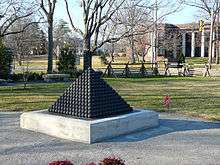
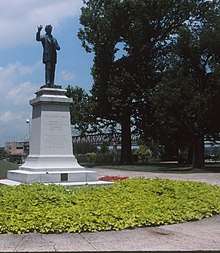
- Altamont: Confederate Memorial (1896), depicting flags of the Confederacy[636]
- Beechgrove:
- Nathan Bedford Forrest monument, in Beechgrove Confederate Cemetery.
- Memorial to the 20th Tennessee Volunteer Infantry (2008), in Beechgrove Confederate Cemetery.[636]
- Centerville: Confederate Civil War Memorial Plaque[636]
- Chapel Hill: Obelisk with Confederate flag on the site where Nathan Bedford Forrest was born.[640] There is also "a medallion-shaped monument outside city hall" with a Confederate flag.[640]
- Chattanooga: statue of Alexander P. Stewart, a confederate lieutenant, in front of the Chattanooga/Hamilton County Courthouse. (1919) Efforts have been made to remove this statue.[641]
- Clarksville: Confederate Monument (1893), Greenwood Cemetery[150]
- Clifton: Nathan Bedford Forrest Memorial[636]
- Columbia: Confederate "Funeral Rest" Memorial, Rose Hill Cemetery (1882)[636]
- Cookville: Confederate Memorial, Cookeville Cemetery (2004)[636]
- Covington: Nathan Bedford Forrest Memorial, Tipton County Museum (1998)[636]
- Crossville: Confederate and Union Memorial[642]
- Denmark: Britton Lane Confederate Monument (1897)
- Dover: Confederate Monument, Fort Donelson (1933)[636]
- Dyersburg: Confederate monument (2004), Old City Cemetery[636]
- Erwin: Confederate Memorial, Ohio Avenue (1903)[636]
- Franklin: Confederal "Funeral Rest" Memorial, Rose Hill Cemetery[636]
- Cannonballs are stacked in a pyramid to commemorate where CSA General Patrick Cleburne died in the Battle of Franklin[643]
- Gallatin: Confederate Soldiers Monument (1903)
- Hamilton County: Chickamauga & Chattanooga National Military Park. Numerous monuments and memorials to Confederate soldiers and units, as well as Union monuments.
- Humboldt: Confederate Monument (1900), Bailey Park
- Knoxville:
- A stone monument was erected in 1914 by the United Daughters of the Confederacy at the corner of 17th Street and Laurel Avenue, in the Fort Sanders neighborhood, defaced in August 2017.[644]
- Civil War Memorial (1901), Knoxville National Cemetery
- Monument to the Confederate dead (1892), Bethel Avenue[636]
- Historical marker, with Confederate flag, in front of Immaculate Conception Church, for Father Abram Ryan, called "Poet of the Confederacy".
- Lebanon:
- Confederate Memorial Gen. Hatton Statue (1912)
- Rutherford County: grounds around the County Courthouse contain a 1901 monument to the Confederacy and a 2011 memorial to those from the County who served in the Army of Tennessee.
- Lynchburg: Confederate Veterans Memorial, Moore County Public Square[636]
- Memphis:
 The Nathan Bedford Forrest Monument in Memphis
The Nathan Bedford Forrest Monument in Memphis - Mount Pleasant: Confederate Monument (1907)
- Mulberry: Confederate Memorial (1909)
- Murfreesboro: Confederate Circle in Evergreen Cemetery was established in 1891 as a memorial to approximately 2,000 Confederate soldiers whose remains were reinterred there.
- Nashville:
- Confederate Private Monument (1909) in Centennial Park.
- Confederate Gallery, Ryman Auditorium[646]
- Mount Olivet Cemetery had a burial and memorial area established by a ladies group shortly after the Civil War which became known as Confederate Circle.
- The Hermitage: UDC monument and gates (1941) at the Tennessee Confederate Soldiers Cemetery[647]
- Obion: Obion Veterans Memorial, honoring those who were killed in service and were MIA-POW in Civil War, World Wars I & II, Korea, Vietnam, Desert Storm, Afghanistan and Iraq (2006)[636]
- Parkers Crossroads:
- Freeman's Battery (2002)
- Morton's Battery (2007)
- Pulaski:
- Seventh Kentucky Mounted Infantry Memorial (1911)
- Confederate subsection with a Confederate monument dedicated by the United Daughters of the Confederacy in 1913, Maplewood Cemetery.[648]
- Santa Fe: Memorial plaque to Maury [County] Light Artillery (Confederate), public square.[636]
- Sewanee:
- Kirby-Smith Monument (1940)
- Tazewell: Confederate memorial (2000) honoring unknown Confederate dead; located in Irish Memorial Cemetery.[636]
- Trimble: Cemetery Ridge Memorial Plaza, honoring Merion Spence Parks and Williams Hamilton Parks II, members of UDC and SCV respectively (2012)[636]
- Union City
- Winchester
- UDC Memorial to Confederate soldiers (1950), City Cemetery
- SCV Memorial to Confederate soldiers (2003), Confederate Cemetery, adjoining the City Cemetery"[636]
- Woodbury: 1926 monument "honors all confederate soldiers and marks the spot where CSA Lt. Col. John B. Hutchenson was killed."[636]
Private monuments
- Nashville
- Nathan Bedford Forrest Statue, made of fiberglass over foam, 25 feet high, on private land[649] near Interstate 65, installed in 1998, built with private money. It is surrounded by Confederate battle flags, constituting what the owner calls "Confederate Flag Park." (No government recognizes it as a park, and the entrance is chained shut with a "No Trespassing" sign.) The giant statue is visible from the highway to anyone entering the city from the south.[650] It has been called "hideous"[650] and "ridiculous."[651] There have been numerous calls for its removal. Tennessee Governor Bill Haslam said: "It's not a statue that I like and [ sic ] that most Tennesseans are proud of in any way."[652] Former Nashville Mayor Megan Barry called the statue "an offensive display of hatred."[652] In 2015, Nashville's Metro Council voted to petition the Tennessee Department of Transportation to plant obscuring vegetation;[653] the Department declined, because it is private land.[650] ("Never mind that the T.D.O.T. itself removed the obscuring vegetation back in 1998, when the statue was first erected."[650][652]) There has been occasional vandalism; in December 2017 it was covered in "pussy-hat pink" paint,[650] which Bill Dorris, current owner of the land, says he intends to leave.[654] He also said that if trees are planted to block the view from I-65, he "would make the statue taller."[649] It was sculpted, at no charge, by notorious racist Jack Kershaw, an attorney for Martin Luther King's murderer, famous for having said "Somebody needs to say a good word for slavery."[655][656]
Parks
- Eva: Nathan Bedford Forrest State Park (1963)
- Franklin: Confederate Memorial Park at Winstead Hill Park
Roads
- Brentwood
- Jefferson Davis Drive
- Robert E. Lee Lane
- Culleoka: General Lee Road
- Dandridge
- Jeb Stuart Drive
- Stonewall Jackson Drive
- Elizabethton: Stonewall Jackson Drive
- Eva: Jeff Davis Drive
- Forest Hills: Robert E. Lee Drive
- Franklin:
- General J.B. Hood Drive
- General Nathan Bedford Forrest Drive
- Jeb Stuart Drive
- Jefferson Davis Drive
- Gallatin: Robert Lee Drive
- Nashville:
- Beauregard Drive
- Jefferson Davis Drive
- Confederate Drive
- General Forrest Court
- Robert E. Lee Court
- Robert E. Lee Drives (two different streets with the same name)
- Newport
- Robert E. Lee Drive
- Stonewall Jackson Driv
- Oak Hill: Stonewall Jackson Court
- Pulaski
- Sam Davis Avenue
- Sam Davis Trail
- Sardis: Jeff Davis Lane
- Smyrna
- Jeb Stuart Drive
- Lee Lane[5]
- Longstreet Drive
- Robert E. Lee Lane
- Sam Davis Road
- Stonewall Drive
Inhabited places
- Dixie Lee Junction unincorporated community where the Dixie and Lee Highways intersect
Schools
- Chapel Hill: Forrest High School
- Nashville: Father Ryan High School, named for Abram Ryan, called "Poet of the Confederacy".
- Paris: Robert E. Lee School
- Sewanee: Sewanee: The University of the South. "Nowhere is the issue of Confederate remembrance more nettlesome than at Sewanee, whose origin[s] are entwined with the antebellum South and the Confederacy."[657] Confederate flags are in stained glass windows of the chapel, as is the Seal of the Confederacy.[657] It benefited greatly at its founding by a large gift from John Armfield, at one time co-owner of Franklin and Armfield, the largest and most prosperous slave trading enterprise in the country. Students as late as 1871 were required to wear uniforms of "cadet gray cloth".[658] Confederate flags hung in the chapel from its dedication in 1909 until the mid-1990s when they were removed "reportedly to improve acoustics".[659] There is an official portrait hanging at the University of Bishop Leonidas Polk, "an ardent defender of slavery,"[657] who was in charge of the celebration of the cornerstone laying in 1857, and said the new university will "materially aid the South to resist and repel a fanatical domination which seeks to rule over us."[660] He resigned his ecclesiastical position to become a major general in the Confederate army (called "Sewanee's Fighting Bishop"), and died in battle in 1864. His official portrait at the University depicts him dressed as a bishop with his army uniform hanging nearby. However, his portrait was moved from Convocation Hall to Archives and Special Collections in 2015.[661] The Confederate flag was also emblazoned on the university mace that led processions marking the beginning and ending of the term from 1965 until 1997. At a special chapel service to celebrate Jefferson Davis' birthday, the Ceremonial Mace was consecrated to the memory of Nathan Bedford Forrest, the first Grand Wizard of the Ku Klux Klan, by Bishop Charles C. J. Carpenter of Alabama – one of the clergy who opposed Dr. Martin Luther King Jr.'s activities in Birmingham in 1963 (see A Call for Unity), prompting King to write his "Letter from a Birmingham Jail" in response.[659]
- The Vice Chancellor is the chief academic officer at the university; the chancellor is a bishop of the Episcopal church. Jefferson Davis and Robert E. Lee both turned down offers of the position.[662] (Sewanee has a portrait of Davis.[663]) The first vice chancellor was Rt. Rev. Charles Todd Quintard, called "chaplain of the Confederacy". He compiled the Confederate Soldiers' Pocket Manual of Devotions (Charleston, 1863).[664]
- The university's chief donor was John Armfield, at the time co-owner of Franklin and Armfield, the largest slave-trading firm in the U.S. He purchased the site and gave the university an endowment of $25,000 a year. In addition to Polk, Bishop Stephen Elliott, the first and only Presiding Bishop of the Protestant Episcopal Church in the Confederate States of America, and Bishop James Hervey Otey, later prominent in the Confederacy, were significant founders of the university. Generals Edmund Kirby Smith, Josiah Gorgas, and Francis A. Shoup were prominent in the university's postbellum revival and continuance.
- Monument to Edmund Kirby Smith, Texas Avenue. Smith was, after the war, a Sewanee professor of botany and mathematics.[657]
- Tullahoma: Robert E. Lee Elementary (1964)
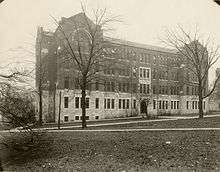
- Vanderbilt University:
- Calhoun Hall, named for William Henry Calhoun, a slave owner, Masonic Grand Master and silversmith who was arrested for his Confederate support on the order of Union Brigadier General Robert Byington Mitchell pending the release of Union prisoners in 1863.[665][666]
- Portrait of Confederate General Edmund Kirby Smith by Cornelius Hankins in the Wyatt Center.[667] Smith served as the chancellor of the University of Nashville from 1870 to 1875.[667]
- Marble bust of Confederate Colonel and Board of Trust Treasurer Edmund William Cole in Kirkland Hall, the administration building.[668] He is also the namesake of the annual Cole Lecture.[669]
- The campus includes several buildings tied to slavery and the Confederacy, like McTyeire Hall (named for pro-slavery essayist Holland Nimmons McTyeire) and Elliston Hall (named for Elizabeth Boddie Elliston of the Burlington Plantation, who owned slaves).[670][671][672]
Theme park
- Pigeon Forge: "Rebel Railroad" was a small theme park built in 1961, its main attraction being a simulated Confederate steam train which afforded "'good Confederate citizens' the opportunity to ride a five mile train route through 'hostile' territory and to help repel a Yankee assault on the train". Rebel Railroad was purchased in 1970 by Art Modell, owner of the Cleveland Browns.[673][674][675] In 2018 it is operating under the name Dollywood.
Former
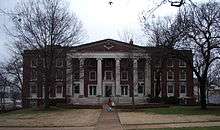
The 2016 Tennessee Heritage Protection Act puts "the brakes on cities' and counties' ability to remove monuments or change names of streets and parks."[641]
- Franklin: The Forrest Crossing Golf Course, owned by the American Golf Corporation, changed its name to the Crossing Golf Course on September 22, 2017.[676] It had been named after Confederate General and Klansman Nathan Bedford Forrest.[676]
- Memphis:
- Three Confederate-themed city parks were "hurriedly renamed" prior to the passage of the Tennessee Heritage Protection Act of 2013. Confederate Park (1908) was renamed Memphis Park; Jefferson Davis Park was renamed Mississippi River Park; and Nathan Bedford Forrest Park was renamed Health Sciences Park.[677][678]
- Jefferson Davis Monument (1964), in the former Jefferson Davis Park. The city is suing the state to get it removed.[679][680][681] It was removed under police guard December 20, 2017.[682]
- Nathan Bedford Forrest Monument (1904): It was installed thanks in part to Judge Thomas J. Latham's wife.[683] It was located in the former Nathan Bedford Forrest Park, in 2015 renamed Health Sciences Park. The City of Memphis is suing the state to get it removed.[684][680][681] It was removed, under police guard, December 20, 2017.[682]
- Nashville: Confederate Memorial Hall on the campus of Vanderbilt University was built in 1935. The school renamed the building "Memorial Hall" in August 2016, and returned to the United Daughters of the Confederacy the 2016 value ($1,200,000) of their donation at the time of its construction.[685]
Texas
There are at least 178 public spaces with Confederate monuments in Texas.[686][5] "Nowhere has the national re-examination of Confederate emblems been more riven with controversy than the Lone Star State."[687]
State Capitol
- "The Texas Capitol itself is a Confederate monument," according to then-Land Commissioner Jerry E. Patterson.[688]
- The former Texas Confederate Museum occupied a room on the first floor from 1903 to 1920, then moved to the Old Land Office Building, on the Capital grounds, until 1988, when the building became the Capital Visitors Center. The Museum, unable to find a new permanent home, never reopened.
- Confederate Soldiers Monument (1903) features four bronze figures representing the Confederate artillery, cavalry, infantry, and navy. A bronze statue of Jefferson Davis stands above them.[689] The inscription reads: "Died for state rights guaranteed under the constitution. The people of the South, animated by the spirit of 1776, to preserve their rights, withdrew from the federal compact in 1861. The North resorted to coercion. The South, against overwhelming numbers and resources, fought until exhausted."[690]
- Hood's Texas Brigade, a monument "to memorialize those [who] fought for the Confederacy".[691] "The monument includes a depiction of a Confederate soldier, quotes by Confederate leaders, a flag of the Confederacy and the Confederate battle flag."[692] These are the only Confederate flags currently (2017) visible in the Capitol.[693] Representative Eric Johnson has called for its removal.[692]
- Terry's Texas Rangers Monument, a monument "to memorialize those [who] fought for the Confederacy"[691] (1907).
- Children of the Confederacy Creed plaque (1959). It reads:
Because we desire to perpetuate, in love and honor, the heroic deeds of those who enlisted in the Confederate Services, and upheld its flag through four years of war, we, the children of the South, have united in an Organization called the “Children of the Confederacy,” in which our strength, enthusiasm and love of justice can exert its influence.
- We, therefore pledge ourselves to preserve pure ideals; to honor the memory of our beloved Veterans; to study and teach the truths of history (one of the most important of which is, that the War Between the States was not a rebellion, nor was its underlying cause to sustain slavery). and always to act in a manner that will reflect honor upon our noble and patriotic ancestors.
- Speaker Joe Straus in 2017 called for its removal, citing the statement "was not a rebellion, nor was its underlying cause to sustain slavery" as "not accurate, and Texans are not well-served by incorrect information about our history," in a letter to the State Preservation Board that oversees the Capitol grounds.[694]. Texas House Representative Eric Johnson has joined in the call for its removal.[695] By July, 2018, more than 40 state lawmakers had called for its removal.[696]
State symbols
- The reverse side of the Seal of Texas (1992) includes "the unfurled flags of the Kingdom of France, the Kingdom of Spain, the United Mexican States, the Republic of Texas, the Confederate States of America, and the United States of America". The Confederate flag is rendered as the Stars and Bars.
State holiday
- Confederate Heroes Day is celebrated on January 19. State employees have the day off.
Buildings
- Austin
- The John H. Reagan state office building is located at 1400 Congress.[691]
Monuments
Many monuments were donated by pro-Confederacy groups like Daughters of the Confederacy. County governments at the time voted to accept the gifts and take ownership of the statues.[697][698]
Courthouse monuments
- Alpine: Confederate Colonel Henry Percy Brewster (1963)[699]
- Aspermont: Historical marker, "County Named for Confederate Hero Stonewall Jackson", Stonewall County Courthouse (1963)
- Bastrop: Monuments at Bastrop County Courthouse include:
- Confederate Soldiers' Monument (1910)[700]
- Historical marker, "Home Town of Texas Confederate Major Joseph D. Sayers" (1963)[701]
- Bay City: Confederate Soldiers' Monument (1913), Matagorda County Courthouse[702][703]
- Belton: Confederate Soldiers' Monument, Bell County Courthouse[704]
- Bonham: Confederate Soldiers' Monument (1905), Fannin County Courthouse[705]
- Bryan: Commemorative marker, erected 1965, to the Brazos County Confederate Commissioners Court.[706]
- Comanche: Confederate Soldiers' Monument (2002), Comanche County Courthouse[707]
- Corsicana: Call to Arms (Confederate Soldiers' Monument), by Louis Amateis (1907), Navarro County Courthouse.[708][709] A Civil War bugler stands in uniform holding a bugle to his mouth with his proper right hand. He holds a sword in his proper left hand at his side. He wears a hat with a feather in it and knee-high boots. A bedroll is slung over his proper left shoulder and strapped across his chest and proper right hip. The sculpture is mounted on a rectangular base.[710] "Isaac O'Haver was a member of Co K of the 17th VA Cavalry. He was a 17 year-old bugler for his unit. He was born Sep. 20, 1844 and died at the age of 27 on March 30, 1872. He is buried at the Ladoga Cemetery."[711] The plaques on the monument read:
- South side: The Call to Arms Erected 1907 by Navarro chapter United Daughters of the Confederacy To commemorate the valor and heroism of our Confederate Soldiers It is not in the power of mortals to command success The Confederate Soldier did more - he deserved it. "But their fame on brightest pages penned by poets and by pages Shall go sounding down the ages"
- West side: "Nor shall your glory be fought while fame her record keeps or honor points the hollowed spot where valor proudly sleeps" "Tell it as you may It never can be told Sing it as you Will It never can be sung The Story of the Glory of the men who wore the gray"
- East side: "It is a duty we owe the dead who died for us: - But where memories can never die - It is a duty we owe to posterity to see that our children shall know the virtues And rise worthy of their sires".
- North side: The soldiers of the Southern Confederacy fought valiantly for The liberty of state bequeathed them By their forefathers of 1776 "Who Glorified Their righteous cause and they who made The sacrifice supreme in That they died To keep their country free"[710]
- Clarksville: Confederate Soldiers' Monument, Red River County County Courthouse[712]
- Denton: Denton Confederate Soldier Monument, Denton County Courthouse.[713] Cost $2,000; a project of the Denton Chapter, UDC. Dedicated June 3, 1918, Jefferson Davis's birthday.[714] It had "whites only" drinking fountains on each side.[715] In 2015 it was defaced with the words "THIS IS RACIST" in red paint.[716] The twenty-year campaign of a Denton resident, Willie Hudspeth, to have the monument removed was the subject of a Vice news video in 2018.[715] After the wave of Confederate monument removals that followed the 2017 Unite the Right rally in Charlottesville, Virginia, and in large part as a result of Hudspeth's campaign, a county 15-person Confederate Memorial Committee met for three months in 2017–18 and recommended "adding context" — two video kiosks and a large plaque, "with interviews about local veterans and the history of slavery"[717] — to the monument rather than removing it, a suggestion accepted unanimously by the county commissioners. Once the nature of the historical context has been determined, approval of the Texas Historical Commission will be required.[718] As of September, 2018, "the county still does not have a timeline for completing the project and...there were no updates to report".[719] The video caught the attention of Kali Holloway, director of the Make It Right Project, which is working to remove Confederate monuments. She added the Denton monument to the group's "top 10 list" of monuments they consider priorities.[720][719]
- Fort Worth: Monument to "Confederate Soldiers and their Descendents" (1953), Tarrant County Courthouse[721]

- Galveston: Dignified Resignation (1909) by Louis Amateis at the Galveston County Courthouse. With his back turned to the US flag while carrying a Confederate flag, it is the only memorial in Texas to feature a Confederate sailor.[722][723] It was "erected to the soldiers and sailors of the Confederate States of America." An inscription on the plaque reads, "there has never been an armed force which in purity of motives intensity of courage and heroism has equaled the army and navy of the Confederate States of America."[690]
- Gainesville: Confederate Soldiers' Monument, Cooke County Courthouse (1911)[724][725]
- Georgetown: Confederate Soldiers and Sailors Monument, Williamson County Courthouse (1916)
- Goldthwaite: Confederate Soldiers' Monument, Mills County Courthouse[726]
- Granbury: Statue of CSA Geneneral Hiram B. Granbury (1913), killed in the Battle of Franklin (1913), Hood County Courthouse[727]
- Hillsboro: Confederate Soldiers' Monument, Hill County, Texas Courthouse[728]
- Jefferson: Confederate Soldiers' Monument (1907, moved to the courthouse in the 1930s), Marion County Courthouse[729][730]
- Linden: Confederate Monument (1903), Cass County Courthouse[731]
- Livingston: Confederate Soldiers' Monument, Polk County Courthouse[732]
- Llano: Confederate Soldiers' Monument, Llano County Courthouse[733]
- Lockhart: Confederate Soldiers' Monument, Caldwell County Courthouse[734]
- Longview: Confederate Soldiers' Monument (1911), Gregg County Courthouse[735][736]
- Mount Pleasant: Confederate Soldiers' Monument (1912), Titus County Courthouse[737][738]
- Memphis: Confederate Soldiers' Monument, Hall County Courthouse[739]
- Marshall: Confederate Soldiers' Monument (1906), Harrison County Courthouse[740]
- New Braunfels: Confederate Soldiers' Monument (1937), Comal County Courthouse[741]
- Paris: Confederate Soldiers' Monument, Lamar County Courthouse[742] Confederate Soldiers' Monument, Kaufman, Kaufman County Courthouse[743]
- Perryton: Courthouse monument to CSA colonel William Beck Ochiltree[744]
- Rusk: Confederate Soldiers' Monument, Cherokee County Courthouse[745]
- Sherman: Confederate Soldiers' Monument (1896), Grayson County Courthouse. This was the first Confederate statue dedicated at a county courthouse in Texas.[746]
- Snyder: marker (1963) commemorating William Read Scurry, Scurry County Courthouse[747]
- Stephenville: Confederate Soldiers' Monument (2001), Erath County Courthouse[748]
.jpg)
- Texarkana: The Confederate Mothers Monument (1918), located in Texas near the state line with Arkansas, is shared by the US District Court in Texarkana, Texas, and the US Post Office and Courthouse in Texarkana, Arkansas[749][750]
- Vernon: Confederate Soldiers' Monument, Wilbarger County Courthouse [751]
- Weatherford: Confederate Soldiers' Monument (1929), Parker County Courthouse[752]
- Waxahachie: Confederate Soldiers' Monument (1912), Ellis County Courthouse[753][754]
Other public monuments
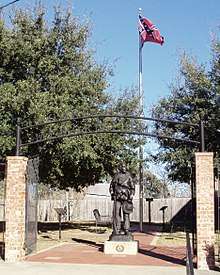

- Alpine: CSA Gen. Lawrence "Sul" Ross Monument (1963)
- Amarillo: Confederate Soldier Statue (1931)[722]
- Anderson: Confederate Memorial Plaza (2010).[755] The plaza beside the Grimes County courthouse flies a Confederate flag behind a gate with metal lettering reading "Confederate Memorial Plaza." A metal statue depicts one of several Grimes County residents who fought with the 4th Texas volunteer infantry brigade in Virginia.[690]
- Athens: Henderson County Confederate Monument (1964)
- Austin:
- Hood's Texas Brigade Monument, Texas State Capitol
- Littlefield Fountain, University of Texas, commemorates George W. Littlefield, a university regent and CSA officer. An inscription reads, "To the men and women of the Confederacy who fought with valor and suffered with fortitude that states [sic] rights be maintained."
- Texas Confederate Women's and Men's Historical Markers, at 3710 Cedar St. and 1600 W. Sixth, commemorate campgrounds built to house and care for widows, wives, and veterans of the Confederacy.[691]
- Beaumont: "Our Confederate Soldiers" Monument (1912)
- Clarksville: Confederate Soldier Monument (1912)
- Cleburne: Cleburne Monument (2010)
- Coleman: Hometown of Texas CSA Col. James E. McCord Monument (1963)
- College Station: A statue of Lawrence Sullivan Ross, Confederate general and former president of A&M University is located on the campus of Texas A&M University. In August 2017 the Chancelor of the university, John Sharp, confirmed that the university will not be removing the statue from the campus.[756]
- Corpus Christi: Queen of the Sea (1914; restored 1990), bas-relief by Pompeo Coppini; UDC-sponsored Confederate memorial featuring an allegorical female figure – representing Corpus Christie – holding keys of success while receiving blessings from Mother Earth and Father Neptune, who are standing next to her.[722] "Coppini was abhorrent of war", and in Queen of the Sea "he crafted a sculpture that symbolized peace and captured the spirit of Corpus Christi".[757]
- Dallas: Confederate War Memorial. Originally erected in City Park in 1897, but relocated to Pioneer Park Cemetery in 1961 due to highway construction.[758] Dallas Mayor Mike Rawlings called in 2017 for a task force to decide what to do it, as well as the statue of Lee in Lee Park.[533]
- El Paso:
- Hometown of Texas CSA Capt. James W. Magoffin Monument (1964)
- CSA Maj. Simeon Hart Monument (1964)
- Farmersville: Confederate Soldier Monument (1917), Farmersville City Park[759]
- Fort Worth: Confederate Soldier Memorial (1939), Oakwood Cemetery[722]
- Gainesville Confederate Heroes Statue (1908) in Leonard Park[760][761]
- Gonzales: Confederate Soldiers' Monument, Confederate Square. Dedicated on June 3, 1909. To "our Confederate dead."[762][763]
- Greenville: Confederate Soldier Monument (1926)
- Holliday: Stonewall Jackson Camp 249 Monument (1999)
- Houston:
- Spirit of the Confederacy (1908, in present location since 1925), by Louis Amateis.[722] Erected by United Daughters of the Confederacy.[764]
- Dick Dowling (sculpture), located at the entrance to Hermann Park. Erected in 1905, the monument was in front of City Hall until 1958, when it was moved to its present location. In August 2017 Andrew Schneck was arrested at the statue with bomb materials.[765]
- Kermit: Col. C.M. Winkler Monument (1963)
- Marshall:
- Confederate Capitol of Missouri Monument (1963)
- Confederate Monument (1906)
- Home of Last Texas Confederate Gov. Pendleton Murrah Monument (1963)
- Miami: Col. O.M. Roberts Monument (1963)
.jpg)
- Palestine: John H. Reagan Memorial (1911) by Pompeo Coppini[722]
- Sabine Pass: Sabine Pass Battleground. Where the Sabine River enters the Gulf of Mexico, 47 Confederate men held off a large Union attack, destroying two Union boats and capturing hundreds of prisoners. Today the site is managed by the Texas Historical Commission, and it hosts battle reenactments in honor of the Confederate soldiers.
- Sherman: Confederate Soldier Monument (1897)
- Tomball: Confederate Powder Mill Marker Monument (1966)
- Victoria: Confederate Monument (1912). Pompeo Coppini's statue, called The Last Stand, and sometimes The Firing Line, sits in De Leon Plaza. The inscription reads: "On civilization's height / Immutable they stand". The $5,000 cost was raised by the United Daughters of the Confederacy.
Private monuments

- Austin: Confederate monument, Oakwood Cemetery. Erected in 2016 by the Sons of Confederate Veterans.[766]
- Belton: Monument to Confederate Sargeant Jacob Hemphill. Erected 2016 by Sons of Confederate Veterans.[767]
- Crowley: "Confederate Veterans Memorial Monument honoring The Confederate Veterans of Crowley and the surrounding area interred at the Crowley Cemetery." Erected 2011 by the Sons of Confederate Veterans.[767]
- Hempstead: The Liendo Plantation was a center for Confederate recruiting efforts and held Union prisoners during the war. Now it holds battle reenactments and demonstrations of Civil War era Confederate life at its annual Civil War Weekend.
- Orange: The Confederate Memorial of the Wind, located on Martin Luther King Jr. Drive, but visible from I-10, has been under construction since 2013, and will be the largest Confederate monument built since 1916, according to the Sons of Confederate Veterans.[687] A center stone ring is held aloft by 13 pillars, one for each state that seceded. There are twenty commemorative flagpoles.
- Palestine: Confederate Veterans Memorial Plaza (2013), funded by the Sons of the Confederate Veterans[768]
- White Settlement: Texas Civil War Museum, opened 2006.
Inhabited places
Counties
- Donley County (1882) named for Stockton P. Donley, a lawyer who enlisted in the Confederate Army. Just after the war in 1866, he was elected to the Supreme Court of Texas, but was removed by the Reconstruction military government.
- Ector County (1891) named for CSA General Mathew Ector, who later served as a judge.
- Foard County (1891) named for Robert L. Foard an attorney and Confederate Major.[769]
- Gray County (1902) named for Peter W. Gray, a lawyer and legislator who attended the 1861 Texas State Secession Convention, and voted to leave the union. Shortly after, Gray was elected to the Confederate House of Representatives.
- Gregg County (1873) named for CSA General John Gregg, who was a delegate to the Texas Secession Convention in 1861 and was elected to represent Texas in the Provisional Confederate Congress in Montgomery, Alabama, and later in Richmond, Virginia. He was killed in action at the Siege of Petersburg in 1864.
- Hemphill County and Hemphill city (1877) named for John Hemphill, Chief Justice of the Texas Supreme Court from 1841 to 1858 until he was elected to the US Senate when Sam Houston refused to support secession. He was expelled from the Senate when Texas seceded in 1861 and then represented Texas in the Provisional Confederate Congress.
- Jeff Davis County (1887) named for Jefferson Davis.
- Lee County (1874) named for Robert E. Lee.
- Ochiltree County (1889) named for secessionist politician William Beck Ochiltre.
- Oldham County (1881) named for William Simpson Oldham Sr., a Confederate politician.
- Randall County (1889) named for CSA Brig. Gen. Horace Randal.
- Reagan County (1903) named for CSA Postmaster General John H. Reagan.
- Reeves County (1884) named for CSA officer George R. Reeves.
- Roberts County (1889) named for Oran Milo Roberts, who was unanimously elected president of the 1861 Secession Convention, a meeting that he had been influential in calling. In 1862 he resigned the Supreme Court seat and was elected colonel of the Eleventh Texas infantry in the Confederate Army. He was gobernor of Texas from 1879 to 1883.
- Scurry County (1884) named for secessionist and CSA Gen. William Read Scurry.
- Stonewall County (1888) named for CSA General Stonewall Jackson.
- Sutton County (1890) named for CSA officer John S. Sutton.
- Terrell County (1905) named for CSA acting General Alexander W. Terrell.
- Terry County (1904) named for CSA Col. Benjamin Franklin Terry .
- Tom Green County (1875) named for CSA Brig. Gen. Thomas Green, KIA (killed in action).
- Upton County (1910) named for brothers John C. and William F. Upton, both colonels in the Confederate Army.
- Winkler County (1910) named for CSA Col. Clinton M. Winkler.
Municipalities
- City of Cleburne (1871)
- City of Fort Davis: named for Jefferson Davis.
- City of Granbury (1887)
- City of Hemphill: named for judge and Confederate politician John Hemphill (see Hemphill County as well)
- City of Robert Lee
- City of Stonewall: named for Stonewall Jackson.
Parks
- Davis Mountains State Park (1938) named for the mountain range
- Davis Mountains (geographic feature in West Texas around and named for Fort Davis)
- Fort Worth: Jefferson Davis Park.[770]
- Holliday: Stonewall Jackson Campground
- Lakeside, Tarrant County: Confederate Park. The two Confederate flags displayed on each side of the park's marker were removed by the Texas Department of Public Transportation in 2017. Marker text:
Site of Confederate Park // Local businessman Khleber M. Van Zandt organized the Robert E. Lee Camp of the United Confederate Veterans in 1889. By 1900 it boasted more than 700 members. The Club received a 25-year charter to create the Confederate Park Association in 1901, then purchased 373 acres (151 ha) near this site for the “recreation, refuge and relief of Confederate soldiers" and their families. Opening events included a picnic for veterans and families on June 20, 1902, and a statewide reunion September 8–12, 1902, with 3,500 attendees. The park thrived as a center for the civil and social activities on Texas Confederate organizations. By 1924 the numbers [ sic ] of surviving veterans had greatly diminished, and the Confederate Park Association dissolved when its charter expired in 1926.[771]
- Palestine: John H. Reagan Park
Roads
- Austin:
- In July, 2018, at approixmately the same time that Robert E. Lee Road and Jeff Davis Avenue were renamed, the city's Equity Office recommended changing the names of seven more streets:
- Littlefield Street. Commemorates George W. Littlefield, a CSA officer.
- Tom Green Street
- Sneed Cove, named for Richard A. Sneed, Confederate soldier and co-founder of the Ku Klux Klan.
- Reagan Hill Drive
- Dixie Drive
- Plantation Road
- Confederate Avenue[772]
- In July, 2018, at approixmately the same time that Robert E. Lee Road and Jeff Davis Avenue were renamed, the city's Equity Office recommended changing the names of seven more streets:
- Conroe:
- Beauregard Drive
- Jubal Early Lane
- Stonewall Jackson Drive
- El Paso: Robert E. Lee Road
- Hamilton: Stonewall Jackson Road
- Hillsboro: Confederate Drive
- Hemphill:
- Confederate Street
- Stonewall Street
- Holliday: Stonewall Road
- Houston:
- Robert E. Lee Road
- Robert Lee Road
- Tuam Street, another major artery is named for Tuam, CSA Gen. Dowling's birthplace in Irelamd
- Hunt: Robert E. Lee Road
- Jacksonville: Jeff Davis Street
- Kermit East Winkler Street
- Lakeside Confederate Park Road
- League City: Jeb Stuart Drive
- Levelland: Robert Lee Street
- Liberty: Confederate Street
- Livingston: Robert E. Lee Road
- Marshall:
- Jeff Davis Street
- Stonewall Drive
- Missouri City
- Beauregard Court
- Bedford Forrest Drive
- Breckinridge Court
- Confederate Drive
- Pickett Place
- Richmond:
- Jeb Stuart Drive
- Jeff Davis Drive
- Stonewall Drive
- Ridgley: Bedford Forrest Lane
- Roma: Robert Lee Avenue
- San Antonio:
- Beauregard Street
- Robert E. Lee Drive
- Sterling City: Robert Lee Highway
- Sweetwater: Robert Lee Street
- Tyler:
- Jeb Stuart Drive
- Jeff Davis Drive
- Victoria: Robert E. Lee Road
Note: "There are similarly named streets in towns and cities across east Texas, notably Port Arthur and Beaumont, as well as memorials to Dowling and the Davis Guards, not least at Sabine Pass, where the battleground is now preserved as a state park"
Schools
- Abilene:
- Jackson Elementary School
- Johnston Elementary School
- Lee Elementary School (1961)[5]
- Amarillo:
- Lee Elementary School[5]
- Tascosa High School. Confederacy iconography was dropped in 1974. The school dropped its mascot, Johnny Reb, and stopped playing "Dixie" as their fight song. The Dixieland Singers became the Freedom Singers. Miss Southern Belle became Tascosa Belle. The "Rebel" nickname remained, but other ties to the Civil War disappeared.[773]
- Austin:
- John H. Reagan Early College High School (1965)
- William B. Travis High School, home of the "Rebels".[774] Dropped "Dixie" as its song in 2012.[775]
- Zachary Taylor Fulmore Middle School
- Sidney Lanier High School: Sidney Lanier was in the Confederate Army.[776]
- Johnston High School: Named for Albert Sidney Johnston, Confederate general killed in the Battle of Shiloh. The school closed in 2008; Eastside Memorial High School is now (2017) at that location.[776]
- Buda: Jack C. Hays High School. The school uses the "Rebel" nickname for its athletic teams.[777] Mascot "Colonel Jack" no longer has a Confederate flag belt buckle but still dresses in grey. The school dropped the Confederate flag as an official symbol in 2010 and the school district banned it from all district property in 2012.[778] In 2015 it replaced the school song "Dixie".
- Baytown:
- Lee College (1934)
- Lee High School (1928)

- Dallas:
- Albert Sidney Johnston Elementary School
- John H. Reagan Elementary School
- Robert E. Lee Elementary School
- Stonewall Jackson Elementary School (1939)
- Denton: Lee Elementary School (1988)[5]
- Eagle Pass: Robert E. Lee Elementary School
- Edinburg: Lee Elementary School[5]
- El Paso: Lee Elementary School[5]
- Evadale: Evadale High School. The school uses a Confederate flag-inspired crest. Its athletic teams are nicknamed the "Rebels".[779]
- Fort Davis:
- Fort Davis AEC School
- Fort Davis High School
- Gainesville: Robert E. Lee Intermediate School
- Grand Prairie: Robert E. Lee Elementary School (1948)
- Houston:
- Davis High School (1926)
- Dowling Middle School (1968), named for CSA Maj. Richard W. Dowling
- Jackson Middle School (1925)
- John H. Reagan High School (1926)
- Johnston Middle School (1959)
- Marshall: Robert E. Lee Elementary School
- Midland:
- Lee Freshman High School (1961)
- Lee High School (1961). The school's athletic teams are nicknamed the "Rebels". Lee High School had used the Confederate flag in the past.[780]
- North Richland Hills, home of the Richland High School "Rebels" and "Dixie Belles". The school mascot is "Johnny Rebel".[781]
- Port Arthur: Lee Elementary School (1959)[5]
- Robert Lee:
- Robert Lee Elementary School
- Robert Lee High School
- Rosenberg: B. F. Terry High School. Named for Confederate hero Benjamin Franklin Terry.
- San Angelo: Lee Middle School (1949)[5]
- San Antonio: Robert E. Lee High School (1958). After voting against a name change in 2015, the school board voted in August 2017 to change the name of the school.[782] In October, district trustees voted 5-2 to name the school Legacy of Educational Excellence, or LEE High School.[783] Its mascot is currently the Volunteer and the school colors are red and grey. Its pep squad, currently called the Southern Belles, were once called the Confederates. Its varsity dance team and junior varsity drill team are respectively named the Rebel Rousers and Dixie Drillers.[690]
- Stonewall: Stonewall Elementary School
- Tyler:
- Hubbard Middle School (1964), named for Confederate Col. Richard B. Hubbard
- Robert E. Lee High School (1958). Called "the city's most radioactive Confederate symbol," the possible renaming of the school was the subject of active discussion at meetings in August and September, 2017. In 1970, as a result of a statewide federal desegregation order, the school had to get rid of "its Confederate-themed mascot (the Rebels), fight song ("Dixie"), and prized Confederate flag (so large that it required twenty boys to carry). Its beloved Rebel Guard, a squadron of boys handpicked by an American-history teacher to dress in replica Confederate uniforms at football games and fire a cannon named Ole Spirit after touchdowns, had to find a new name. Same for the Rebelettes drill team."[784]
Former
- Arlington: Six Flags Over Texas theme park: In August 2017 removed the Stars and Bars Confederate Flag after flying it for 56 years along with the flags of the other countries that Texas has been part of. In the 1990s the park renamed the Confederacy section the Old South section and removed all Confederate Battle Flags.[785]
- Austin:
- Texas Confederate Museum, founded 1903, housed in the Capital until 1920, when it moved into the building which is now the Capital Visitors Center. Closed 1988. The Building was vacated for remodeling in 1988, and the Museum was not allowed to return nor could it find another home.
- Robert E. Lee Elementary School (1939) was renamed for local photographer Russell Lee in 2016.[691] He was a prominent photographer with the Farm Security Administration and the first Professor of Photography at the University of Texas.
- Jeff Davis Avenue. The Austin City Council voted unanimously to rename the street for William Holland, born a slave, an educator who served one term in the Texas Legislature and became a Travis County commissioner.[772]
- Robert E. Lee Road. The Austin City Council voted unanimously to rename the street, whose signs had been defaced, for Azie Morton, the only African American to hold the office of Secretary of the Treasury.[772]
- University of Texas:
- The 2015 decision to move a statue of Jefferson Davis from its mall to a museum was fought by Sons of Confederate Veterans in court. The Confederate group likened the move to the destruction of cultural heritage by ISIL while University President Gregory L. Fenves said "it is not in the university's best interest to continue commemorating him (Davis) on our Main Mall."[786]
- After the removal of the Jefferson Davis statue in 2015 there were three remaining Confederate statues left on the South Mall at the University of Texas. The statues were of Generals Robert E. Lee and Albert Sidney Johnston and Confederate Postmaster John H. Reagan. They were dedicated in 1933. In August 2017 the university removed the statues and relocated them to a museum.[787][788][789]
- IDEA Allan School, a charter school, was renamed IDEA Montopolis in 2018. It had been named for Confederate Army officer John T. Allan. Four other related properties in Austin are being similarly renamed.[790]
- Dallas:
- Robert E. Lee Statue (1936) located in Lee Park along Turtle Creek Boulevard. Dedicated in 1936 to celebrate the Texas Centennial Exposition. Removed in September 2017 after the city council voted 13–1 to remove it.[791][792][793] One person was killed during the removal operation.[794]
- Robert E. Lee Park: The park has been temporarily renamed "Oak Lawn Park" until a permanent name can be approved.[795][796]
- Lee, Gano (Richard Montgomery Gano), Stonewall, Beauregard, and Cabell (William Lewis Cabell, mayor of Dallas) streets are currently named for Confederate Generals. They will be renamed at a future date.[797]
- William L. Cabell Elementary (1958). Renamed Chapel Hill Preparatory (2017).[798][799]
- Fort Worth:
- Granite marker remembering pioneer banker and Confederate soldier Khleber Miller Van Zandt, after the war commander of the trans-Mississippi division of the United Confederate Veterans. Removed on August 18, 2017 and given to the Texas Civil War Museum in White Settlement, Texas, a Fort Worth suburb.[800]
- Granite marker remembering a violent east Texas Ku Klux Klansman, Confederate Brig. Gen. H.P. "Hinchie" Mabry. Removed on August 18, 2017 and given to the Texas Civil War Museum.[800][801]
- Garland: South Garland High School removed various Confederate symbols in 2015. A floor tile mosaic donated by the Class of 1968 and a granite sign in front of the school were replaced. Both had incorporated the Confederate flag, which was part of the school's original coat of arms. In addition, the district has dropped "Dixie" as the tune for the school fight song.[802] The school changed its Colonel mascot's uniform from Confederate gray to red and blue in 1991.[803]
- Houston:
- Jefferson Davis Hospital was built on a Confederate graveyard and operated from 1924–1938. The building saw many government uses after that, but was eventually converted to artist lofts in 2004 after being listed on the National Register of Historic Places and designated a heritage landmark to be preserved in perpetuity. The hospital was named for Jefferson Davis, former president of the Confederacy, in honor of the Confederate soldiers who had been buried in the cemetery and as a means to console the families of the deceased.[804]
- A second Jefferson Davis Hospital operated several miles away on Allen Parkway from 1938 to 1999, when it was demolished.[805]
- Dowling Street, named for Richard "Dick" Dowling, a businessman and Confederate commander. Renamed Emancipation Avenue in 2017. The street leads to Emancipation Park. The site originally was the only municipal park available to blacks, who pooled their money in 1872 to buy the property to celebrate their freedom.[806]
- Lee High School (1962). Originally known as Robert E. Lee High School, district leaders dropped the "Robert E." from the school's title to distance the school from the Confederate general.[807] School officials changed the name to Margaret Long Wisdom High School in 2016.
- Westbury High School changed the nickname of its athletic teams from the "Rebels" to the "Huskies."[808]
- San Antonio: Confederate Soldiers' Monument (1899), located in Travis Park next to The Alamo.[809] Removed September 2017.[810][811][812]
Utah
- St. George: Confederate statue The Rebels (1983; removed 2012), Dixie State University[813]
Vermont
| Type of monument | Date | Location | Details | Image |
|---|---|---|---|---|
| Former school | until 2004 | Brattleboro | The Brattleboro Union High School mascot was "Colonel Reb", a Confederate plantation owner, until 2004.[814] | |
| Former school | 1961-2017 | South Burlington | The South Burlington High School Confederate-themed Captain Rebel mascot used the Confederate Battle Flag and accompanied the playing of Dixie. It was controversial during the Civil Rights era and during each decade since. The school board voted to retain the name in 2015 but to change it in 2017. "The Rebel Alliance", a community group opposed to changing the mascot, has led two successful efforts to defeat the school budget in public votes as a protest.[815][816] The students chose the name "Wolves" and rebranding is proceeding.[817] |
Virginia
There are at least 223 public spaces with Confederate monuments in Virginia,[5] more than in any other state.[818][819]
State holiday
- Lee-Jackson Day is observed on the second Friday in January. (Lee's birthday is January 19th, Jackson's January 21.) Many Virginia cities, including Blacksburg,[820] Charlottesville, Fairfax, Fredericksburg, Hampton, Newport News, Lynchburg, Richmond, and Winchester, choose not to observe Lee–Jackson Day.[821]
Buildings
- Alexandria: Robert E. Lee District RECenter[822]
- Arlington County: The antebellum home of Robert E. Lee during the Civil War, Arlington House, overlooks Arlington National Cemetery. A National Park Service (NPS) memorial, the estate became the site of Arlington National Cemetery, in part to ensure that Lee could never return to his home.[823] The NPS describes the property as "the nation's memorial to Robert E. Lee. It honors him for specific reasons, including his role in promoting peace and reunion after the Civil War. In a larger sense it exists as a place of study and contemplation of the meaning of some of the most difficult aspects of American History: military service; sacrifice; citizenship; duty; loyalty; slavery and freedom."[824]
- Lexington: Carillon Stonewall Jackson Hospital
- Manassas: Stonewall Jackson Volunteer Fire & Rescue Department
- Richmond:
- Museum and White House of the Confederacy, part of the American Civil War Museum.
- Tredegar Iron Works, also part of the American Civil War Museum. Contains the headquarters for the Richmond National Battlefield Park.
- Fort Harrison. The Fort is gone but there is a Visitor’s Center. It is part of the Richmond National Battlefield Park.
Monuments

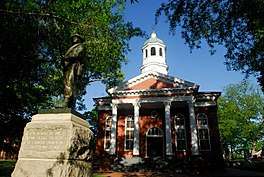
Courthouse monuments
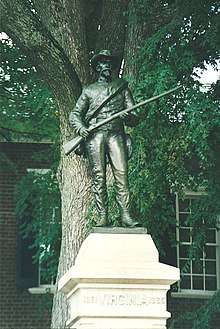
- Abingdon: Confederate Monument (1907), Frederick William Sievers, sculptor[825]
- Charlottesville, Albemarle County Monument, American Bronze Foundry Company (1909)[826]
- Amelia: Confederate Monument (1905)
- Amherst: Amherst County Confederate Monument (1922)
- Appomatox: Confederate Monument (1905)
- Bedford: Confederate Memorial (1935)
- Berryville: Confederate Memorial (1900)
- Bland: Confederate Monument (1911)
- Bowling Green: Confederate Monument (1906)[827]
- Boydton: Monument to Confederate Soldiers of Mecklenburg (1908; rededicated in 2002)
- Charlotte: Charlotte County Confederate Memorial (1901)
- Chatham: Confederate Dead Monument (1899; rededicated in 1967)
- Chesterfield: Confederate Memorial (1903)
- Courtland: Confederate Monument (1905)
- Dinwiddie: Confederate Monument (1909)
- Eastville: Confederate Monument (1913). "Erected by Harmanson-West camp Confederate veterans, the daughters of the Confederacy, and the citizens of the Eastern Shore of Virginia to the soldiers of the Confederacy from Northampton and Accomack Counties. They died bravely in war, or, in peace live nobly to rehabilitate their country. A. D. 1913."[828]
- Emporia: Confederate Memorial (1910)
- Fincastle: Confederate Memorial (1904)[827]
- Floyd: Confederate Monument (1904)
- Front Royal: Confederate Monument (1911)
- Gainesville: Barnard Bee Jr. monument located within Manassas National Battlefield Park.
- Gate City: Confederate Memorial (1988)
- Gloucester: Confederate Monument (1899)
- Halifax: Confederate Memorial (1911)
- Heathsville: Civil War Memorial, Northumberland County (1873)
- Hillsville: Confederate Monument (1907)
- King William: To Our Soldiers of the Confederacy Monument (1901)
- Lancaster: Lancaster County Confederate Monument (1872)
- Lawrenceville: Brunswick County Confederate Monument (1910)
- Leesburg: Confederate Soldier Memorial (1908)
- Louisa: Confederate Monument (1905)
- Lovingston: Confederate Monument (1965)
- Lunenburgh: Confederate Monument (1916)
- Marion: Confederate Monument (1904)
- Mathews: Our Confederate Soldier Monument (1912)
- Monterey: Confederate Monument (1918)
- Montross: Westmoreland County Confederate Monument (1876)
- New Castle: Confederate Monument (1912)
- Nottoway: Confederate Monument (1893)
- Palmyra: Confederate Memorial (1901)
- Pearisburgh: Confederate Medal of Honor Monument (1995). Inscribed is the Jefferson Davis quote, "It is a duty we owe to posterity to see that our children shall know the virtues and rise worthy of their sires."[83]
- Powhatan: Powhatan Troop Confederate Memorial (1999)
- Rocky Mount: Confederate Monument (1910)
- Spotsylvania Courthouse: Confederate Monument (1918)
- Surry: Confederate Monument (1903)
- Sussex: Confederate Monument (1912)
- Tappahannock: Essex County Confederate Monument (1909)
- Tazewell: Confederate Memorial (1903)
- Warm Springs: Confederate Memorial (1922)
- Warrenton: Monument to CSA colonel John S. Mosby (1916)[829]
- Washington: Confederate Monument (1898)
- Williamsburg: Williamsburg Confederate Monument (1908)
- Windsor: Confederate Monument (1905)
Other public monuments
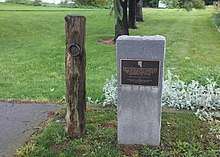
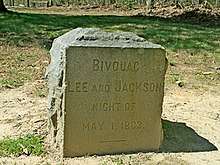
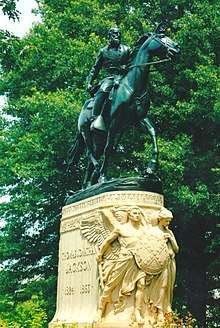
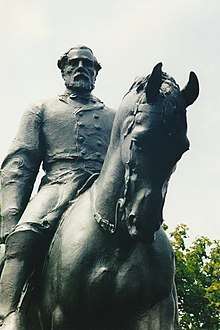
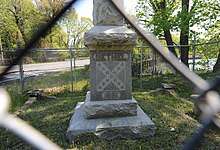
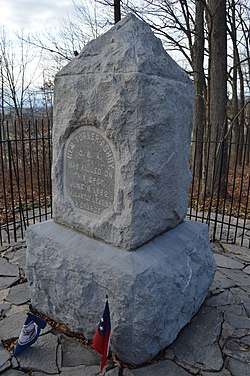
.jpg)
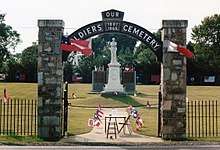
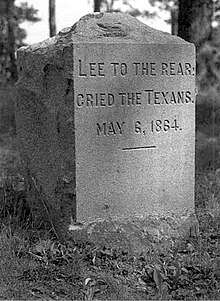
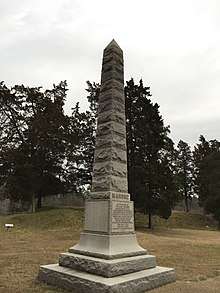
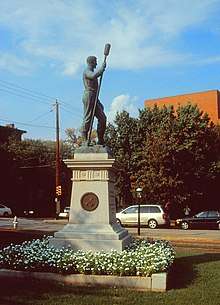
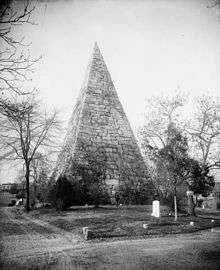
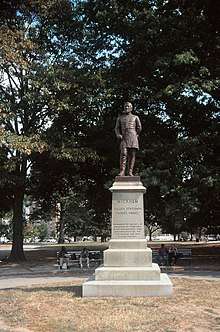
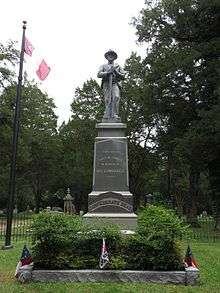
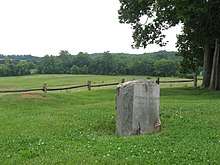
- Alexandria:
- Plaques (1870) of Robert E. Lee and George Washington hang on either side of the altar at Christ Church, where both were parishioners. Following a unanimous vote of its board in 2017, the church announced the plaques would be removed in 2018 once a new location of "respectful prominence" is identified.[830][831][832]
- Appomattox (1899), a statue dedicated to the Confederate dead at the intersection of Washington and Prince streets. The Mayor and the City Council voted unanimously in September 2016 to move the statue to a museum, and are awaiting permission from the Virginia Legislature to do so.[833]
- Arlington: The Confederate Memorial at Arlington National Cemetery was authorized in 1906 by the United States Secretary of War William Howard Taft, and unveiled by President Wilson in 1914.[834]
- Berryville: Memorial (1986) and "hitching post" where Robert E. Lee tethered his horse, Traveller, while Lee "paused on his march to Gettysburg" to attended a church service[835]
- Brandy Station: UDC monument (1998) dedicated to John Pelham[836]
- Bristol: Confederate Soldier Monument (1910)[827]
- Buchanan: Botetourt Artillery Obelisk (1902)[827]
- Buckingham: Confederate Soldiers of Buckingham County (1908)
- Chancellorsville: Confederate monuments at the site of the Battle of Chancellorsville include:
- Jackson Memorial Boulder and Tablet (1888), placed by former members of Stonewall Jackson's staff[837]
- General Thomas J. Jackson Shaft (1888), "On this spot fell mortally wounded Thomas J. Jackson Lt. Gen. C.S.A. May 2nd 1863"[838]
- Lee-Jackson Bivouac Shaft (1903), "Bivouac, Lee and Jackson, night of May 1, 1863"[838]
- Lee-Jackson Bivouac Tablet (1937)[838]
- Brigadier General Elisha F. Paxton Tablet (1980), "In this vicinity Brig. Gen. E. F. Paxton, C.S.A. Aged 35 years, of Rockbridge County, VA. was killed on the morning of May 3, 1863 while leading his command, the Stonewall Brigade in the attack on Fairview"[838]
- Charlottesville
- Robert Edward Lee (sculpture), Henry Shrady and Leo Lentelli, sculptors, 1924. The City Council of Charlottesville unanimously wants it removed; finding that for legal reasons it cannot be immediately removed, the Council had it shrouded in black on August 23, 2017.
- Thomas Jonathan ("Stonewall") Jackson (sculpture), by Charles Keck, erected in 1921. Originally the Charlottesville City Council had intended to leave it, but following the violence of the Unite the Right rally of August 10–11 (provoked by the decision to remove the Lee statue), the Council voted on September 5, 2017, to remove it; pending removal, it is also shrouded in black.[839]
- University of Virginia Cemetery: Confederate monument (1893), by Caspar Buberl.[827] Juslin Greenlee draws a parallel between the erection of this monument, at whose dedication slavery was denied as a cause of the Civil War, and the adjacent cemetery for slaves, which was robbed of bodies for dissection in UVA's School of Medicine and Anatomy.[840]
- Culpeper County: UDC monument (1929) commemorating Confederate victory in the Battle of Brandy Station[841]
- Farmville: Virginia Defenders of State Sovereignty Confederate Soldier Monument (1900)
- Fairfax, Virginia: John Quincy Marr monument, dedicated to the first Confederate officer killed in the Civil War during the Battle of Fairfax Court House (June 1861) Erected 1904.
- Franklin: Confederate Monument (1911)
- Fredericksburg
- Confederate Monument (2009)
- "The Angel of Marye's Heights" Monument, statue of Sergeant Richard Rowland Kirkland giving water to fallen union soldier. (1965)[842][843]
- The Heights at Smith Run (2014)
- Thomas R.R. Cobb Monument and Marker (1888)
- Glen Allen: J.E.B. Stuart Memorial (1888)
- Gloucester: Confederate Monument (1889)
- Goshen Pass: Maury Memorial, stone monument marker (1923)
- Hanover: Confederate Monument (1914)
- Hampton:
- Two monuments at Big Bethel Cemetery, within Langley Air Force Base:[844]
- Big Bethel UDC Monument (1905)[845]
- UDC Monument (1964), commemorating the 100th anniversary of the Battle of Big Bethel[846]
- Hampton National Cemetery: Two small, granite blocks near the burial location of 272 Confederates are inscribed "To Our Confederate Dead"[847]
- Harrisonburg: Turner Ashby Monument (1898), located on Turner Ashby Lane[848]
- Hopewell: Confederate Memorial (1949)
- Lebanon: Confederate Monument (1914)
- Lexington
- Francis H. Smith Confederate Monument (1931)
- Stonewall Jackson Monument and Arch
- Washington and Lee University
- Previously Washington University, was renamed weeks after Robert E. Lee died as the President of the university.[849]
- A large Confederate battle flag and a number of related flags were removed from the Chapel in 2014.[850][851]
- Inside Lee Chapel, in place of an altar, is a large marble statue of Lee, recumbent, wearing Confederate battle gear and resting on a camp bed. (Lee is buried with his family in a mausoleum beneath the chapel.)[852]
- Robert E. Lee Residence.[849]
- Grave of Traveller, Robert E. Lee's horse (1871). Apples are regularly placed on the grave by visitors.[849]
- At Virginia Military Institute is a 1912 bronze replica of a 1910 marble statue of Stonewall Jackson on display at the West Virginia State Capitol. First-year cadets exiting the barracks through the archway are required to honor Jackson's memory by saluting the statue.[853]
- Luray:
- Confederate Monument (1898)
- Page County Confederate Monument (1918)
- Lynchburg:
- Confederate Statue opposite Courthouse.
- Jubal Early Monument (1919)
- Confederate Monument (1900)
- Mechanicsville: Wilcox's Alabama Brigade (1999)
- Mecklenburg County: Confederate statue in front of the Courthouse.
- Middletown: Monument (1919) to Stephen Dodson Ramseur at entrance to Belle Grove Plantation, where he died following the Battle of Belle Grove.[854]
- Mount Jackson: "Our Soldiers Cemetery" statue (1903)
- New Kent: Confederate Monument (1934)
- New Market: This Rustic Pile Monument (1909)
- Newport News: Confederate Soldier Monument (1909)
- Nickelsville: Nickelsville Spartan Band Monument (2000)
- Norfolk: Confederate Monument (1907). According to a statement by Mayor Kevin Cooper Alexander dated August 16, 2017, the Norfolk City Council, in 2015, voted unanimously to leave it in place. In response to the "tragic events in Charlottesville," the question is being reexamined.[855]
- Orange County: Confederate monuments at Wilderness Battlefield include:
- Wilderness Battlefield Tablet (1927), UDC monument[838]
- Colonel James D. Nance Tablet (1912), marks where Nance was killed[838]
- Texas Brigade Shaft (1964), "'Who are you my boys?' Lee cried as he saw them gathering. 'Texas boys,' they yelled, their number multiplying each second."[838]
- "Lee to the Rear!" Tablet (1903), "Lee to the Rear! Cried the Texans. May 6, 1864"[838]
- Parksley: Confederate Monument (1899). Inscriptions read: "They died for the principles upon which all true republics are founded"; "They fought for conscience sake [ sic ] and died for right"; "At the call of patriotism and duty, they encountered the perils of the field and were faithful even unto death." The front of the monument gives this information: "Erected by Harmanson-West Camp Confederate Volunteers in memory of their dead comrades from Accomack and Northampton Counties." The monument was made by Gaddess Brothers of Baltimore of Barre granite, and is about 30 feet tall.[828]
- Petersburg:
- Petersburg National Battlefield
- Hagood's Brigade, a monument in the Petersburg National Battlefield. Text on front: "Here a brigade composed of the 7th battalion, the 11th, 21st, 25th and 27th regiments South Carolina Volunteers, commanded by Brig. Gen. Johnson Hagood, charged Warren’s Federal Army Corps, on the 21st day of August 1864, taking into the fight 740 men, retiring with 273. // No prouder fate than theirs who gave their lives to liberty." Text on rear: "Placed here by Wm. V. Izlar, a survivor of the charge, aided by other South Carolinians."
- Old Men and Boys Monument (1909), in Petersburg National Battlefield. Text: "This stone marks the spot where the old men and boys of Petersburg under Gen. R.E. Colston and Col. F.H. Archer 125 strong on June 9th, 1864 distinguished themselves in a fight with 1,300 Federal Cavalry under Gen. Kautz, gaining time for the defeat of the expedition. // Placed by the Petersburg Chapter U.D.C. May 1909"
- Mahone Monument, Battle of the Crater, Petersburg National Battlefield (1927), erected by the United Daughters of the Confederacy
- Monument where A. P. Hill was killed during the Third Battle of Petersburg[856]
- Monument where John Pegram was killed during the Battle of Hatcher's Run[857]
- Portsmouth: Confederate Monument, listed on the NRHP. Local politicians "have been contemplating the fate of the Confederate statue since 2015, and the town's mayor recently called for it to be moved to a local cemetery instead." In August 2017 the mayor announced that it would be relocated to a cemetery.[858]
- Pulaski: In Memory of the Confederate Soldiers of Pulaski County, 1861–1865 Monument (1906)
- Reams: North Carolina Monument
- Richmond:
- Howitzer Monument, Caspar Buberl, sculptor, (1892)
- A.P. Hill Monument, Caspar Buberl, (1892)[859] Defaced with red paint the night of August 21–22, 2018.[860]
- Confederate Soldiers and Sailors Monument, Libby Hill Park (1894). Defaced with graffiti in 2015.[861]
- The Memorial Granite Pile, Confederate Section, Hollywood Cemetery
- Monument Avenue features monuments of Confederate leaders.[862] Richmond citizens immediately after the war intended to erect three statues of Virginians defending the city (two were killed in the defense), and it was twenty years later before an actual plan was proposed.[863] In 2017, city officials started to hold public meetings for community input on the future of the city's many Civil War monuments and statues.[533]
- Robert E. Lee Monument (1890). This is the only monument on Monument Avenue that is on state rather than city property. In November 2017, Virginia governor Terry McAuliffe, in response to ongoing clashes at the monument, issued emergency regulations which make a permit necessary for any meeting with more than 10 people, and prohibiting firearms.[864]
- Jefferson Davis (1907). Defaced with "Black Lives Matter" in 2015.[625]
- J.E.B. Stuart (1907)
- Thomas "Stonewall" Jackson (1919)
- Matthew Fontaine Maury, "Pathfinder of the Seas" (1929).[863][865]
- Williams Carter Wickham Monument (1891). Paid for by the general's comrades and employees of the Chesapeake and Ohio Railway; placed in Monroe Park. Two young descendants of the late general, who do not necessarily speak for the entire family, are now calling for the removal of this statue.[866]
- Stephenson: Memorial to Lieutenant Colonel Richard Snowden Andrews and Men of 1st Maryland Battery, CSA (1920)
- Strasburg: Confederate Monument (1896), Strasburg Presbyterian Church Cemetery[838]
- Suffolk: Confederate Monument (1889), Cedar Hill Cemetery[867]
- Virginia Beach: Princess Anne County Confederate Heroes Monument (1905)
- Wilderness: Monument (1903) near where Stonewall Jackson's amputated arm was buried[838]
- Winchester: Confederate Soldiers Monument (1916)
Private monuments
- Blairs
- A 51 by 31 feet Confederate flag, near U.S. 29, was according to its erectors the largest one in existence (as of 2017).[868]
- Potomac Falls
- At the Trump National Golf Club there is a monument to the "River of Blood", saying that “Many great American soldiers, both of the North and South, died at this spot, 'The Rapids', on the Potomac River. The casualties were so great that the water would turn red and thus became known as The River of Blood. 'It is my great honor to have preserved this important section of the Potomac River.' – Donald John Trump". Numerous historians have said that no important Civil War action occurred anywhere near that point of the Potomac River. No historian supports Trump.[869]
Parks

- Falls Church: J.E.B. Stuart Park (1961) named for the Confederate General
- Fort Monroe: Jefferson Davis Memorial Park (1956). Dedicated by UDC,[870] the park commemorates the CSA president's two years of imprisonment in the fort.[871]
- Fredericksburg Lee Hill Community Center
- Richmond: Chimborazo Park, site of the Confederate Chimborazo Hospital
Roads
- Alexandria:
- Beauregard Street
- Bragg Street
- Braxton Place
- Breckinridge Place
- Chambliss Street
- Dearing Street
- Donelson Street
- Early Street
- Floyd Street
- French Street
- Frost Street
- Gordon Street
- Hardee Place
- Hume Avenue
- Imboden Street
- Iverson Street
- Jackson Place
- Janney's Lane
- Jordan Street
- Jubal Avenue
- Lee Street[5]
- Longstreet Lane
- Maury Lane
- Pegram Street
- Quantrell Avenue
- Reynolds Street
- Rosser Street
- Van Dorn Street
- Wheeler Avenue
- Annandale:
- John Marr Drive
- Lanier Street
- Rebel Drive
- Blackstone: Jeb Stuart Road
- Bland: Jeb Stuart Street
- Boones Mill: Jubal Early Highway
- Bristow: Robert E. Lee Drive
- Centreville:
- Confederate Ridge Lane
- General Lee Drive
- Chantilly:
- Mosby Highway
- Old Lee Road
- Culpeper:
- General A.P. Hill
- General Jackson Avenue
- General Jeb Stuart Lane
- General Lee Avenue
- General Longstreet Avenue
- General Winder Road
- Damascus: Jeb Stuart Highway
- Fairfax:
- Confederate Lane
- Mosby Woods Drive
- Old Lee Highway[872]
- Pickett Road
- Rebel Run
- Foster: Robert E. Lee Drive
- Hopewell: Robert E. Lee Drive
- Ivor: General Mahone Boulevard
- Lynchburg: Early Street
- Manassas:
- Beauregard Avenue
- Lee Avenue[5]
- Martinsville:
- Jeb Stuart Road
- Jefferson Davis Drive
- Middleburg: John Mosby Highway
- Natural Bridge Station:
- Jeb Stuart Drive
- Robert E. Lee Drive
- New Market:
- Confederate Street
- Lee Street[5]
- Stonewall Street
- Stuart Street
- Petersburg: Confederate Avenue
- Powhatan: Robert E. Lee Road
- Purcellville: Jeb Stuart Road
- Rhoadesville: Jeb Stuart Drive
- Richmond:
- Confederate Avenue
- Monument Avenue
- Mosby Court
- Sandston:
- Carter Avenue
- Confederate Avenue
- Early Avenue
- Garland Avenue
- J.B. Finley Avenue
- Jackson Avenue
- Kemper Court
- Pickett Avenue
- Wilson Way
- Staunton:
- Beauregard Drive
- J.E.B. Stuart Drive
- Stonewall Jackson Boulevard
- Verona: Confederate Street
- Virginia Beach:
- General Beauregard Drive
- General Hill Drive
- General Jackson Drive
- General Lee Drive
- General Longstreet Drive
- Hood Drive
- Waynesboro:
- Davis Road
- Pickett Road
- Robert E. Lee Avenue
- Winchester: Jubal Early Drive
- Woodford:
- Jeff Davis Drive
- Stonewall Jackson Road
Highways
- General Mahone Highway, a large portion of U.S. Route 460, between Petersburg and Suffolk.
- Jefferson Davis Highway, also called Jefferson Davis Memorial Highway. In 2011, the County Board of Arlington County, Virginia, voted to change the name of Old Jefferson Davis Highway, the original route of Jefferson Davis Highway in the county, to Long Bridge Drive, after the board's chairman made disparaging remarks about Davis. However, the name of Jefferson Davis Highway itself, a portion of U.S. 1 that only the Virginia General Assembly could rename, remained unchanged.[873] In February 2016, the Virginia Attorney General's office issued an advisory opinion that the City of Alexandria, unlike the neighboring Arlington County, had the legal authority to change the name of the portion of Jefferson Davis Highway that was within the city's jurisdiction.[874] In September 2016, the Alexandria City Council voted unanimously to change the name of the city's portion of the highway.[875]
- Jubal Early Highway, a section of Virginia Rt. 116 in Franklin County, Virginia[876]
- Lee Highway in Fairfax, Virginia[5]
- Lee Jackson Memorial Highway in Chantilly, Virginia.
- Stonewall Jackson Highway
Schools
- Arlington: Washington-Lee High School (1925). In 2017, just after the Unite the Right Rally, a campaign started to have the school renamed.[877]
- Bridgewater: Turner Ashby High School, named for CSA colonel Turner Ashby, the "Black Knight of the Confederacy". The school's football team are the "Black Knights".[878]
- Bristol:
- Stonewall Jackson Elementary School (1948)
- Washington-Lee Elementary School (1968)
- Bull Run: Stonewall Jackson High School (1972)
- Clear Brook: Stonewall Elementary School (1960)
- Fairfax:
- Fairfax High School phased out its Johnny Rebel mascot, Confederate imagery and flags and renamed the "Confederattes" drill team in 1986 after complaints from black students. They retained the Rebels team name.[879]
- Lanier Middle School, named for CSA Officer Sidney Lanier (poet, musician)
- Lees Corner Elementary, named for Lee family (including Robert E. Lee) as owners of Sully Plantation (1986)[880]
- Mosby Woods Elementary School, named for John S. Mosby and cavalry Mosby's Raiders, school's athletics uses Raiders.
- Falls Church: J.E.B. Stuart High School, whose name is scheduled to be changed in 2019.[881]
- Fredericksburg: Lee Hill Elementary School (1952)[5]
- Hampton:
- Jefferson Davis Middle School (1960), scheduled to have its name changed in 2018.[881]
- The name of the Campus at Lee, a collection of city schools, had its name changed to Hampton City Schools Adult and Alternative Learning Center in 2017.[882] The name change is scheduled to be completed in 2018.[881]
- Henrico: Douglas S. Freeman High School. Its athletic teams are nicknamed the "Rebels." The school has retired its "Rebel man" mascot.[883]
- Hurley: Hurley High School. Its athletic teams are nicknamed the "Rebels." Confederate iconography, including the Confederate Battle Flag, is prominent throughout the school.[884]
- Lexington: Washington and Lee University. See above, under "Other public monuments".
- Manassas
- Stonewall Middle School (1974)
- Stonewall Jackson High School (1973)
- Mathews Lee-Jackson Elementary School
- Mechanicsville:
- Lee-Davis High School (1958). The athletic teams of the school, which was whites-only when it opened, are the Confederates, and the school band plays Dixie.[505] A petition drive to change the name has not been successful as of 2018.[885]
- Stonewall Jackson Middle School (1969). The school's athletic teams are nicknamed the "Rebels."[886]
- Montross: Washington and Lee High School
- Quicksburg: Stonewall Jackson High School (1959)
- Richmond: J.E.B. Stuart Elementary School, whose name is scheduled to be changed in 2018.[881]
- Spotsylvania Courthouse:
- Springfield:
- Robert E. Lee High School (1958)
- Sangster Elementary named for a prominent slaveholding family loyal to the Confederacy[889]
- Stuart: Stuart Elementary School (1938)
Former
- Bailey's Crossroads: J. E. B. Stuart High School (1958). Following protests by students and alumni that began in June 2015, the school board voted in July 2017 to rename the school by the beginning of the 2019 school year.
- Charlottesville:
- In May 2017 the City Council of Charlottesville voted to remove and sell its statue of Gen. Robert E. Lee, and renamed Lee Park, where the statue stands, as Emancipation Park.[890] The removal has been halted for six months by a court injunction, in response to a suit by SCV.[891][892]
- In August 2017 the City Council unanimously voted to shroud the statues of Lee and Stonewall Jackson in black.[893]
- The University of Virginia Board of Visitors (trustees) voted unanimously in September 2017 to remove two plaques from the university's Rotunda that honored students and alumni who fought and died for the Confederacy in the Civil War.[894]
- Fairfax County: Former J. E. B. Stuart High School reopened as Justice High School Sep. 2018. The school is near Munson Hill, Stuart's headquarters. It was given Stuart's name in 1958 as part of the county's "massive resistance" against the U.S. Supreme Court's order to end racial segregation of public schools.[889][895][896]
- Lexington:
- In 2014, a large Confederate battle flag and a number of related state flags were removed from Lee Chapel at Washington and Lee University.[850][851]
- R.E. Lee Memorial Church, an Episcopal church where Lee worshipped, in August 2017 restored its original name of Grace Episcopal Church.[897][898]
- Lynchburg: Statue of Confederate veteran George Morgan Jones on the campus of Randolph College. Installed in 1912 and removed in August 2017.[899]
- Petersburg: Three schools are being renamed July 1, 2018.[900]
- A.P. Hill Elementary will be known as Cool Spring Elementary
- Robert E. Lee Elementary will become Lakemont Elementary
- J.E.B. Stuart Elementary will become Pleasants Lane Elementary.
- Richmond: J.E.B. Stuart Elementary School (1922)[901] was renamed Barack Obama Elementary School in 2018.[902]
- Roanoke, Virginia: Stonewall Jackson Middle School was renamed John P. Fishwick Middle School in July, 2018.[903]
Washington State
There is at least one building in Washington state named for an officer who served the Confederacy.[5]
- Bellingham: Pickett House, listed on the National Register of Historic Places.
.jpg)
At least two private properties contain a Confederate memorial or fly a CSA flag:
- Clark County: Near Ridgefield is Jefferson Davis Park (2007), established by the SCV to hold the Jeff Davis Highway markers from Blaine and Vancouver. Flags of the Confederacy are also displayed there.[904][905]
- Seattle: United Confederate Veterans Memorial, Lake View Cemetery. Erected in 1926 by United Daughters of the Confederacy.[906] Made of rock from the Confederate monument Stone Mountain, Georgia.[907]
- In 2017 Seattle Mayor Ed Murray called for it to be taken down, saying it represents "historic injustices" and is a symbol of hate, racism, and violence. After the Mayor's statement, the Cemetery closed for several days because of threats related to the monument.[908]
- The monument has been vandalized repeatedly. In 2005, the insignias (metal plaques) were stolen, though later recovered. They have been vandalized twice since 2005. "Several parts of the 10-ton piece of granite have been smashed, including a portion of the monument's inscription, insignia, and relief of Robert E. Lee." Following the Charlottesville "Unite the Right" rally of 2015, "Fuck White Supremacy" was painted on it.[909]
Former
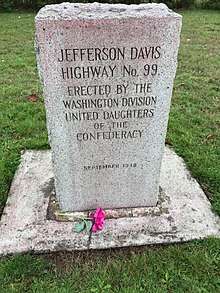
- Blaine and Vancouver: Stone markers at both ends of the state, designating Old Highway 99 the "Jeff Davis Highway", were erected in the 1930s. They were removed[910] and placed at the private Jefferson Davis Park adjacent to the town of Ridgefield, beside I-5.[911]
- Bellingham: Pickett Bridge, plaque commemorating the earlier wooden bridge erected by order of Pickett over Whatcom Creek. Plaque erected in 1920, was removed August 18, 2017, along with signs leading to Pickett House.[912]
- Seattle: Robert E. Lee Tree, was one of many trees in Seattle's Ravenna Park, dedicated to persons of note. The tree along with the plaque were removed in 1926.[913][914]
- East Wenatchee: Robert E. Lee Elementary School (1955) School district rejected a name change in 2015,[915] and again in 2017.[916] The school district voted to changed the name from Robert E. Lee Elementary School to Lee Elementary School in 2018.[917]
West Virginia
There are at least 17 public spaces with Confederate monuments in West Virginia.[5]
State Capitol
- Bust of Stonewall Jackson (born in West Virginia, at that time part of Virginia) by Bryant Baker, located "in the rotunda of the West Virginia State Capitol." (1959)[918]
- Statue of Stonewall Jackson by Moses Ezekiel[919] on the State Capitol grounds (1910) placed by UDC Chapter No. 151[920]
Monuments
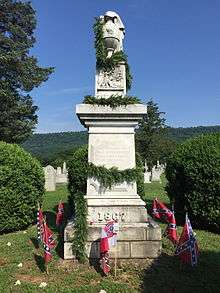
- Clarksburg: Bronze equestrian statue of Stonewall Jackson created by Charles Keck (1953) by the United Daughters of the Confederacy (UDC). Jackson was born in Clarksburg.
- Charles Town: A bronze plaque was erected in 1986 by the UDC, "in honor and memory of the Confederate soldiers of Jefferson County, who served in the War Between the States," next to the entrance to the Jefferson County Courthouse. The local newspaper, Spirit of Jefferson, and a group of local African Americans have called for its removal.[921] On September 7, 2017, the Jefferson County Commission voted 5-0 to let the plaque be.[922] It was in Charles Town, in the Jefferson County Courthouse, that abolitionist John Brown was tried; he was hung nearby.[923]
- Charleston - See West Virginia State Capitol, above.
- Bust of Stonewall Jackson by Bryant Baker, located "in the rotunda of the West Virginia State Capitol." (1959)[918]
- Statue of Stonewall Jackson by Moses Ezekiel[924] on the state capitol grounds (1910) placed by UDC Chapter No. 151[920]
- Harpers Ferry: Hayward Shepherd Monument (1931). Although Shepherd was a black freeman working for the railway when killed in John Brown's raid on Harper's Ferry, the monument was erected by UDC and Sons of Confederate Veterans (SCV). They called the project the "Faithful Slave Memorial" for many years and saw it as a way to emphasize their idea that blacks enjoyed being slaves and that men like Shepherd were victims of those seeking to free slaves.[925]
- Hinton: Confederate Soldier Monument, Summers County Courthouse (dedicated May 1914)[926] The base of the monument carries the inscription: "(North base:) This monument erected in honor of American valor as displayed by the Confederate soldiers from 1861 to 1865, and to perpetuate to remotest ages the patriotism and fidelity to principles of the heroes who fought and died for a lost cause. (East base:) sacred to the memory of the noble women of the Confederacy, who suffered more and lost as much, with less glory, than the Confederate soldier. (South base:) erected in the year 1914 by Camp Allen Woodrm Confederate veterans and Camp Bob Christian sons of Confederacy veterans and their friends. (West base:) This monument is dedicated to the Confederate soldiers of Greenbrier and New River valleys who followed Lee and Jackson.[927]
- Lewisburg: Confederate Monument (1906) The Confederate "monument was erected by the United Daughters of the Confederacy at a cost of $2,800. The monument was originally located on the campus of the Greenbrier College, but moved to its present location when U.S. Route 60 was relocated."[928] It is now located on the lawn of the old public library in Lewisburg. Some residents have suggested interpretive signage for the statue.[929] The inscription on the base reads, "In memory of our Confederate dead."[930]
- Mingo: Confederate Soldier Monument (1913/2013) The inscription reads in part, "TO THE MEMORY OF THE CONFEDERATE SOLDIERS OF RANDOLPH COUNTY AND VICINITY THIS INCLUDES ALL SOLDIERS WHO DIED IN VALLEY MOUNTAIN"[931]
- Parkersburg: Confederate Soldier Monument, (1908) The monument was created by Leon Hermant and the inscription reads in part, " IN MEMORY OF OUR CONFEDERATE DEAD ERECTED BY PARKERSBURG CHAPTER UNITED DAUGHTERS OF CONFEDERACY"[932]
- Romney: First Confederate Memorial (1867) Carved on the main facade are the words, "The daughters of Old Hampshire erect this tribute of affection to her heroic sons who fell in defense of Southern Rights."[933]
- Union: Monroe County Confederate Soldier Monument (1901); marble statue inscribed "There is a true glory and a true honor. The glory of duty done, the honor of integrity of principle. R. E. Lee"[934]
Inhabited places
Parks and water features
- Weston: Stonewall Jackson Lake State Park (1990) named for Stonewall Jackson Lake named for Confederate General Stonewall Jackson.
Roads
- Charles Town:
- Beauregard Boulevard
- Lee Way[5]
- Charleston:
- Beauregard Street
- Jackson Street
- Lee Street[5]
- Dixie Street
- Craigsville: General Lee Street
- Elkins: Robert E. Lee Avenue
- Flatwoods: Stonewall Jackson Highway
Schools
- Charleston: Stonewall Jackson Middle School. Occupies the building that housed the former Stonewall Jackson High School.
Wisconsin
- Prairie du Chien: United Daughters of the Confederacy (UDC) monument to Jefferson Davis at Fort Crawford Cemetery Soldiers' Lot. Davis served briefly at Fort Crawford.[937] The text on the plaque reads, "JEFFERSON DAVIS, 1808 - 1889, Lieutenant United States Army, Assigned Fort Crawford 1831, Served here with distinction during Black Hawk War, Hero in Mexican War 1846-1848, United States Congressman, Senator, Secretary of War, President Confederate States of America, 1861-1865, Erected by The United Daughters of the Confederacy"[938]
- Wisconsin Dells: The Confederate spy Belle Boyd (1844-1900) is buried in Spring Grove Cemetery in Wisconsin Dells. She would go on tour in the United States and speak about being a spy for the Confederacy. Boyd also wrote a book about her career. Belle Boyd was to speak at a Grand Army of the Republic (GAR) post in Kilbourn City, Wisconsin (now Wisconsin Dells) when she died from a heart attack. Members of the local GAR post served as pallbearers at her funeral and was buried at the cemetery. Her grave is marked with a Confederate flag.[939]
Former
- Madison: A plaque and a larger monument were ordered removed from the 'Confederate Rest' section of the city's Forest Hill Cemetery in August 2017. The memorials had honored 140 Confederate soldiers who died in 1862 while in captivity at nearby Camp Randall.[940][941][533]
Wyoming
Natural Features
Yellowstone National Park: The Lamar River (named 1884–85) is named for L.Q.C. Lamar, a secessionist who drafted the instrument of Mississippi's secession and raised a regiment for the Confederates with his own money. He served as a Confederate ambassador to Russia. The river was named while he served as the United States Secretary of the Interior after the war. The Lamar Valley and other park features or administrative names which contain Lamar are derived from this original naming.[942]
International
Brazil
- In 1865, at the end of the American Civil War, a substantial number of Southerners left the South; many moved to other parts of the United States, such as the American West, but a few left the country entirely. The most popular country of Southerners emigration was Brazil, which still allowed slavery and wanted to encourage cotton production.[943] These emigrants were known as Confederados. A Confederate monument was erected in the city of Americana, São Paulo state, Brazil.[944]
Canada
- Kitchener, Ontario: Eastwood Collegiate Institute (1956), a public high school, replaced its Johnny Rebel mascot and Confederate imagery, perceived as associated with white bigotry, with Rebel Lion in 1999. The school retains the Rebel name for its teams.
- Montreal, Quebec: A plaque on a Hudson's Bay Company store commemorating Jefferson Davis' brief stay in the city was installed by UDC in 1957; it was removed in 2017 following the attack against counter protesters committed by a white supremacist in Charlottesville.[945][946]
Ireland
- Tuam: Ireland commemorated CSA Major Richard W. Dowling, who was born in the Tuam, with a bronze memorial plaque on the Town Hall bearing his image and life story. Text of plaque: "Major Richard W. (Dick) Dowling C.S.A., 1837–1867 Born Knock, Tuam; Settled Houston Texas, 1857; Outstanding business and civic leader; Joined Irish Davis Guards in American Civil War; With 47 men foiled Invasion of Texas by 5000 federal troops at Sabine Pass, 8 Sept 1863, a feat of superb gunnery; formed first oil company in Texas; Died aged 30 of yellow fever. This plaque was unveiled by Col. J.B. Collerain 31 May 1998"
Scotland
- Edinburgh: Dean Cemetery, obelisk for Scottish-born CSA Colonel Robert A. Smith, with a Confederate marker and Confederate flags.[947]
See also
- African-American history
- Confederate History Month
- Confederate Memorial Day
- Confederate holidays
- Culture of the Southern United States
- History of the Southern United States
- King Cotton
- Lee High School
- List of American Civil War generals (Confederate)
- List of Civil War Battles
- List of Civil War Discovery Trail sites
- List of memorials and monuments at Arlington National Cemetery
- List of memorials to Jefferson Davis
- List of memorials to Robert E. Lee
- List of memorials to Stonewall Jackson
- List of memorials to the Grand Army of the Republic
- List of monuments erected by the United Daughters of the Confederacy
- List of monuments of the Gettysburg Battlefield
- List of Presidents of the United States who owned slaves
- List of ships of the Confederate States Navy
- List of Mexican-American War monuments and memorials
- List of Union Civil War monuments and memorials
- Lost Cause of the Confederacy
- Memorials to Abraham Lincoln
- Modern display of the Confederate flag
- Monument and memorial controversies in the United States
- Neo-Confederate
- Racism in the United States
- Racism in United States politics
- Racial segregation in the United States
- Robert E. Lee Day
- Robert E. Lee Elementary School (disambiguation)
- Slavery in the United States
- White nationalism
- White supremacy
Notes
- ↑ This chart is based on data from an SPLC survey which identified "1,503 publicly sponsored symbols honoring Confederate leaders, soldiers or the Confederate States of America in general." The survey excluded "nearly 2,600 markers, battlefields, museums, cemeteries and other places or symbols that SPLC deemed largely historical in nature"[5]
- ↑ Fitzgerald was formed in 1895 for veterans of the war, from the North and the South. Streets running North/South on the west side of the city were named after Confederate ships and generals, whereas the ones on the east side were named after Union ships and generals. See Fitzgerald, Georgia#History.
- ↑ In May 1970 the memorial was hit by a truck and destroyed. The money from the insurance company was not sufficient to restore it. Widener, p. viii
References
- 1 2 Gunter, Booth; Kizzire, Jamie (April 21, 2016). Gunter, Booth, ed. "Whose heritage? Public Symbols of the Confederacy". Southern Poverty Law Center. Retrieved October 6, 2017.
In an effort to assist the efforts of local communities to re-examine these symbols, the SPLC launched a study to catalog them. For the final tally [of 1,503], the researchers excluded nearly 2,600 markers, battlefields, museums, cemeteries and other places or symbols that are largely historical in nature.
- ↑ "The state leading the way in removing Confederate monuments? Texas".
- 1 2 "Confederate Statues Were Built To Further A 'White Supremacist Future'". npr.org. Retrieved 21 September 2017.
- 1 2 3 Cox, Karen L. (16 August 2017). "Analysis – The whole point of Confederate monuments is to celebrate white supremacy". Retrieved 21 September 2017 – via www.washingtonpost.com.
- 1 2 3 4 5 6 7 8 9 10 11 12 13 14 15 16 17 18 19 20 21 22 23 24 25 26 27 28 29 30 31 32 33 34 35 36 37 38 39 40 41 42 43 44 45 46 47 48 49 50 51 52 53 54 55 56 57 58 59 60 61 62 63 64 65 66 67 68 69 70 71 72 73 74 Gunter, Booth; Kizzire, Jamie (April 21, 2016). Gunter, Booth, ed. "Whose heritage? Public Symbols of the Confederacy" (PDF). Southern Poverty Law Center. Retrieved August 15, 2017.
- ↑ CNN (August 16, 2017). "Actually, Robert E. Lee was against erecting Confederate memorials". WPTV. Retrieved February 10, 2018.
- ↑ Maxwell, Hu (1897). History of Hampshire County, West Virginia: from its earliest settlement to the present. Morgantown, W. Va: A.B. Boughner, printer.
- ↑ "Monuments and Memorials". Vicksburg National Military Park. National Park Service. Retrieved 26 September 2017.
- ↑ Leib, Jonathan I.; Webster, Gerald R.; Webster, Roberta H. (2000-12-01). "Rebel with a cause? Iconography and public memory in the Southern United States". GeoJournal. 52 (2): 303–310. doi:10.1023/A:1014358204037. ISSN 0343-2521.
- ↑ American Historical Association, AHA Statement on Confederate Monuments (August 2017)
- ↑ "Durham Confederate statue: tribute to dying veterans or political tool of Jim Crow South?". heraldsun.com. Retrieved 21 September 2017.
- ↑ Confederate Monuments and Civic Values in the Wake of Charlottesville. Dell Upton, Society of American Historians, 13 September 2017
- ↑ Confederate monuments: What to do with them?. Grier, Peter. Christian Science Monitor, 22 August 2017
- ↑ Dotinga, Randy (2017-06-14). "Inside the hidden history of confederate memorials". Christian Science Monitor. ISSN 0882-7729. Retrieved 2017-09-05.
- ↑ Winsboro, Irvin D.S. (2016). "The Confederate Monument Movement as a Policy Dilemma for Resource Managers of Parks, Cultural Sites, and Protected Places: Florida as a Case Study" (PDF). The George Wright Forum. 33: 217–29.
- 1 2 3 4 5 Wiggins, David N. (2005). Remembering Georgia's Confederates. Arcadia. pp. 106, 108, 109, 117. ISBN 9780738518237.
- 1 2 Confederate Monument in Forsyth Park Archived May 31, 2011, at the Wayback Machine., City of Savannah website, accessed April 24, 2010
- ↑ Mills, Cynthia; Simpson, Pamela H. (2003). Monuments to the Los Cause: Women, Art, and the Landscapes of Southern Memory. University of Tennessee Press. p. . ISBN 978-1572332720.
- ↑ Gulley, H.E. (1993). "Women and the Lost Cause: preserving a Confederate identity in the American Deep South". Journal of Historical Geography. 19 (2): 125–41. doi:10.1006/jhge.1993.1009.
- ↑ Fisher, Marc (2017-08-18). "Why those Confederate soldier statues look a lot like their Union counterparts". Washington Post. ISSN 0190-8286. Retrieved 2017-09-16.
Because of technological innovations in the granite and bronze industries, the price of these statues came way down
- ↑ "Whose Heritage? Public Symbols of the Confederacy". Southern Poverty Law Center. April 21, 2016. Retrieved September 15, 2017.
The second spike began in the early 1950s and lasted through the 1960s, as the civil rights movement led to a backlash among segregationists. These two periods also coincided with the 50th and 100th anniversaries of the Civil War
- ↑ Holpuch, Amanda; Chalabi, Mona (2017-08-16). "'Changing history'? No – 32 Confederate monuments dedicated in past 17 years". The Guardian. ISSN 0261-3077. Retrieved 2017-08-26.
- ↑ "Mecklenburg Confederate statue still stands after Anonymous announces threat | South Boston Virginia News | TheNewsRecord.com". www.sovanow.com. Retrieved 2018-08-22.
- ↑ "Confederate statue removed from University of Louisville campus rededicated in Kentucky". Fox News. 2017-05-30. Retrieved 2018-08-22.
- ↑ "FPAN - Destination: Civil War - - Ocala". fpan.us. Retrieved 2018-08-22.
- ↑ "Rededicating a Confederate monument to peace". myajc. Retrieved 2018-08-22.
- 1 2 3 4 5 6 7 8 9 10 11 12 13 14 15 16 17 18 Widener, Ralph W. (1982). Confederate monuments: Enduring symbols of the South and the War Between the States. Andromeda Associates. OCLC 8697924.
- 1 2 3 4 5 6 7 John J. Winberry (2015). "'Lest We Forget': The Confederate Monument and the Southern Townscape". Southeastern Geographer. 55 (1): 19–31 – via Project MUSE. (Subscription required (help)).
- ↑ "US Confederate monuments: What is the debate about?". www.aljazeera.com. Retrieved 4 September 2017.
- 1 2 3 "BTW, These Four States Legally Protect Confederate Monuments". Impact. Retrieved 4 September 2017.
- ↑ Bureau, Bobby Harrison Daily Journal Jackson. "Mississippi law prohibits removal of historical markers". djournal.com. Retrieved 4 September 2017.
- ↑ Cote, Rachel Vorona. "Heritage Act Keeps Confederate Flags Flying in South Carolina". Jezebel. Retrieved 2017-09-05.
- ↑ "Georgia state law makes it difficult to completely remove or hide Confederate monuments". 13wmaz.com. Retrieved 4 September 2017.
- ↑ Olivo, Antonio (2017-08-25). "After Charlottesville, Va. Democrats see opening to change 114-year-old monuments law". The Washington Post. ISSN 0190-8286. Retrieved 2017-08-27.
- 1 2 Reynolds, Jacob (August 17, 2017). "Georgia State Law Makes It Difficult to Completely Remove or Hide Confederate Monuments". WMAZ. Retrieved November 10, 2017.
- ↑ "A majority of Americans want to preserve Confederate monuments: Reuters/Ipsos poll". 21 August 2017. Retrieved 20 October 2017 – via Reuters.
- ↑ "Reuters/Ipsos Data: Confederate Monuments". ipsos.com. Retrieved 20 October 2017.
- ↑ Edwards-Levy, Ariel (23 August 2017). "Polls Find Little Support For Confederate Statue Removal -- But How You Ask Matters". Retrieved 20 October 2017 – via Huff Post.
- ↑ "HuffPost: Confederate Flag, August 15–16, 2017 – 1000 US Adults" (PDF). huffingtonpost.com. Retrieved 20 October 2017.
- ↑ Ford, Matt (August 17, 2017). "Will Congress Remove Confederate Statues From the Capitol?". The Atlantic. Retrieved August 19, 2017.
- ↑ DeBonis, Mike (June 23, 2015). "A field guide to the racists commemorated inside the U.S. Capitol". Washington Post. Retrieved August 20, 2017.
- 1 2 Brockell, Gillian; Brockell, Gillian (August 16, 2017). "How statues of Robert E. Lee and other Confederates got into the U.S. Capitol". The Washington Post. ISSN 0190-8286. Retrieved August 20, 2017.
- ↑ "Robert E. Lee". Architect of the Capitol. 2016-04-29. Retrieved 2017-08-28.
- ↑ "Zebulon Vance". Architect of the Capitol. Retrieved 2017-08-28.
- ↑ "Uriah Milton Rose". Architect of the Capitol. Retrieved 2018-04-07.
- ↑ Florida Senate (March 19, 2018). "SB 472: National Statuary Hall". Retrieved March 21, 2018.
- ↑ "Joseph Wheeler". Architect of the Capitol. Retrieved 2017-08-28.
- ↑ "Alexander Hamilton Stephens". Architect of the Capitol. Retrieved 2017-08-28.
- ↑ "Wade Hampton". Architect of the Capitol. Retrieved 2017-08-28.
- ↑ "Jefferson Davis". Architect of the Capitol. Retrieved 2017-08-28.
- ↑ "James Zachariah George". Architect of the Capitol. Retrieved 2017-08-28.
- ↑ "Helen Keller". Architect of the Capitol. Retrieved 2017-08-19.
- ↑ Pilitowski, Tom. "Information about the Stone Mountain Half Dollar coin". U.S. Rare Coin Investments. Retrieved August 23, 2017.
- ↑ "1937 Four-Cent Army Stamp: Robert E. Lee, Thomas "Stonewall" Jackson, and Stratford Hall". hobbylark.com. Retrieved August 21, 2017.
- ↑ "Robert E. Lee on U.S. Postage Stamps". civilwartalk.com. Retrieved August 21, 2017.
- 1 2 Sims, Cliff (2015-06-30). "Pentagon won't rename Alabama's Ft. Rucker, named after Confederate officer". Yellowhammer News. Yellowhammer Multimedia. Retrieved 2017-08-26.
- ↑ Bergengruen, Vera (2017-08-16). "Ten major Army bases honor Confederate generals, and there are no plans to change that". McClatchy DC Bureau. Retrieved September 3, 2017.
- ↑ "Camp Beauregard, near Alexandria Louisiana in World War II". Alexandria-louisiana.com. Retrieved June 17, 2014.
- ↑ "The world's biggest military bases". Army Technology. September 4, 2013. Retrieved August 17, 2017.
- ↑ Malanowski, Jamie (June 14, 2013). "Why Fort Hood needs a new name". The Dallas Morning News. Retrieved August 17, 2017.
- ↑ Carola, Chris (August 17, 2017). "2 NY lawmakers: Strip Robert E. Lee's name from West Point". The Washington Post. Retrieved August 28, 2017.
- 1 2 Witte, Brian (August 23, 2017). "Confederate names at Naval Academy could face rough seas". Fox News. Retrieved October 5, 2017.
- ↑ Diana Fontaine Maury-Corbin "Life of Matthew Fontaine Maury USN & CSN" Life of Matthew Fontaine Maury, U.S.N. and C.S.N.
- ↑ "Troopships of World War II: Liberty Ships". www.skylighters.org.
- ↑ Subberwal, Kaeli (2017-08-18). "Several States Have Erected Laws To Protect Confederate Monuments". Huffington Post. Retrieved 2017-09-01.
- ↑ Edgemon, Erin (2017-08-17). "AG files lawsuit against Birmingham over Confederate monument". AL.com. Retrieved 2017-09-01.
- ↑ "Alabama Lawmaker sponsors bills to repeal legislation preserving Confederate Monuments". The Birmingham Times. 2017-08-28. Retrieved 2017-09-01.
- ↑ Alabama Confederate Monument. Archived March 6, 2012, at the Wayback Machine., Conservation Solutions Inc., accessed April 24, 2010
- ↑ Charles, Dean (24 June 2015). "Alabama Gov. Bentley removes Confederate flags from Capitol grounds". The Birmingham News. Retrieved 24 June 2015.
- ↑ Jefferson Davis Star-Montgomery, Alabama. Waymarking.com. Accessed August 16, 2017
- ↑ Parish (November 19, 2004), Alabama State Capitol, Montgomery, Bronze star marking where Jefferson Davis was inaugurated as the first president of the CSA on the front steps, Emporis, retrieved December 10, 2017
- ↑ Jefferson Davis – Montgomery, Alabama. Waymarking.com. Accessed August 16, 2017
- 1 2 3 4 "These 5 states still use Confederate symbols in their flags". Msnbc.com. Retrieved August 19, 2017.
- 1 2 Coski, John M. (2005). The Confederate Battle Flag: America's Most Embattled Emblem. United States of America: First Harvard University Press. pp. 80–81. ISBN 978-0-674-01983-6. Archived from the original on 2016-03-09. Retrieved March 8, 2016.
The flag changes in Mississippi, Alabama, and Florida coincided with the passage of formal Jim Crow segregation laws throughout the South. Four years before Mississippi incorporated a Confederate battle flag into its state flag, its constitutional convention passed pioneering provisions to 'reform' politics by effectively disenfranchising most African Americans.
- 1 2 3 "State of Alabama 2018 Official State Holidays" (PDF). Retrieved September 2, 2018.
- ↑ White, Marjorie Longenecker, Richard W. Sprague, G. Gray Plosser Jr. Editors, Downtown Birmingham" Architectural and Historical Walking Tour Guide, Birmingham Historical Society, The First National Bank of Birmingham, 1980 p. 91
- ↑ "Confederate Soldiers Monument, Ashville, Alabama". Civilwaralbum.com. Retrieved August 19, 2017.
- 1 2 3 4 Davis, Michael. In Remembrance: Confederate Funerary Monuments in Alabama and Resistance to Reconciliation, 1884–1923. Master's thesis, Auburn University. Accessed August 15, 2017
- ↑ "The Choctaw County Courthouse". Rootsweb.ancestry.com. Retrieved August 19, 2017.
- ↑ "Things to Do – Pickens County Alabama". Pickenscountyal.com. Retrieved August 19, 2017.
- ↑ Confederate Veterans Memorial – Centre, AL Waymarking.com. Accessed August 18, 2017
- ↑ "National Register of Historic Places, Centreville Historic District, registration form" (PDF).
- 1 2 3 4 Winberry, John J. (1983). ""Lest We Forget": The Confederate Monument and the Southern Townscape". Southeastern Geographer. 23 (2): 107–21. doi:10.1353/sgo.1983.0008. ISSN 1549-6929.
- ↑ Eufaula and Barbour County in Vintage Postcards. Arcadia. 2004. p. 97. ISBN 9780738515953.
- ↑ "Confederate Memorial Monument – Decatur, AL – American Civil War Monuments and Memorials". Waymarking. Retrieved August 19, 2017.
- ↑ Moore, Ellis O. Francis Moore: A Musician's Life. Xlibris, 2007, p. 303
- ↑ "History & Race in Florence". Projectsaysomething.org. June 17, 2016. Retrieved August 19, 2017.
- ↑ Gattis, Paul (May 16, 2017). "Remove Confederate monument in Huntsville, petition says". AL.com. Retrieved August 16, 2017.
- ↑ Shumate, Joyce Nunn. The Confederate monument in Jasper, Alabama on the national register of historic places. Accessed August 15, 2017
- ↑ Confederate Monument. Our Southern Home (May 6, 1908). Accessed August 16, 2017
- ↑ "Nicola Marschall". HMdb.org. Retrieved October 1, 2018.
- ↑ Lawrence County Confederate Veterans Memorial – Moulton, AL. Waymarking.com. Accessed August 18, 2017
- ↑ Colbert County Confederate Veterans Memorial – Tuscumbia, AL Waymarking.com Accessed August 16, 2017
- ↑ Major John Pelham – Anniston, AL Waymarking.com. Accessed October 6, 2017
- ↑ Suerth, Jessica (August 17, 2017). "Confederate statues and memorials to be removed across US". CNN. Retrieved August 17, 2017.
- ↑ Almond, Mark (July 2, 2015). A close-up look at Birmingham's embattled Confederate monument. Al.com. Accessed August 15, 2017
- ↑ "Alabama". HMdb.org. Retrieved October 2, 2018.
- ↑ Edgemon, Erin (July 16, 2016). "Alabama police officer crashes into Confederate Monument while on patrol". AL.com. Retrieved August 16, 2017.
- ↑ Montgomery, David (August 6, 2017). "A car crash topples a Confederate statue – and forces a Southern town to confront its past". The Week. Retrieved August 16, 2017.
- ↑ U.S. Geological Survey Geographic Names Information System: Demopolis Public Square
- ↑ Johnston, Patrick (June 11, 2010). "Confederate monument needs to be moved". The Eufaula Tribune. Retrieved August 16, 2017.
- ↑ "James Cantey". HMdb.org. Retrieved October 7, 2018.
- ↑ Graham, Kelsey (August 2, 2013). Fort Payne celebrates Confederate Monument. Times Free Press. Accessed August 15, 2017
- ↑ Crownover, Danny (April 1, 2016) The Vagabond – 109 Years Ago Unveiling of the Emma Sansom Statue. Gadsden Messenger. Accessed August 15, 2017
- ↑ Crownover, Danny (June 27, 2014). The Vagabond: A decision in Gadsden. Gadsden Messenger. Accessed August 16, 2017
- ↑ Historic Downtown Greenville, Alabama. Brochure. Greenville-alabama.com. Accessed August 16, 2017
- ↑ Henry County Confederate Memorial. Hmdb.org Accessed August 16, 2017
- 1 2 Tutor, Phillip (January 17, 2016). Throughout the South, memorials with difficult histories pose vexing problems. Anniston Star. Accessed August 16, 2017
- ↑ "Confederate Memorial – Midway, AL – Alabama Historical Markers". Waymarking.com. Retrieved 26 September 2017.
- ↑ North American Preservation of Monuments. Alabama. Napom.org. Accessed August 16, 2017
- ↑ Sons of Confederate Veterans: Raphael Semmes Camp 11. Statue of Admiral Semmes Overlooking Bankhead Tunnel in Downtown Mobile. Scvsemmes.org. Accessed August 16, 2017
- ↑ "Mobile National Cemetery". U.S. Department of Veterans Affairs. August 28, 2017.
- ↑ "Dexter Avenue". HMdb.org. Retrieved October 2, 2018.
- ↑ Yawn, Andrew J. "MPS to 'look at' relocating school's Robert E. Lee statue". The Montgomery Advertiser. Retrieved 2018-06-14.
- ↑ Miller, Rex, Croxton's Raid, p.82
- ↑ "Monument at Opelika, Ala." Confederate Veteran 19, no. 5 (May 1911): 250–51
- ↑ "The Battle of Newton - Newton, Alabama". Explore Southern History. March 17, 2014.
- ↑ "Janney Furnace Memorial Park". Calhoun County Alabama. Retrieved November 5, 2017.
- ↑ Catoe, Laura (October 21, 2012). "History Is Alive At Janney Furnace Park In Ohatchee". The Gadsten Times.
- 1 2 3 "Committee Work of Confederation: Complete Record of Monuments and Memorials." Bulletin (Sons of Confederate Veterans) 1, no. 6 (June 1910): 180
- ↑ "The Prattville Dragoons". HMdb.org. Retrieved October 1, 2018.
- ↑ Historical Marker Database. General Joseph Wheeler. Hmdb.com Accessed August 18, 2017
- ↑ Finch, Ginny. "We Shall Overcome – Selma-to-Montgomery March". Nps.gov.
- ↑ "Defense of Selma Memorial Historical Marker". hmdb.org. Retrieved August 20, 2017.
- ↑ "Selma Navy Yard and Ordnance Works Marker – Historic Markers Across Alabama". www.lat34north.com. Retrieved August 20, 2017.
- ↑ "Council Moves Forward with Plans to Sell Confederate Circle". Selma Times-Journal. September 11, 2013. Retrieved December 10, 2017.
- ↑ "Monument is now headless". Selma Times-Journal. March 13, 2012. Retrieved December 10, 2017.
- ↑ Evans, Daniel (May 23, 2015). "Forrest bust back at Old Live Oak." Selma-Times Journal. Accessed August 16, 2017
- ↑ Teague, Matthew (March 6, 2015). "Selma, 50 years after march, remains a city divided". LA Times. Retrieved August 30, 2017.
- ↑ "Live Oak Cemetery, Selma, Alabama". www.civilwaralbum.com. Retrieved August 23, 2017.
- ↑ Elodie Todd Dawson Monument in Selma's Old Live Oak Cemetery. Ruralswalabama.org. Accessed August 16, 2017
- ↑ Alabama Historical Association (1965). "Tallassee Armory". Historical Marker Database. Retrieved May 2, 2018.
- ↑ Alabama Historical Association (2014). "Brigadier General Birkett Davenport Fry, CSA / Tallassee Confederate Officers Quarters". Historical Marker Database. Retrieved May 2, 2018.
- ↑ Historical Marker Database. Confederate Memorial. Hmdb.org Accessed August 16, 2017
- ↑ Latitude 34 North. Historic Markers Across Alabama. Lat34north.com Accessed August 16, 2017
- ↑ "Tannehill Furnaces". HMdb.org. Retrieved October 7, 2018.
- 1 2 3 Confederated Southern Memorial Association, History of the Confederated Memorial Associations of the South (New Orleans: Graham Press, 1904), pp. 48–49
- 1 2 Johnson, Alex (August 28, 2017). "A New Confederate Monument Goes Up in Alabama". NBC News. Retrieved August 29, 2017.
- ↑ Okeowo, Alexis (2017-08-29). "Witnessing a Rally for a Brand-New Confederate Monument". The New Yorker. Retrieved 2017-08-30.
- ↑ Simelton, Benard (August 24, 2017). "State NAACP opposes new Confederate statue". The Tuskegee News.
- ↑ Almond, Mark (July 2, 2015). "A close-up look at Birmingham's embattled Confederate monument". AL.com. Retrieved August 16, 2017.
- ↑ "Confederate Rest". Admiral Raphael Semmes Camp #11.
- ↑ Alabama Historical Association and Autauga County Heritage Association (1996). "Mulbry Grove Cottage". Historical Marker Database. Retrieved May 2, 2018.
- ↑ "Chapter History". Amelia Gayle Gorgas Chapter 2117
United Daughters of the Confederacy. Retrieved August 19, 2017. - ↑ "Macon County Confederate Memorial – Tuskegee, Alabama". waymarking.com. June 5, 2008. Retrieved August 16, 2017.
- ↑ Associated Press (August 9, 2018). "History shared but unreconciled in city's Confederate statue". Columbia Daily Herald.
- ↑ iconions (Dec 12, 2012). Confederate Soldiers Memorial – Union Springs, AL Waymarking.com Accessed September 26, 2017
- ↑ "McFarland Park and Recreation Area Marker – Historic Markers Across Alabama". Lat34north.com. Retrieved August 17, 2017.
- ↑ Alabama Historical Commission, State Historic Preservation Office. History of Confederate Memorial Park. Accessed August 15, 2017
- 1 2 Gelbert, Doug (2005). Civil War Sites, Memorials, Museums and Library Collections: A State-by-State Guidebook to Places Open to the Public. McFarland. pp. 9, 137. ISBN 9780786422593.
- 1 2 3 "Confederate schools, mascots, and monuments around Alabama". AL.com. 2017-06-02. Retrieved 2017-08-30.
- ↑ "About The School / School Profile". www.lee.k12.al.us. Retrieved 4 September 2017.
- ↑ Maddren, A. G. (1913). "The Koyukuk-Chandalar Region, Alaska". United States Government Printing Office.
- ↑ U.S. Geological Survey Geographic Names Information System: Confederate Gulch
- ↑ Galvan, Astrid (2017-06-05). "Black Leaders: Remove Confederate Monuments From Arizona". U.S. News and World Report. Retrieved 2017-09-04.
- 1 2 3 4 5 "Slideshow: Where are Arizona's Confederate monuments?". KMOV. August 16, 2017. Retrieved August 29, 2017.
- ↑ Sameer Rao (June 5, 2017). "Black Leaders Fight to Remove Arizona's Confederate Monuments". ColorLines.com.
- ↑ Schladebeck, Jessica (2017-06-08). "Arizona civil rights leaders call to remove Confederate memorials". NY Daily News. Retrieved 2017-08-29.
- ↑ "Southern Memorial Cemetery". Arizona Department of Veterans' Services.
- ↑ Simpson, Ian (2017-08-18). "Statue defaced as U.S. Confederate monument protests grow". Reuters. Retrieved 2017-08-26.
- 1 2 "A Walk on the Hill" (PDF). Arkansas.gov.
- 1 2 3 4 National Register of Historic Places Multiple Property Registration Form: Civil War Commemorative Sculpture in Arkansas, 1886–1934, 1996.
- ↑ Cynthia DeHaven Pitcock (July 29, 1997). "Old State House – National Historic Landmark Nomination" (PDF). National Park Service. National Register of Historic Places Registration Form. pp. 6–7. Retrieved 28 September 2017.
- ↑ QuesterMark. "Little Rock Defenders Memorial Plaque – Little Rock, Arkansas". Waymarking.com. Retrieved 28 September 2017.
- ↑ QuesterMark. "Old State House Civil War Memorial Plaque – Little Rock, Arkansas". Waymarking.com. Retrieved 28 September 2017.
- ↑ Roberts, Adam (August 19, 2017). "The Bentonville Confederate Monument's history". KHBS/KHOG Fort Smith-Fayetteville.
- ↑ "National Register Listings: Clarksville Confederate Monument" (PDF). Arkansas Historic Preservation Program.
- ↑ Christ, Mark K.; Slater, Cathryn H. (2000). Sentinels of History: Reflections on Arkansas Properties on the National Register of Historic Places. University of Arkansas Press. p. 108. ISBN 9781557286055.
- ↑ "Battle of Jenkins' Ferry". HMdb.org. Retrieved October 7, 2018.
- ↑ "Monuments". Conserve ART. Retrieved September 4, 2017.
- ↑ "Little Rock Confederate Memorial" (PDF). National Park Service. March 6, 1996.
- ↑ "Confederate Generals Memorial". Waymarking.com. silverquill. Retrieved 27 September 2017.
- ↑ "Reunited Soldiery Monument – Pea Ridge Battlefield". Waymarking.com. silverquill. Retrieved 27 September 2017.
- ↑ "Pea Ridge Texas Monument". The Civil War Muse.
- ↑ "Smithville". Civil War Buff.
- ↑ "Fairview Cemetery – Confederate Memorial – Van Buren, AR". Waymarking.com. iconions. Retrieved 28 September 2017.
- ↑ "Washington Confederate Monument". National Park Service.
- ↑ "National Register Listings: Washington Confederate Monument" (PDF). Arkansas Historic Preservation Program.
- ↑ Gannett, Henry (1905). The Origin of Certain Place Names in the United States. Govt. Print. Off. p. 84.
- ↑ "Faulkner County History". Faulkner County Arkansas. Retrieved August 23, 2017.
- ↑ "About Forrest City". City of Forrest City. Retrieved August 23, 2017.
- ↑ "Lee County". Arkansas Municipal League. Retrieved August 23, 2017.
- ↑ "NRHP nomination for Confederate Mothers Memorial Park" (PDF). Arkansas Preservation. Retrieved April 21, 2016.
- ↑ Ark. Code Ann. (1987), Section 1–4–101; cited in B.F. Shearer and B.S. Shearer (2002), State Names, Seals, Flags, and Symbols, Greenwood Press, p. 54
- ↑ Dotinga, Randy (August 18, 2017). "San Diego's Other Confederate Memorial Sits in a City-Owned Cemetery". Voice of San Diego.
- ↑ Arellano, Gustavo (August 17, 2017). "California's Last Confederate Monument is at Santa Ana Cemetery – And It Was Erected in 2004".
- ↑ "Future of Confederate monument at Santa Ana Cemetery in question after Charlottesville clash". August 18, 2017.
- ↑ "J. D. Highway". Rootsweb.ancestry.com. August 16, 2017. Archived from the original on August 16, 2017. Retrieved August 19, 2017.
- ↑ "School board rejects bid to restore 'Rebel' statue". ocregister.com. 19 February 2015. Retrieved 5 September 2017.
- ↑ "Jeff Davis Peak : Climbing, Hiking & Mountaineering : SummitPost". www.summitpost.org. Retrieved 5 September 2017.
- ↑ Erwin E. Gudde, California Place Names
- ↑ "Pickett Peak : Climbing, Hiking & Mountaineering : SummitPost". www.summitpost.org. Retrieved 5 September 2017.
- ↑ "Camping at Pickett Peak Campground near Mad River – California". www.campscout.com. Retrieved 5 September 2017.
- ↑ Peterson, Richard H. (July 2001). "The Stonewall Jackson Mine, San Diego County, California". ICMJ Prospecting and Mining Journal.
- ↑ Redmond, James (2017-08-26). "Confederate-themed mascot at Weld Central High School stirs up controversy". The Greely Tribune. Retrieved 2017-08-31.
- ↑ "Colorado Confederate Veterans Memorial - Riverside Cemetery, Denver, CO - American Civil War Monuments and Memorials on Waymarking.com". www.waymarking.com.
- ↑ Keller, Steve (2007). Colorado in Depth. Lulu. p. 290. ISBN 9781430311942.
- ↑ U.S. Geological Survey Geographic Names Information System: Robert E Lee Mine
- ↑ Fishman, Margie (2017-08-15). "Delaware leaders make no moves to oust Confederate monument". The News Journal. Retrieved 2017-08-30.
- ↑ Tavernise, Sabrina (2017-08-30). "A Boom in Confederate Monuments, on Private Land". The New York Times. ISSN 0362-4331. Retrieved 2017-08-30.
- ↑ Trentanove, Gaetano (1899). Brigadier General Albert Pike. Washington Granite Monumental Company, Fonderia Galli.
- ↑ Goode, James M. (November 1974). The Outdoor Sculpture of Washington, D.C.: A Comprehensive Historical Guide (1st Edition/ 2nd Printing ed.). Washington, DC: Smithsonian Inst Press. p. 228. ISBN 9780874741490.
- ↑ Jacob, Kathryn Allamong; Remsberg, Edwin H. (1998-09-01). Testament to Union: Civil War Monuments in Washington, D.C. Baltimore, Md.; London: Johns Hopkins University Press. p. 62. ISBN 9780801858611.
- ↑ Iacone, Amanda (August 16, 2017). "DC officials seek to remove statue of Confederate general". WToP. Retrieved November 24, 2017.
- 1 2 Elias, Dave (August 18, 2017). "Fort Myers mayor considering options for removing Civil War pieces". WBBH. Retrieved October 19, 2017.
- ↑ "Leon County Civil War Monument Historical Marker". Retrieved August 15, 2017.
- ↑ "Permanent Exhibits". Florida Historic Capitol Museum. Retrieved August 15, 2017.
- ↑ Williams, Dave (17 September 2000). "Flag debate spreading across Deep South". Savannah Morning News. Archived from the original on 22 July 2015. Retrieved 19 July 2015.
- ↑ Ingraham, Christopher (21 June 2015). "How the Confederacy lives on in the flags of seven Southern states". Washington Post. Retrieved 19 July 2015.
- ↑ "State Flag – Florida Department of State". dos.myflorida.com. Retrieved August 19, 2017.
- ↑ "Bartow". Florida Public Archaeology Network. Retrieved August 15, 2017.
- ↑ "Confederate Soldiers' Memorial, Brooksville, FL". UNF Digital Commons. Retrieved August 15, 2017.
- 1 2 3 4 5 "Big Bend peppered with Confederate monuments". tallahassee.com. Retrieved August 21, 2017.
- ↑ "Jefferson County Confederate Memorial – Monticello, FL". Waymarking. Retrieved August 16, 2017.
- ↑ "Ocala". Florida Public Archaeology Network. Retrieved August 16, 2017.
- ↑ "Putnam County Confederate Memorial". Retrieved August 16, 2017.
- ↑ "Quincy". Florida Public Archaeology Network. Retrieved August 17, 2017.
- ↑ "American Veteran Monument". Florida Public Archaeology Network. University of West Florida. Retrieved August 22, 2017.
- ↑ "FPAN – Destination: Civil War – Confederate Monument". Flpublicarchaeology.org.
- ↑ "Judah P. Benjamin Confederate Memorial at Gamble Plantation Historic State Park". Floridastateparks.org.
- ↑ "Gamble Plantation". Florida Division UDC. Archived from the original on April 26, 2017.
- ↑ Feldman, Ari (August 20, 2017). "Why Are There No Statues Of Jewish Confederate Judah Benjamin To Tear Down?". Forward. Retrieved September 6, 2017.
There is only one known statue of a Jewish Confederate leader. It depicts David Levy Yulee, an industrialist, plantation owner and Confederate senator from Florida, and it shows him sitting on a bench.
- ↑ "Robert E. Lee Bust". Artswfl.com.
- ↑ Elias, Dave (August 18, 2017). "Fort Myers mayor considering options for removing Civil War pieces". WBBH. Retrieved October 19, 2017.
- ↑ Newman, Allen George (January 1, 1914). "Florida's Tribute to the Women of the Confederacy". Siris-artinventories.si.edu.
- ↑ Gancarski, A.G. (August 18, 2017). "Jax Chamber backs Confederate monument 'inventory'; Anna Brosche modifies position". floridapolitics.com. Retrieved August 21, 2017.
- ↑ "Confederate Monuments Are Coming Down Across the United States. Here's a List". New York Times. August 28, 2017. Retrieved October 28, 2017.
- ↑ "To the Memory of the Confederate Soldiers who Defended Jacksonville". Florida Public Archaeology Network. University of West Florida. Retrieved August 22, 2017.
- ↑ "Clinton Square Historical Marker". The Historical Marker Database. Retrieved August 15, 2017.
- ↑ Klingener, Nancy (August 25, 2015). "Key West Preserves Memorials To Confederate and Union Armies". WLRN Public Radio and Television. Retrieved August 15, 2017.
- ↑ "Lake City – Downtown Square". Florida Public Archaeology Network. Retrieved August 16, 2017.
- ↑ Elmhorst, Rick (2018-05-07). "Lakeland commissioners OK statue move". Bay News 9. Retrieved 2018-05-26.
- ↑ "City of Miami Cemetery". Florida Public Archaeology Network. Retrieved August 18, 2017.
- 1 2 Buchanan, Drew (August 26, 2017). "Rally at Confederate monument in downtown Pensacola draws hundreds, one arrested". The Pulse.
- ↑ "J. F. Manning Company, fabricator". SIRIS – Smithsonian Institution Research Information System.
- ↑ "Perry". Florida Public Archaeology Network. Retrieved August 16, 2017.
- ↑ "Confederate Monument – Perry, FL". Waymarking. Retrieved August 16, 2017.
- ↑ "Soldiers Cemetery Confederate Memorial – Quincy, FL". Waymarking. Retrieved August 17, 2017.
- ↑ "On the Trail in Historic Quincy" (PDF). Gadsden Arts Center & Museum.
- ↑ "Confederate Memorial Obelisk, St. Augustine, FL". UNF Digital Commons.
- ↑ Harding, Ashley; Calloway, Ethan (July 9, 2018). "Task force: Context needed for St. Augustine's Confederate memorial". WJXT.
- ↑ "William Wing Loring Monument". Florida Public Archaeology Network.
- ↑ "St. Cloud, Florida". Civil War Album. Retrieved August 17, 2017.
- ↑ "St. Petersburg – Greenwood Cemetery". Florida Public Archaeology Network. Retrieved August 18, 2017.
- ↑ "Fallen Confederates honored Saturday". Gilchrist County Journal. April 29, 2010. Retrieved August 17, 2017.
- ↑ "White Springs". Florida Public Archaeology Network. Retrieved August 18, 2017.
- ↑ "Confederate and Union Soldiers who died at Natural Bridge". Florida Public Archaeology Network.
- ↑ "Newnansville Cemetery Confederate Veterans Memorial – Alachua, FL". Waymarking. Retrieved August 16, 2017.
- ↑ "Bradfordville". Florida Public Archaeology Network. Retrieved August 15, 2017.
- ↑ "Approved Minutes from October 10, 2013 Meeting". Tallahassee Historical Society. Retrieved August 15, 2017.
- ↑ Hughes, Brian (November 3, 2015). "Crestview's Confederate battle flag comes down Saturday". Northwest Florida Daily News. Retrieved August 16, 2017.
- 1 2 Hughes, Brian (January 27, 2016). "Civil War historian questions Lundy's legend". Northwest Florida Daily News. Retrieved August 16, 2017.
- ↑ "Pasco County Civil War Veterans Memorial-Dade City, Florida". Waymarking. Retrieved August 23, 2017.
- ↑ "Confederate Veteran Memorial – DeLand, FL". Waymarking. Retrieved August 19, 2017.
- ↑ Hall, G.W. (July 18, 2018). "Confederate flag display 'blatant racism,' Holly Hill council told". Times and Democrat.
- ↑ Hall, G.W. (April 4, 2017). "Holly Hill Town Council asks SCV not to display Confederate flag". Times and Democrat.
- ↑ Hall, G.W. (April 10, 2017). "SCV: 'No compromise' on Confederate flag display". Times and Democrat.
- ↑ "Lake City – Last Confederate War Widow". Florida Public Archaeology Network. Retrieved August 16, 2017.
- ↑ "Florida Civil War Heritage Trail" (PDF). Florida Department of State.
- ↑ "Lake City – Battle of Olustee Soldiers Plot". Florida Public Archaeology Network. Retrieved August 16, 2017.
- ↑ "Monument in Oaklawn Cemetery : Lake City, Florida". Florida Memory, State Library & Archives of Florida.
- ↑ Kelly, Jason (July 4, 2017). "Watch: Crews remove Confederate statue from Lake Eola Park". WFTV. Retrieved August 17, 2017.
- ↑ "Crews begin preps to remove Confederate statue from Lake Eola Park". WESH.com. June 15, 2017. Retrieved October 2, 2017.
When the statue is moved, it will be placed in the Confederate section of Greenwood Cemetery.
- ↑ McNeill, Claire; Geurts, Jimmy; Samman, Shaker (June 21, 2015). "In Hillsborough County, renewed debate over giant Confederate flag". Tampa Bay Times. Retrieved August 15, 2017.
- ↑ "Huge Confederate flag near Interstate is one man's mission". idahostatesman.com. Retrieved August 24, 2017.
- ↑ Marrero, Tony (August 15, 2017). "Volunteers stand guard over Confederate monument in downtown Tampa". Tampa Bay Times.
- 1 2 3 "County Name Origins". Florida Department of State: Division of Historical Resources. Retrieved August 18, 2017.
- ↑ Gannett, Henry (1905). The Origin of Certain Place Names in the United States. U.S. Government Printing Office. p. 184.
- ↑ "Polk County Courthouse". Florida 10th Judicial Circuit. Archived from the original on November 1, 2010. Retrieved August 22, 2017.
- ↑ "City Name Origins". Florida Department of State: Division of Historical Resources. Retrieved August 18, 2017.
- 1 2 "Name Origins of Florida Places: Florida OCHP". Flheritage.com. Retrieved August 17, 2017.
- ↑ "Gamble Plantation Historic State Park". Florida State Parks. Retrieved August 23, 2017.
- ↑ Cox, Dale. "Camp Walton - Confederate Fort at Fort Walton Beach, Florida". www.exploresouthernhistory.com. Retrieved 2017-10-09.
- ↑ "Confederate Park History". Metro Jacksonville. Retrieved August 22, 2017.
- ↑ "Confederate Memorial – Hemming Plaza – Jacksonville, FL". Waymarking. Retrieved August 17, 2017.
- ↑ "Hemming Plaza". apps2.coj.net. Archived from the original on March 3, 2016. Retrieved August 17, 2017.
- ↑ "Wynwood Walls "Stories Through The Walls"". September 11, 2015. p. 14. Retrieved August 17, 2017.
- ↑ Elfrink, Tim (August 17, 2017). "Activists Want to Erase Wynwood's Robert E. Lee Park, but Officials Say It Doesn't Actually Exist". Miami New Times. Retrieved August 17, 2017.
- ↑ "Stonewall Jackson Memorial Highway". Waymarking. Retrieved August 17, 2017.
- ↑ "Stonewall Jackson Memorial Highway Terminus". The Historical Marker Database. Retrieved August 17, 2017.
- ↑ Frago, Charlie (August 15, 2017). "Kriseman removes Confederate marker from St. Pete's waterfront". Tampa Bay Times. Archived from the original on August 16, 2017. Retrieved August 17, 2017.
- ↑ "J.J. Finley Elementary School History". J.J. Finley Elementary School History. Retrieved August 22, 2017.
- ↑ "Kirby Smith School 2, Gainesville, FL". UNF Digital Commons. Retrieved August 19, 2017.
- ↑ "Alachua County School Board Changing Name". WCJB. August 21, 2017. Retrieved August 22, 2017.
- ↑ "Page Not Found". www.tampabay.com. Retrieved August 26, 2017.
- ↑ Bennett, Erica (August 15, 2017). "Duval County Public Schools not considering changes to schools with Confederate names". Action News Jax. Archived from the original on August 16, 2017. Retrieved August 17, 2017.
- ↑ Martin, Annie (February 14, 2017). "Lee Middle School will become College Park Middle". Orlando Sentinel. Retrieved August 17, 2017.
- ↑ "Today in Florida, it's Robert E. Lee Day". Tampa Bay Times. January 19, 2016. Retrieved August 22, 2017.
- ↑ "Hillsborough school official moves to rename Robert E. Lee school". WTSP. June 19, 2017. Retrieved August 22, 2017.
- ↑ Jackson, Edwin L. "State Flags of Georgia". New Georgia Encyclopedia. Retrieved May 15, 2008.
- ↑ Government of Georgia. "State Holidays". Retrieved October 2, 2018.
- ↑ Suggs, Ernie (January 15, 2017). "Birth of an idea: Where the King monument on Stone Mountain came from". Atlanta Journal-Constitution.
- ↑ McKinney, Debra (Spring 2018). "Stone Mountain. A Monumental Dilemma". Southern Poverty Law Center Intelligence Report. No. 164. pp. 18–22.
- ↑ Petrella, Christopher (March 30, 2016). "On Stone Mountain". Boston Review.
- ↑ Davis, Mark (July 2, 2015). "Flag causes flap at Stone Mountain". Atlanta Journal-Constitution. Retrieved May 25, 2018.
- 1 2 3 4 5 6 7 8 9 10 11 Corson, Pete. "Photos: Confederate memorials in metro Atlanta". Atlanta Journal-Constitution. Retrieved May 25, 2018.
- 1 2 3 Joyner, Chris (September 5, 2015). "Georgia Capitol heavy with Confederate symbols". Atlanta Journal-Constitution. Retrieved May 25, 2018.
- ↑ "Fulton County Historical Markers. To the Memory of William Ambrose Wright". GeorgiaInfo, an online Georgia almanac. Digital Library of Georgia. Retrieved September 10, 2018.
- 1 2 Scott, Eli (December 22, 2015). "Stars and Barred: The Sanitization of Confederate History on College Campuses Overlooks UGA". Georgia Political Review. Retrieved August 16, 2017.
- ↑ "Visit Early". City of Blakely.
- ↑ "Confederate Flag Whips Up Debate in Grady County". WTXL. Jul 9, 2015. Retrieved August 26, 2017.
- ↑ "Rabun County's Confederate Controversy Comes to a Close". WRBN-FM. August 27, 2015. Retrieved August 26, 2017.
- ↑ Niesse, Mark (October 24, 2017). "Vote seeks removal of Confederate monument in Decatur". Atlanta Journal-Constitution.
- 1 2 3 4 "Where Are Central Georgia's Confederate Monuments Located?". WMAZ. August 16, 2017. Retrieved May 9, 2018.
- ↑ "National Register of Historic Places Inventory/Nomination: Lumpkin Commercial Historic District". National Park Service. 1982. Retrieved June 28, 2018.
- ↑ Wiggins, David N. (2006). Georgia's Confederate Monuments and Cemeteries. Arcadia. p. 88. ISBN 9780738542331.
- ↑ "Coweta County Confederate Monument". Historical Marker Database. Retrieved June 4, 2018.
- ↑ "Confederate Hospitals". Historical Marker Database. Retrieved June 4, 2018.
- ↑ "Petition calls for the removal of confederate statue in Statesboro". The George-Anne. August 18, 2017. Retrieved August 27, 2017.
- ↑ "At Rest Arms – Thomaston, GA". Waymarking. Retrieved August 15, 2017.
- ↑ "The Quack on Fort Sumter". Not Duck.
- ↑ "McDuffie County Confederate Monument, Thomson, Georgia". Confederate Digest.
- ↑ "Toccoa, 1922 or later. Confederate monument". Georgia Archives.
- ↑ "Confederate monuments embattled". Valdosta Daily Times. August 19, 2017. Retrieved August 27, 2017.
- ↑ "Courthouse & Confederate Monument, Vienna". Vanishing South Georgia.
- ↑ "Warren County Confederate Monument". The Historical Marker Database.
- ↑ "Washington, Georgia Historic Sites & Points of Interest". Explore Southern History.
- ↑ "Jefferson Davis Highway Marker-Wrightsville, Georgia". Waymarking.
- ↑ Domby, Adam (2017). "Captives of Memory. The Contested Legacy of Race at Andersonville National Historic Site". Civil War History. 63 (3). pp. 253–294. doi:10.1353/cwh.2017.0037.
- ↑ "The Wirz Monument – Andersonville National Historic Site (U.S. National Park Service)". Nps.gov.
- ↑ Andrews, Evelyn (June 28, 2017). "Historic streetlamp moving from Underground to Buckhead". Reporter Newspapers.
- ↑ Corson, Pete. "Photos: Confederate memorials in metro Atlanta". Atlanta Journal-Constitution. Retrieved Mar 5, 2018.
- 1 2 3 4 Halicks, Richard. "Lion of the Confederacy". Atlanta Journal-Republican". Retrieved May 29, 2018.
- ↑ Boone, Christian; Joyner, Chris; Sharpe, Joshua (August 14, 2017). "Atlanta protesters deface Peace Monument in Piedmont Park". Atlanta Journal-Constitution. Retrieved May 25, 2018.
- 1 2 3 Bentley, Rosalind (July 19, 2018). "What became of the report on Atlanta's Confederate symbols? Very little". Atlanta Journal-Constitution.
- ↑ Development, Georgia Department of Economic (August 15, 2017). "Confederate Monument – Augusta".
- ↑ Lee, Joseph M. (20 September 1997). Augusta: A Postcard History. Arcadia Publishing. ISBN 9780752409429 – via Google Books.
- ↑ "Glynn County Confederate Monument, Brunswick, GA". Waymarking.
- ↑ "Photograph of statue of a Confederate soldier, Gordon County, Georgia, 1930". Umbra Search African American History. Retrieved August 26, 2017.
- ↑ "Confederate Memorial Arch – Canton, Ga". Waymarking. Retrieved August 26, 2017.
- ↑ "Confederate Monument, Cochran, Bleckley County, GA". Smithsonian Institution.
- ↑ "Where are Central Georgia's Confederate monuments located?". WMAZ. August 16, 2017. Retrieved August 26, 2017.
- ↑ "Confederate Monument". Historic Columbus. Archived from the original on 2017-05-29. Retrieved 2017-08-26.
- ↑ "Tyler Home – Ladies Aid Society – Columbus, Ga". Waymarking. Retrieved August 26, 2017.
- ↑ "Crisp County Confederate Monument". Smithsonian Institution.
- ↑ "A. H. Stephens Memorial State Park". National Park Service. May 15, 1995.
- ↑ "Man arrested after crashing into historic Cuthbert Statue". WALB News. 2014. Retrieved August 26, 2017.
- ↑ Hoole McArthur, Elizabeth (October 14, 2012). "Civil War Anniversary: A Tribute to Gen. Joseph E. Johnston, Part 2". Daily Citizen-News.
- ↑ "Northwest Georgians study historic home's Civil War past". Times Free Press. October 21, 2013. Retrieved August 27, 2017.
- ↑ "Decatur's Confederate monument defaced again". Decaturish – Locally sourced news. 2017-09-22. Retrieved 2017-09-24.
- ↑ Bliss, Jessica; Meyer, Holly (August 17, 2017). "In the South, Confederate monuments often protected, hard to remove thanks to state laws". The Tennessean. Retrieved January 8, 2018.
- ↑ Mitchell, Tia (April 26, 2018). "Still no takers, but DeKalb says Confederate monument will move". Atlanta Journal-Constitution.
- ↑ "Eatonton Confederate Monument, Eatonton, GA". UNF Digital Commons.
- ↑ "Dutchy - Confederate Monument in Elberton". Georgia Historical Society. Retrieved November 5, 2017.
- ↑ jzfineberg. "Elberton Granite Museum". Atlas Obscura. Retrieved November 5, 2017.
- ↑ "Elbert County Confederate Memorial – Elberton, GA". Waymarking.
- ↑ "Heard County Confederate Monument". Waymarking.
- ↑ "Protest held in Gainesville at 'Old Joe' monument". 11 Alive. August 19, 2017. Retrieved August 27, 2017.
- ↑ "Griffin: Historic Cemeteries" (PDF). City of Griffin.
- ↑ "Twiggs County Confederate Monument – Jeffersonville, Georgia". Waymarking.
- ↑ "First Confederate Hospital of the Civil War – Kingston, GA". Waymarking.
- ↑ "Walker County Confederate Monument – LaFayette, GA". Waymarking.
- ↑ "Walker County Confederate Monument". Smithsonian American Art Museum: Art Inventories Catalog.
- ↑ "Confederate Monument-LaGrange, Georgia". Waymarking.
- ↑ "Historical Information". Lincoln County Government.
- ↑ "Confederate Memorial for Men of Bibb Co". Ovations 365. Archived from the original on 2014-08-14.
- ↑ "Morgan County Confederate Monument – Madison, GA". Waymarking.
- ↑ Johnson, Jr., Calvin E. "Remembering Confederate Memorial Day". Southern Party of Georgia. Retrieved October 10, 2017.
- ↑ Steven Moffson; William Blankenship (September 24, 2007). "National Register of Historic Places Inventory/Nomination: McDonough Historic District". National Park Service. Retrieved April 2, 2018. With 55 photos from 2005, #1 showing Confederate Memorial.
- ↑ "Confederate Memorial – Milledgeville, GA". Waymarking.
- ↑ "Confederate Memorial". Ride Around America.
- ↑ "Statue of Confederate soldier boy". Umbra Search African American History.
- ↑ "William Thomas Overby". Historical Marker Database. Retrieved June 4, 2018.
- ↑ Johns, Andy (December 11, 2009). "General Historic Site In Line For Makeover". Times Free Press.
- 1 2 "Gettysburg at Savannah Part 1". Gettysburg Daily. May 2, 2011. Retrieved August 28, 2017.
- 1 2 "Gettysburg at Savannah Part 2". Gettysburg Daily. May 4, 2011. Retrieved August 28, 2017.
- ↑ "Gettysburg at Savannah Part 3". Gettysburg Daily. May 10, 2011. Retrieved August 28, 2017.
- ↑ "Confederate Memorial". The Historical Marker Database.
- ↑ "Monument to the Women of the Sixties, 1913, Thomson". Vanishing North Georgia.
- ↑ "Tift County Confederate Memorial". Smithsonian Learning Lab.
- ↑ "First Regimental Reunion of Confederate Veterans – Union Point, GA". Waymarking.
- ↑ "Statues, Monuments, and Historical Plaques". Georgia Info.
- ↑ "Waynesboro, GA - Official Website - Confederate Memorial Cemetery". www.waynesboroga.com.
- ↑ "Confederate Soldiers Park, Waynesville, Georgia site photos". www.civilwaralbum.com.
- ↑ "Ware County Confederate Monument – Phoenix Park – Waycross, GA". Waymarking.
- ↑ Confederate Monument, St. James United Methodist Church
- ↑ Weeks III, John A. "Confederate Air Force Pad #1". John A. Weeks III. Retrieved November 5, 2017.
- ↑ "History of the Cordele, Georgia Missile Tourist Attraction". 10 August 2006.
- 1 2 "America's Known Soldier". Georgia's Rome Office of Tourism. Retrieved October 14, 2017.
- ↑ "Cordele rocket not just blast from past".
- ↑ "Gen. Bushrod R. Johnson". Civil War Battle Field Monuments. Retrieved June 20, 2018.
- 1 2 Mock, Brentin (September 26, 2018). "Say Goodbye to Confederate Avenue". CityLab.
- ↑ Stafford, Leon (August 15, 2017). "Atlanta mayor orders flags at half-staff, considers renaming Confederate roads". Atlanta Journal-Constitution. Retrieved May 25, 2018.
- ↑ Bentley, Rosalind (August 29, 2018). "Neighborhoods appear 'United' on a name to replace Confederate Avenue". Atlanta Journal-Constitution.
- ↑ Magee, David (2007). The South is Round. Jefferson Press. p. 83. ISBN 978-0977808625.
- ↑ "History of the Boise National Forest, 1905–1976" (PDF). Idaho State Historical Society. 1983: 25.
- ↑ Parsons, Gretchen (2017-08-16). "Legacy of the Civil War in Idaho". www.ktvb.com. Retrieved 2017-08-21.
- 1 2 "Lower Boise Historical Marker-Confederates in Idaho". Clio. Retrieved August 24, 2017.
- ↑ Game, Brent Thomas, Idaho Fish and. "Confederate Gulch | Idaho Fishing Planner". idfg.idaho.gov. Retrieved August 21, 2017.
- ↑ "Boise National Forest – Grayback Campground and Group". www.fs.usda.gov. Retrieved August 21, 2017.
- ↑ Parsons, Gretchen (August 15, 2017). "Legacy of the Civil War in Idaho". KTVB-TV. Retrieved August 21, 2017.
- ↑ Camp and Picinic in the National Forests of the Intermountain Region. United States Forest Service. 1981. p. 46.
- ↑ U.S. Geological Survey Geographic Names Information System: Robert E. Lee Creek
- ↑ "North Alton Confederate Cemetery". U.S. Department of Veterans Affairs. Retrieved October 12, 2017.
- ↑ "Rock Island Confederate Cemetery". National Park Service. Retrieved October 14, 2017.
- ↑ "Camp Butler National Cemetery". U.S. Department of Veterans Affairs. August 28, 2017.
- ↑ "Confederate Mound at Oak Woods Cemetery Chicago, Illinois". National Park Service. Retrieved October 12, 2017.
- ↑ "Evansville Confederate monument controversy-free". Evansville Courier & Press. 17 August 2017. Retrieved 28 August 2017.
- ↑ Ryckaert, Vic (July 12, 2014). "Group wants to restore Confederate fighters' monument". Indianapolis Star. Retrieved August 16, 2017.
- ↑ Hays, Holly V. (August 17, 2017). "Confederate monument discussion comes to Indianapolis over Garfield Park's memorial". Indianapolis Star (IndyStar). Retrieved November 24, 2017.
- ↑ Associated Press (August 2, 2018). "Confederate Tower Still in Place 1 Year After Removal Calls". U.S. News and World Report.
- ↑ "Crown Hill Confederate Plot". U.S. Department of Veterans Affairs. August 28, 2017.
- ↑ "Woodlawn Monument Site". Retrieved August 20, 2017.
- 1 2 Munson, Kyle (2017-08-25). "'Stupid liberals' vs. white privilege: Iowa caught up in Confederate monuments debate". Des Moines Register. Retrieved 2017-08-30.
- ↑ "City of Humboldt, Kansas – Civil War History". Humboldtkansas.org. Retrieved August 17, 2017.
- ↑ Holloway, Kali (October 31, 2015). "10 confederate memorials that are somehow still standing". Salon.
- ↑ Brammer, Jack (August 5, 2015). "Panel votes to keep statue of Confederate President Jefferson Davis in Kentucky Capitol". Lexington Herald Leader. Retrieved August 23, 2017.
- ↑ Loftus, Tom (August 16, 2017). "Some leading Republicans call for removal of Davis statue". The Courier Journal. Retrieved October 29, 2017.
- ↑ "In some states, it's illegal to take down monuments or change street names honoring the Confederacy". LA Times. Retrieved 4 September 2017.
- ↑ "Cadiz, Ky". Trails-R-Us. Retrieved August 23, 2017.
- ↑ "Danville, Ky". Trails-R-Us. Retrieved August 23, 2017.
- 1 2 3 Hampson, Rick (May 22, 2017). "Confederate monuments, more than 700 across USA, aren't budging". USA Today. Retrieved November 24, 2017.
- ↑ "Confederate Monument, Georgetown, Kentucky". Waymarking. Retrieved August 23, 2017.
- ↑ "Camp Beauregard Memorial". National Park Service. July 17, 1997. Retrieved October 12, 2017.
- ↑ Novelly, Tnomas (August 13, 2017). "Cherokee Triangle statue of Confederate officer vandalized following Charlottesville violence". Courier-Journal. Retrieved October 29, 2017.
- ↑ "Confederate statue removed from University of Louisville campus rededicated in Kentucky". Fox News. May 30, 2017. Retrieved August 16, 2017.
- ↑ "Confederate monuments receive mixed reactions in Western KY". USA Today. August 20, 2017. Retrieved August 23, 2017.
- ↑ "Nicholasville, Ky". Trails-R-Us. Retrieved August 23, 2017.
- 1 2 3 4 "Monuments and Memorials". City of Paducah. Retrieved August 23, 2017.
- 1 2 "Perryville, Ky". Trails-R-Us. Retrieved August 23, 2017.
- ↑ "Confederate Soldier Monument-Princeton, KY". Waymarking. Retrieved August 23, 2017.
- ↑ "Dutton Hill". Lake Cumberland Tourism. Retrieved August 23, 2017.
- ↑ "St. Joseph". Trails-R-Us. Retrieved August 23, 2017.
- ↑ "Jefferson Davis State Historic Site – Kentucky State Parks". parks.ky.gov.
- ↑ Jafari, Samira (2006-12-10). "Eastern Kentucky students hold onto Confederate school symbols". Ocala Star Banner. Retrieved 2017-08-31.
- ↑ Phillips, Carron J. (2017-08-18). "It's time for colleges to dump Old South nicknames and mascots". NY Daily News. Retrieved 2017-08-31.
- ↑ Reinert, Melissa (2017-08-21). "New 'Rebels' logo replaces Confederate mascot at Boone Co. High School". cincinnati.com. Retrieved 2017-08-31.
- 1 2 3 Musgrave, Beth (May 26, 2017). "New Orleans relocated its Confederate monuments. What will Lexington do?". Lexington Herald Leader.
- 1 2 "In a surprise move, Lexington removes controversial Confederate statues". kentucky.com. Retrieved 20 October 2017.
- 1 2 3 4 Jacobs, David (October 3, 2017). "Will Confederate Landmarks in Baton Rouge Become the Subject of Controversy?". 225 Magazine.
- ↑ "Confederate Memorial Hall Museum". Confederate Memorial Hall Museum. Retrieved October 1, 2017.
- ↑ "East Feliciana Parish Court House, Clinton, Louisiana | Library of Congress". Loc.gov. October 14, 2015. Retrieved May 23, 2017.
- ↑ "Caddo Parish Confederate Monument". National Park Service.
- ↑ Associated Press (July 27, 2018). "Appeal planned after judge OKs removal of Confederate icon". KLFY.
- ↑ "Battle of Pleasant Hill". Civilwaralbum.com. Retrieved June 18, 2018.
- ↑ "Battle of Pleasant Hill". Civilwaralbum.com. Retrieved June 18, 2018.
- ↑ Hilton, Mark (July 12, 2017). "Battle of Pleasant Hill Memorial". HMdb.com.
- ↑ Pierce, Walter (February 1, 2016). "A Monumental Question: Amid a National Conversation on Confederate Iconography, What, If Anything, Should Lafayette Do with Our Own Menorial to Jim Crow". The Independent (Lafayette, Louisiana).
- ↑ "Should Lafayette remove Confederate statue from downtown?". theadvertiser.com. Retrieved 10 September 2017.
- ↑ Branley, Edward (January 27, 2014). "NOLA History: Greenwood Cemetery in Mid-City". New Orleans Tourism Marketing Corporation.
- ↑ Huber, Leonard V. (1974). New Orleans Architecture: Volume III The Cemeteries. Pelican. p. 54. ISBN 9781455609345.
- 1 2 3 4 Serrano, Alicia (June 29, 2015). "Who Are the other Confederate Soldiers Honored with Statues on Jefferson Davis Parkway in Mid-City?". Midcity Messenger. Retrieved March 22, 2018.
- ↑ "Short History of Camp Moore". Camp Moore. Retrieved June 18, 2018.
- ↑ Hémard, Ned (2012). "History's Muse" (PDF). New Orleans Bar Association. Retrieved March 22, 2018.
- ↑ "Petition: LSU Tigers mascot a 'symbol of white oppression'". campusreform.org. 31 May 2017. Retrieved 2 September 2017.
- ↑ "Confederate symbols need to go but don't touch LSU's Fighting Tigers nickname: Jeff Duncan". nola.com. Retrieved 2 September 2017.
- ↑ U.S. Geological Survey Geographic Names Information System: P G T Beauregard Middle School (historical)
- ↑ Rosen, Michael (2015-12-01). "Here are all the racist college mascots left in the United States". Splinter. Retrieved 2017-09-02.
- ↑ Beaujon, Andrew (2015-08-19). "Maryland's Flag Has a Subtle Symbol of Confederate Sympathy". Washingtonian. Retrieved 2017-08-25.
- ↑ Johnson, Matt (2015-06-05). "Maryland's flag may be more symbolic than you realize". Greater Greater Washington. Retrieved 2017-08-29.
- ↑ Tkacik, Christina (2017-08-03). "Activist draws attention to Maryland flag's Confederate ties during #NoConfederate campaign". The Baltimore Sun. Retrieved 2017-08-29.
- ↑ "Does Maryland's Flag Have Confederate Ties? Social Media Campaign Sparks Controversy". CBS Baltimore. 2017-08-02. Retrieved 2017-08-29.
- ↑ Gabriel, Trip (August 25, 2017). "Far From Dixie, Outcry Grows Over a Wider Array of Monuments". The New York Times. Retrieved 2018-06-14.
- ↑ Associated Press. "UMD Band Stops Playing pro-Confederate Song", Afro, Baltimore, 30 August 2017. Retrieved on 04 September 2017.
- ↑ "Baltimore's Confederate Memory & Monuments". Baltimore's Civil Rights Heritage. Retrieved October 14, 2017.
- ↑ "Loudon Park National Cemetery". U.S. Department of Veterans Affairs. August 28, 2017.
- ↑ "Rear Admiral Raphael Semmes C.S.N." HMdb.org. Retrieved October 8, 2018.
- ↑ Campbell, Colin (May 16, 2016). "As Confederate symbols come down, 'Talbot Boys' statue withstands the controversy". The Washington Post. Retrieved August 15, 2017.
- ↑ West, Teri; Flood, Kirstyn (September 6, 2018). "Legacy of slavery, segregation influences debate over removing Confederate statue in Easton". DelMarVa Now.
- ↑ "Point Lookout Confederate Cemetery". U.S. Department of Veterans Affairs. August 28, 2017.
- ↑ "Monument to Gen. Robert E. Lee". National Park Service. Retrieved 2017-08-26.
- ↑ "Brigadier General Samuel Garland". Stone Sentinels. Retrieved September 19, 2017.
- ↑ "Monocacy Cemetery" (PDF). Maryland Historical Trust. September 15, 2004.
- ↑ Scharf, John Thomas (1882). History of Western Maryland: Being a History of Frederick, Montgomery, Carroll, Washington, Allegany, and Garrett Counties from the Earliest Period to the Present Day, Including Biographical Sketches of Their Representative Men. 1. Louis H. Everts. p. 551.
- ↑ Grace Episcopal Church. History of Grace Church: Grace Episcopal Church History of Grace Church Retrieved August 18, 2017.
- ↑ "Confederate Monument at Grace Episcopal Church, Silver Spring". Landmarks.
- ↑ "Saving History from Sprawl: Threats to Civil War Battlefields". Kaid Benfield Archive. December 4, 2008.
- ↑ "Road Listings" (PDF). Washington County, Maryland, Planning Department. May 27, 1994.
- ↑ Campbell, Douglas E.; Sherman, Thomas B. (2014). On the Potomac River. Lulu. p. 48.
- ↑ Appleton's Annual Cyclopedia (1891), pp. 532–33
- ↑ "Mississippi Confederate Monument – Jackson MS". Waymarking. Retrieved August 25, 2017.
- 1 2 "Monument". Clarion Ledger. February 23, 1890.
- ↑ Woodrick, Jim (October 24, 2012). "Mississippi's Women of the Confederacy Monument". Retrieved June 12, 2018.
- ↑ Amy, Jeff (June 18, 2018). "Protestors burn Mississippi flag, say it sumbolizes racism". Associated Press.
- 1 2 Mississippi Secretary of State. "State Holidays". Retrieved October 2, 2018.
- ↑ "Unveiling of Confederate Monument, Carrollton, MS". Carroll County, MSGenWeb Project. Retrieved August 25, 2017.
- ↑ "As Mississippi delivers bad news to 5,600 third graders, stressed-out parents say there must be a better way". The Hechinger Report. May 28, 2015. courthouse photo. Retrieved August 25, 2017.
- ↑ "National Register of Historic Places Registration Form: Corinth Downtown Historic District". National Park Service. United States Department of the Interior. Retrieved May 23, 2017.
- 1 2 3 4 5 "Properties". Mississippi Department of Archives and History. Retrieved October 1, 2017.
- ↑ Historical Markers Database
- ↑ Smithsonian American Art Museum. "(Confederate Monument), (sculpture)". Retrieved May 7, 2018.
- ↑ "National Register of Historic Places Inventory – Nomination Form: Historic Resources of Port Gibson – Market Street-Suburb Saint Mary Historic District (contributing resource No. 208 – Claiborne County Courthouse and Confederate Monument)". National Park Service. United States Department of the Interior. Retrieved August 29, 2017.
- ↑ "National Register of Historic Places Registration Form: Lee County Courthouse". National Park Service. United States Department of the Interior. Retrieved May 23, 2017.
- ↑ Chenault, Marsha. "Beulah Cemetery (Part 1), Beulah, Bolivar County, Mississippi" (PDF). MSGenWeb. Retrieved October 1, 2017.
- 1 2 "Commissions". Gary Casteel. Retrieved November 6, 2017.
- 1 2 3 4 Coski, John M. (March 8, 2014). "Jim Limber". Encyclopedia Virginia. Virginia Foundation for the Humanities.
- 1 2 Jones, Will (June 10, 2008). "Statue of Jefferson Davis is Proposed". Richmond Times-Dispatch.
- ↑ "Confederate Monument". Mississippi Department of Archives and History. Retrieved October 1, 2017.
- ↑ "Confederate Monument (1894)". Mississippi Department of Archives and History. Retrieved October 1, 2017.
- ↑ "Monument to Confederate Dead". Mississippi Department of Archives and History. Retrieved October 1, 2017.
- ↑ "Confederate Memorial Building". Mississippi Department of Archives and History. Retrieved October 1, 2017.
- ↑ "Confederate Monument". Mississippi Department of Archives and History. Retrieved October 1, 2017.
- ↑ "DeSoto County Confederate Monument". Mississippi River Geotourism Program. Retrieved October 4, 2017.
- ↑ "Historic Resources Inventory Fact Sheet for Confederate Monument". Mississippi Department of Archives and History. Retrieved August 16, 2017.
- ↑ Hilton, Mark (2017). "Lafayette County Confederate Monument". hmdb.org. Retrieved September 29, 2018.
- ↑ "(Pontotoc Confederate Monument), (sculpture)". Smithsonian Institution. Retrieved May 19, 2017.
- ↑ "National Register of Historic Places Registration Form: Pototoc Historic District". National Park Service. United States Department of the Interior. Retrieved May 19, 2017.
C Confederate Monument 1930's Confederate Monument located in the center of the park. Monument consists of a stone statue of a Confederate soldier resting on a high stone pedestal. The soldier faces south, towards the courthouse.
- ↑ Vicksburg National Military Park – Soldiers' Rest History Retrieved August 17, 2017.
- ↑ "Kentucky Memorial". Vicksburg National Military Park. National Park Service. Retrieved 29 August 2017.
- ↑ "Confederate Lieutenant General Stephen D. Lee". National Park Service. Retrieved September 3, 2017.
- ↑ "Texas Memorial". Vicksburg National Military Park. National Park Service. Retrieved 29 August 2017.
- ↑ "National Register of Historic Places Registration Form: West Point Unified Historic District" (PDF). National Park Service. United States Department of the Interior. Retrieved August 19, 2017.
- ↑ "The Battle of Ellis Bridge". HMdb.org. The Historical Marker Database. Retrieved September 22, 2017.
- 1 2 Saul, Stephanie. "Ole Miss Edges Out of Its Confederate Shadow, Gingerly". nytimes.com. Retrieved 5 September 2017.
- 1 2 3 4 "MascotDB.com | Confederates". mascotdb.com. Retrieved 2017-09-01.
- ↑ Skinner, Kayleigh (September 19, 2017). "JPS gives community power to rename schools named for Confederates". Mississippi Today.
- ↑ "Mississippi school district could remove Confederate names". KNOE 8 News. 2017-08-31. Retrieved 2017-09-02.
- ↑ "Contextualization at University of Mississippi: Memorials". University of Mississippi Libraries. Oct 13, 2017.
- ↑ Knispel, Sandra (2014-10-25). "'Ole Miss' Debates Campus Traditions With Confederate Roots". NPR.org. Retrieved 2017-08-30.
- ↑ Svrluga, Susan (2015-10-26). "Ole Miss takes down its state flag with Confederate emblem". Washington Post. Retrieved 2017-08-30.
- ↑ Bianchi, Mike (2015-07-16). "Bianchi: Mississippi must do away with 'Ole Miss,' 'Rebels' and Confederate flag". Orlando Sentinel. Retrieved 2017-08-30.
- ↑ Bauman, Dan; Turnage, Clara (August 22, 2017). "We're Tracking Confederate Monuments. Tell Us What's on Your Campus". Chronicle of Higher Education.
- ↑ "Shelby's Last Stand". HMdb.org. Retrieved October 8, 2018.
- ↑ "Lone Jack Battlefield Museum and Soldier's Cemetery". Lone Jack Historical Society. Retrieved November 16, 2016.
- ↑ "Springfield National Cemetery - Springfield, Missouri". National Park Service. Retrieved November 16, 2017.
- ↑ "Jefferson Barracks National Cemetery, Saint Louis, Missouri". National Park Service. Retrieved August 25, 2017.
- ↑ Visitors Guide to the Confederate Prison Site & Confederate Memorials Alton, Illinois, Visitors Guide to the Middle Mississippi River Valley, accessed June 25, 2015
- ↑ Bill Earngey (1995). Missouri Roadsides: The Traveler's Companion. ISBN 9780826210210.
- ↑ "Confederate Dam, Beaverhead County, Montana, Dam [Everson Creek USGS Topographic Map] by MyTopo". www.mytopo.com. Retrieved August 21, 2017.
- ↑ "Confederate Dam Topo Map in Beaverhead County, Montana". www.anyplaceamerica.com. Retrieved August 21, 2017.
- ↑ "Jeff Davis Creek Topo Map in Beaverhead County, Montana". www.anyplaceamerica.com. Retrieved August 21, 2017.
- ↑ Aarstad, Rich; Arguimbau, Ellie; Baumler, Ellen; Porsild, Charlene; Shovers, Brian (2009). Montana Place Names from Alzada to Zortman. Montana Historical Society. p. 53. ISBN 9780975919613.
- ↑ "Confederate Gulch". Independent Record. July 9, 2015. Retrieved August 25, 2017.
- ↑ Melanie Burney, "Honoring Union and Confederacy," The Philadelphia Inquirer, August 29, 2017.
- ↑ "Santa Fe National Cemetery". U.S. Department of Veterans Affairs. August 28, 2017.
- ↑ Haederle, Michael (May 17, 1993). "Putting to Rest New Mexico's Civil War Past : Confederate Soldiers are Reinterred. They Died for a Dream of Seizing the Denver Mint's Gold". Los Angeles Times.
- ↑ "For Southern Independence". HMdb.org. Retrieved October 8, 2018.
- ↑ Plitt, Amy (August 16, 2017). "New York pols push to remove Confederate street names in Brooklyn (updated)". Curbed NY. Retrieved August 17, 2017.
Memorializing Confederate generals has no place in 2017
- ↑ Sullivan, Robert (June 19, 2017). "A Confederate General in Brooklyn". The New Yorker. The New Yorker. Retrieved August 25, 2017.
- 1 2 "Confederate Monuments Are Coming Down Across the United States. Here's a List". The New York Times. August 22, 2017. Retrieved August 25, 2017.
- ↑ "Woodlawn National Cemetery, Elmira, New York". National Park Service. Retrieved October 9, 2017.
- ↑ McKinney, Michael P. (August 19, 2017). "Confederate marker in Hastings draws concern". The Journal News. p. 1.
- 1 2 3 4 5 CNN (August 18, 2017). "Here are the Confederate memorials that will be removed after Charlottesville". WPTV. Retrieved February 12, 2018.
- ↑ O'Shaugnessy, Patrice (2009-08-24). "Gettysburg addresses run thru city". NY Daily News. Retrieved 2017-08-28.
- ↑ Moore, Jeff (August 22, 2017). "Gov. Cooper gives UNC green light to remove 'Silent Sam', UNC holds off, citing 2015 law". North State Journal.
- ↑ Bonner, Lynn (September 8, 2017). "NC governor has a new site in mind for 3 Confederate monuments on Capitol grounds". News & Observer.
- 1 2 Anapol, Avery (August 19, 2018). "Confederate statue vandalized in North Carolina". The Hill.
- ↑ "Confederate Monument, State Capitol, Raleigh". Documenting the American South. Retrieved April 15, 2018.
- ↑ "Monument to North Carolina Women of the Confederacy, Raleigh". Documenting the American South. Retrieved April 15, 2018.
- ↑ "Henry Lawson Wyatt Monument, Raleigh". Documenting the American South. Retrieved September 3, 2017.
- ↑ "Samuel A'Court Ashe Monument, Raleigh". Documenting the American South. Retrieved April 15, 2018.
- 1 2 3 4 5 6 7 8 9 10 11 12 13 14 15 16 17 18 19 20 21 22 23 24 25 26 27 28 29 30 31 32 33 34 35 36 "North Carolina Civil War Monuments". North Carolina Department of Cultural Resources. Retrieved September 21, 2017.
- 1 2 Hunt, Max (July 6, 2017). "Debate over Asheville's Confederate memorials continues". Mountain Xpress. Retrieved August 15, 2017.
- ↑ Barrett, Mark (August 18, 2017). "4 charged with damaging Lee plaque at Vance Monument". Citizen-Times. Retrieved August 19, 2017.
- ↑ "William Henry Hardy Plaque, Asheville". Documenting the American South. Retrieved September 18, 2017.
- ↑ "Tyrrell County Confederate Memorial, Columbia". Documenting the American South. Retrieved September 28, 2017.
- ↑ "Confederate War Memorial". Currituck Outer Banks. November 21, 2013. Retrieved August 17, 2017.
- ↑ "Orren Randolph Smith, Fletcher". Documenting the American South. Retrieved September 23, 2017.
- ↑ Commemorative Landscapes. Catawba County Confederate Soldiers Monument.
- ↑ "Confederate Monument, Pittsboro | NCpedia". Ncpedia.org. Retrieved August 17, 2017.
- ↑ "Battle of Plymouth (1928), Plymouth". Documenting the American South. Retrieved September 18, 2017.
- ↑ "Confederate Soldiers Monument, Winston-Salem". Documenting the American South. The University of North Carolina at Chapel Hill. Retrieved August 18, 2017.
- ↑ "Confederate Monument, Bentonville Battlefield, Four Oaks". Documenting the American South. Retrieved December 3, 2017.
- ↑ "Joseph Johnston Monument". Documenting the American South. Retrieved December 3, 2017.
- ↑ Marchant, Bristow (August 25, 2017). "Protesters want Confederate monuments removed from SC State House". The State. Retrieved April 18, 2018.
- ↑ "Judah P. Benjamin Memorial, Charlotte". Documenting the American South. Retrieved September 15, 2017.
- ↑ "Jefferson Davis Camp, Concord". Documenting the American South. Retrieved September 15, 2017.
- ↑ North Carolina Department of Natural Resources. "North Carolina Civil War Monuments". Retrieved January 2, 2018.
- ↑ "Judah P. Benjamin Marker, Fayetteville". Documenting the American South. Retrieved September 15, 2017.
- ↑ "Jefferson Davis, Fletcher". Documenting the American South. Retrieved September 16, 2017.
- ↑ "Orren Randolph Smith, Fletcher". Documenting the American South. Retrieved September 16, 2017.
- ↑ "Henry Timrod, Fletcher". Documenting the American South. Retrieved September 16, 2017.
- ↑ "Matthew Fontaine Maury, Fletcher". Documenting the American South. Retrieved September 16, 2017.
- ↑ Horne, Gerald (2007). The Deepest South: The United States, Brazil, and the African Slave Trade. New York University Press. p. 106. ISBN 9780814790731.
- ↑ "Robert E. Lee Dixie Highway Marker, Fletcher". Documenting the American South. Retrieved September 16, 2017.
- ↑ "Zebulon Baird Vance, Fletcher". Documenting the American South. Retrieved September 16, 2017.
- ↑ "Albert Pike, Fletcher". Documenting the American South. Retrieved September 16, 2017.
- ↑ "Calvary Episcopal Church Memorial, Fletcher". Documenting the American South. Retrieved September 18, 2017.
- ↑ "North Carolina Civil War Monuments". ncmonuments.ncdcr.gov.
- ↑ "General Junius Daniel, Halifax". Documenting the American South. Retrieved September 18, 2017.
- 1 2 3 Butler, Douglas J. (2013). North Carolina Civil War Monuments: An Illustrated History. McFarland. pp. 16, 18, 20. ISBN 9781476603377.
- ↑ "Robert E. Lee Dixie Highway Marker, Hendersonville". Documenting the American South. Retrieved September 18, 2017.
- ↑ "Confederate Soldiers Monument, High Point". Documenting the American South. Retrieved December 4, 2017.
- ↑ "1932 Fort Fisher Confederate Monument, Kure Beach". Documenting the American South. Retrieved December 4, 2017.
- ↑ "Commemorative Landscapes of North Carolina". docsouth.unc.edu. March 19, 2010.
- ↑ "Commemorative Landscapes of North Carolina". docsouth.unc.edu. May 25, 2017.
- ↑ "Confederate Monument, Cedar Grove Cemetery, New Bern". Documenting the American South. Retrieved September 3, 2017.
- ↑ "New Confederate statue goes up in Reidsville". myfox8.com. December 12, 2013. Retrieved August 17, 2017.
- ↑ "Celebration of Confederate Monument's First Century Begins Saturday". Salisbury Post. December 1, 2009.
- ↑ "Spirit of the Confederacy Monument in Bolton Hill". Monument City. April 1, 2009.
- ↑ "Fame Confederate Monument, Salisbury". University of North Carolina. Retrieved November 7, 2017.
- ↑ "The Last Grand Review (Confederate Army), Selma". Documenting the American South. Retrieved September 16, 2017.
- ↑ "Robert E. Lee Dixie Highway Marker, Tuxedo". Documenting the American South. Retrieved September 18, 2017.
- ↑ "Rockingham County Confederate Monument, Wentworth". Documenting the American South. Retrieved September 15, 2017.
- ↑ Memorial to the Confederate Dead, Windsor, NC.
- ↑ "Confederate memorial in Durham vandalized". WTVD. July 1, 2015. Retrieved August 3, 2018.
- ↑ Corwin, Brook (2001-08-10). "Trees a living memorial to Confederate veterans". Hendersonville Times. Retrieved 2017-08-29.
- 1 2 Harrison, Steve (2017-08-26). "148-year-old handwritten notes show Confederate origins of Stonewall St. – and others". The Charlotte Observer. Retrieved 2017-08-30.
- 1 2 "Confederate Stockade Cemetery". U.S. Department of Veterans Affairs. August 28, 2017.
- ↑ 6, WSYX ABC (August 22, 2017). "A confederate statue was knocked down at Camp Chase Cemetery in west Columbus. Officers are investigating.pic.twitter.com/e5Nm4sMhxf". @web. Retrieved August 26, 2017.
- ↑ "Camp Chase Confederate Cemetery – Civil War Era National Cemeteries: A Discover Our Shared Heritage Travel Itinerary". www.nps.gov. Retrieved August 26, 2017.
- ↑ Burger, Beth. "Vandals decapitate Confederate soldier statue at Camp Chase cemetery". dispatch.com. Retrieved 1 September 2017.
- 1 2 Bamforth, Emily (2017-08-17). "Willoughby South High School drops rebel mascot, keeps name". cleveland.com. Retrieved 2017-09-05.
- ↑ Sewell, Dan (August 26, 2017). "Little Ohio city swept into national battle over monuments". APNews.com. Associated Press. Retrieved August 27, 2017.
It brought sudden attention to Franklin's 90-year-old rock marker, depicting Lee astride his horse, Traveller, and situated aside the "Dixie Highway," a roads network running from Miami to Michigan.
- ↑ "Ohio high school getting rid of Confederate mascot". Cincinnati.com. 2017-08-18. Retrieved 2017-08-31.
- ↑ Schulze, Bruce. "Oklahoma Veterans Center". Civil War Album. Retrieved September 8, 2017.
- 1 2 3 4 5 6 7 8 9 10 11 12 Lees, William B. (2004). "Oklahoma's Civil War Monuments and Memorial Landscapes" (PDF). William B. Lees.
- ↑ Kerr, Kevin (June 23, 2013). "Monument to Confederate Soldiers Dedicated Saturday". Daily Ardmoreite.
- ↑ U.S. Geological Survey Geographic Names Information System: Confederate Cemetery
- ↑ Hampson, Rick (May 22, 2017). "Confederate monuments, more than 700 across USA, aren't budging". USA Today. Retrieved August 15, 2017.
- ↑ "Confederate Soldiers Monument, Durant, Oklahoma". Civilwaralbum.com. Retrieved August 15, 2017.
- ↑ Lucas (August 16, 2017). "5 Oklahoma Confederate monuments that must be torn down…". The Lost Ogle. Retrieved August 17, 2017.
- ↑ Sprague, Donovin Arleigh (2013). Durant. Arcadia. p. 65. ISBN 9780738590981.
- 1 2 3 4 Willert, Tim (August 15, 2017). "OKC school district responds to violent racial protests". NewsOK.com. Retrieved August 17, 2017.
- ↑ Moody, Jennifer (2017-08-18). "Parent: Keep 'Rebel' name". Albany Democrat-Herald. Retrieved 2017-09-02.
- ↑ Confederate Monuments at Gettysburg, StoneSentinels.com website, accessed April 24, 2010
- ↑ Stelly, Karl. "Culp Brothers Memorial". HMdb.org The Historical Marker Database. Bill Pfingsten. Retrieved 2 October 2017.
- ↑ Leshan, Bruce (August 16, 2017). "Park Service says Gettysburg Confederate statues here to stay". WUSA. Retrieved November 24, 2017.
- ↑ Brown, Kirk; Cary, Nathaniel; Mayo, Nikie (2017-08-14). "Gov. McMaster doubts efforts to remove Confederate monuments will spread to South Carolina". Florida Today. Retrieved 2017-09-02.
- ↑ Marchant, Bristow (August 25, 2017). "Protesters want Confederate monuments removed from SC State House". The State. Retrieved April 15, 2018.
- 1 2 Thomas J. Brown, "The Confederate Retreat to Mars and Venus" in Battle Scars: Gender and Sexuality in the American Civil War (eds. Catherine Clinton & Nina Silber: Oxford University Press, 2006), p. 189-91.
- 1 2 K. Michael Prince, Rally 'round the Flag, Boys!: South Carolina and the Confederate Flag (University of South Carolina Press, 2004), pp. 23-24.
- ↑ "Charleston shooting: Thousands gather to protest Confederate flag after killings; Romney, Obama tweet support". mobile.abc.net.au. Retrieved August 21, 2017.
- ↑ "Republican Candidates Weigh In on Confederate Flag Removal". nbcnewyork.com. Retrieved August 21, 2017.
- ↑ Holpuch, Amanda (2015-07-10). "Confederate flag removed from South Carolina capitol in victory for activists". The Guardian. ISSN 0261-3077. Retrieved 2017-08-26.
- ↑ Klein, Rebecca (January 15, 2014). "Yes, Schools In The U.S. Still Bear The Names Of White Supremacists". Huffington Post.
- ↑ Merelli, Annalisa (May 10, 2018). "What the controversial Confederate Memorial Day would be in other countries". Quartz.
- ↑ Scott, Brian. "Anderson County Confederate Monument". Explore Anderson. Retrieved August 16, 2017.
- ↑ "Lee County Monument to the Confederate Dead, a War Memorial". The Historical Marker Database. Retrieved 2017-08-28.
- ↑ "Greenwood County Confederate Monument". HMBD. June 16, 2016.
- ↑ "Hearing set on removal of Confederate flag from courthouse". Idaho Statesman. 2017-08-24. Retrieved 2017-08-24.
- ↑ Seigler, Robert S., A Guide to Confederate Monuments in South carolina: Passing the Silent Cup, South Carolina Department of Archives and History, 1997 p. 25
- ↑ "Confederate Defenders of Charleston, Fort Sumter 1861–1865". HMdb.org. Retrieved September 7, 2017.
- ↑ Cost "the major portion of a $100,000 bequest of Andrew Buist Murray". Sculptor was Herman A. MacNeil.Smithsonian American Art Museum. "Confederate Defenders of Charleston, (sculpture)". Retrieved May 7, 2018.
- 1 2 "Confederate monuments tagged with anti-racist messages – in pictures". The Guardian. June 26, 2015.
- ↑ "Fishing Creek Confederate Monument". HMdb.org. Retrieved October 8, 2018.
- ↑ Levin, Kevin M. (2017-08-17). "The Pernicious Myth of the 'Loyal Slave' Lives on in Confederate Memorials". Smithsonian. Retrieved 2017-08-31.
- ↑ "Cherokee County Confederate Monument". Historical Marker Project. Retrieved August 14, 2016.
- ↑ "Battery White Monument". South Carolina Department of Archives and History. Retrieved September 7, 2017.
- ↑ "Memorial Gateway". HMdb.org. Retrieved October 9, 2018.
- 1 2 Cranney, Joseph (September 9, 2018). "As Confederate debate mounts, new monument honoring SC's secession comes to Abbeville". Post and Courier.
- ↑ "Founder and Key Historical Figures – History – About". www.clemson.edu. Clemson University, South Carolina. Retrieved 19 September 2017.
- ↑ Staples, Brent (9 Jan 2018), Monuments to White Supremacy, New York Times
- ↑ Wilson, Brian (April 28, 2016). "MTSU Will Seek Approval to Rename Forrest Hall". The Tennessean. Retrieved January 8, 2018.
- ↑ Flowers, Larry (April 24, 2017). "Process still ongoing to change name of MTSU's Forrest Hall". WKRN.com. Retrieved August 17, 2017.
- 1 2 3 4 5 6 7 8 9 10 11 12 13 14 15 16 17 18 19 20 21 22 23 24 25 26 27 28 29 30 31 32 33 34 35 36 37 "County by county: Confederate memorials in Tennessee". The Tennessean. August 17, 2017. Retrieved November 24, 2017.
- ↑ "Fort Donelson National Battlefield (U.S. National Park Service)". www.nps.gov. Retrieved 5 September 2017.
- ↑ West, Emily (August 14, 2017). "Franklin's solidarity vigil promotes love, quietly questions downtown Confederate monument". The Tennessean. Retrieved January 9, 2018.
- ↑ "National Register of Historic Places Inventory/Nomination: Oakland Cemetery". National Park Service. Retrieved July 15, 2018. With accompanying pictures
- 1 2 "UNDER THE RADAR". The Daily Herald. July 16, 2015. Retrieved December 2, 2017.
- 1 2 Hughes, Rosana (July 13, 2017). "NAACP begins effort to remove Confederate statue from Hamilton County Courthouse". Times Free Press. Retrieved August 22, 2017.
- ↑ Crossville – Cumberland Co, TN. Turner Publishing Company. 2001. p. 277. ISBN 9781563117671.
- ↑ "Battle of Franklin Photos". Civilwaralbum.com. Retrieved October 29, 2017.
- ↑ Boehnke, Megan (August 16, 2017). "Confederate monument defaced in Knoxville's Fort Sanders". Knox News. Retrieved October 30, 2017.
- ↑ Broach, Janice (February 28, 2013). "Family concerned over fate of confederate ancestor's bust in Memphis park". WLOX. Retrieved August 17, 2017.
- ↑ Elliott, Stephen (June 8, 2017). "Is the Ryman's Confederate Gallery Still the Confederate Gallery?". Nashville Scene. Retrieved September 23, 2017.
- ↑ "The Tennessee Confederate Soldiers Home". Randal W. McGavock. Retrieved October 10, 2018.
- ↑ "National Register of Historic Places Registration Form: Maplewood Cemetery". National Park Service. United States Department of the Interior. Retrieved May 30, 2017.
- 1 2 Garrison, Joey (June 23, 2015). "Forrest statue land owner fires back at blocking efforts". The Tennessean. Retrieved January 6, 2018.
- 1 2 3 4 5 Renkl, Margaret (January 29, 2018). "A Monument the Old South Would Like to Ignore". New York Times. Retrieved January 29, 2018.
- ↑ Barry, Bruce (September 27, 2010). "Kershaw's Death in The Times". Nashville Scene. Retrieved January 29, 2018.
- 1 2 3 Garrison, Joey (July 7, 2015). "Metro Council asks state to block view of I-65 Forrest statue". The Tennessean. Retrieved January 8, 2018.
- ↑ Holley, Peter (June 25, 2015). "The 'terrifying' Confederate statue some Tennesseans want to hide". The Washington Post. Retrieved September 2, 2017.
- ↑ WKRN web staff (December 27, 2017). "Vandals cover Nathan Bedford Forrest statue with pink paint". WKRN. Retrieved January 8, 2018.
- ↑ Garrison, Joey (June 22, 2015). "Blockage sought of I-65 Nathan Bedford Forrest statue". The Tennessean. Retrieved January 5, 2018.
- ↑ Martin, Douglas (September 24, 2010). "Jack Kershaw Is Dead at 96; Challenged Conviction in King's Death". New York Times. Retrieved January 29, 2018.
- 1 2 3 4 McWhirter, Cameron (February 12, 2005). "Colleges suffer identity crisis". Atlanta Journal-Constitution. Archived from the original on February 28, 2006. Retrieved December 12, 2017.
- ↑ From a poster included at Sewanee: The University of the South.
- 1 2 Danaher, William (June 27, 2015). "Confederate flag's history is 'sick' and 'twisted'". Retrieved September 5, 2017.
- ↑ Steven Deyle (2013). Carry Me Back: The Domestic Slave Trade in American Life. Oxford University Press. pp. 205–07. Retrieved June 20, 2013.
- ↑ Smith, Fleming (March 22, 2016). "Sewanee, Polk, and the Old South". The Sewanee Purple. Retrieved January 1, 2017.
- ↑ "I don't know how to format this right. Sewanee Magazine, "Telling the Sewanee Story," no author, Spring 2008, pp. 8–9" (PDF).
- ↑ "Jefferson Davis - Unknown - The University of the South - Sewanee, Tennessee". www.TNPortraits.org. Retrieved October 6, 2017.
- ↑ Quintard, C. T. (Charles Todd); Boles, J. Durelle; Evans & Cogswell, printer; J. Durelle Boles Collection of Southern Imprints. GEU (October 6, 1863). "The Confederate soldiers' pocket manual of devotions". Charleston [S.C.] : Printed by Evans & Cogswell. Retrieved October 6, 2017 – via Internet Archive.
- ↑ "Cup. Artist/Maker: Calhoun, William Henry". Museum of Early Southern Decorative Arts. Retrieved April 22, 2018.
- ↑ "Special Orders No. 46". The Nashville Daily Union. February 28, 1863. p. 3. Retrieved April 23, 2018 – via Newspapers.com. (Registration required (help)).
- 1 2 "Vanderbilt Collection - Peabody Campus - Wyatt Center: Edmund Kirby Smith". Tennessee Portrait Project. National Society of Colonial Dames of America in Tennessee. Retrieved May 3, 2018.
- ↑ "Vanderbilt Collection - Kirkland Hall: Anna Virginia Russell (Mrs. E.W.) Cole 1846 - 1926". Tennessee Portrait Project. National Society of Colonial Dames of America in Tennessee. Retrieved September 30, 2017.
- ↑ "Cole Lectures". Divinity School. Vanderbilt University. Retrieved September 19, 2017.
- ↑ Bub, Sydney; Mediratta, Avi (October 5, 2016). "The Legacy of Slavery At Vanderbilt". Vanderbilt Political Review. Retrieved August 31, 2017.
- ↑ Fuselier, Kathryn; Yee, Robert (October 17, 2016). "The Legacy of Slavery at Vanderbilt: Our Forgotten Past". Vanderbilt Historical Review. Retrieved September 19, 2017.
- ↑ Epstein Ojalvo, Holly (February 13, 2017). "Beyond Yale: These other university buildings have ties to slavery and white supremacy". USA Today. Retrieved April 7, 2018.
But in 2012, a new college hall was dedicated to Elizabeth Boddie Elliston, whose family owned slaves and who, according to the university website, "donated segments of her plantation for the formation of the Vanderbilt campus."
- ↑ Knight, Gladys L. (2014). Pop Culture Places: An Encyclopedia of Places in American Popular Culture. ABC-CLIO. p. 252. ISBN 9780313398834.
- ↑ Martin, C. Brenden (2007). Tourism in the Mountain South: A Double-edged Sword. University of Tennessee Press. pp. 158, 159. ISBN 9781572335752.
- ↑ "Dollywood History". Dollywood. Retrieved November 7, 2017.
- 1 2 Sauber, Elaina (October 4, 2017). "Franklin golf course drops Confederate general from name". The Tennessean. p. W2. Retrieved December 1, 2017 – via Newspapers.com. (Registration required (help)).
- ↑ Johnson, Eugene J. and Robert D. Russell, Jr., Memphis: An Architectural Guide, The University of Tennessee Press, Knoxville, 1990 pp. 50–51
- ↑ Stanglin, Doug (February 6, 2013). "Memphis Changes Names of 3 Confederate-Themed Parks". USA Today.
- ↑ Poe, Ryan (August 14, 2017). "Strickland: 'No place' for hate groups in Memphis; city expects to sue state over Confederate monuments". The Tennessean. Retrieved October 19, 2017.
- 1 2 Jones, Yolanda (August 15, 2017). "Nathan Bedford Forrest statue in Memphis draws protesters overnight". The Tennessean. Retrieved October 19, 2017.
- 1 2 Poe, Ryan (2017-12-20). "Memphis to remove Confederate statues overnight following sale of public parks". USA TODAY. Retrieved 2017-12-21.
- 1 2 Barbash, Fred (December 21, 2017). "Memphis to Jefferson Davis: 'Na na na na, hey, hey, goodbye'". Washington Post. Retrieved December 21, 2017.
- ↑ Allison, John (1905). Notable Men of Tennessee. Personal and Genealogical With Portraits. 2. Atlanta, Georgia: Southern Historical Association. pp. 45–51. Retrieved January 13, 2016.
Her efficiency activity [on] behalf of the Forrest monument, now erecting at Memphis, gave her a wide and highly favorable reputation with the Southern soldiers of the war between the states.
- ↑ Poe, Ryan (August 14, 2017). "Strickland: 'No place' for hate groups in Memphis; city expects to sue state over Confederate monuments". The Tennessean. Retrieved October 19, 2017.
- ↑ Tamburin, Adam (August 16, 2016). "Daughters of the Confederacy reluctantly accepts Vanderbilt deal". The Tennessean. Retrieved August 17, 2017.
- ↑ Directory of Memorials, Monuments, and Statues for Veterans (PDF). Austin: Texas Veterans Commission. 1985.
- 1 2 Savage, John (August 10, 2016). "Where the Confederacy Is Rising Again". Politico.com. Retrieved May 23, 2017.
- ↑ Jukam, Kelsey; Savage, John; Semiens, Alisa (February 17, 2015). "The Hidden Confederate History of the Texas Capitol: An Unofficial Guide". Texas Observer. Retrieved January 2, 2018.
- ↑ "The Hidden Confederate History of the Texas Capitol: An Unofficial Guide". Texas Observer. Retrieved October 29, 2017.
- 1 2 3 4 Holland, Jesse J. (2017-08-15). "Deadly rally accelerates removal of Confederate statues, including S.A.'s memorial". San Antonio Express-News. Retrieved 2017-09-05.
- 1 2 3 4 5 "A Guide to Confederate Monuments in Austin". Austin Chronicle. August 18, 2017. Retrieved November 24, 2017.
- 1 2 Fanning, Rhonda (August 17, 2017). "State Rep. Eric Johnson Wants to Spur a Discussion of Confederate Symbols by Removing Capitol Plaque". Texas Standard ("a service of the Moody College of Communication at the University of Texas at Austin"). Retrieved June 2, 2018.
- ↑ Jukam, Kelsey; Savage, John; Semiens, Alisa (February 17, 2015), "The Hidden Confederate History of the Texas Capitol: An Unofficial Guide", Texas Observer, retrieved November 24, 2017
- ↑ Flynn, Meagan (September 20, 2017). "Speaker Joe Straus Calls for Removal of Confederate Plaque on Capitol Grounds". Houston Press.
- ↑ Samuels, Alex (September 19, 2017). "Texas House Speaker Joe Straus Calls For Removal Of 'Inaccurate' Confederate Plaque". Texas Tribune. Retrieved June 2, 2018.
- ↑ Silver, Johnathan (July 20, 2018). "40 Texas lawmakers in favor of removing Confederate plaque; Abbott mum". Austin American-Statesman.
- ↑ "Texas Confederate Statues and Monuments". Texasconfederateveterans.com. Retrieved August 15, 2017.
- ↑ "Confederate Soldier Monuments on Texas Courthouse Squares – Wayne Wendel". Retrieved August 15, 2017.
- ↑ "Lawrence Sullivan Ross Historical Marker".
- ↑ Beck, Jillian (July 13, 2015). "Little discussion over Bastrop County Confederate monument". Austin American-Statesman. Cox Media Group. Retrieved August 16, 2017.
- ↑ "Details – Home Town of Texas Confederate Major Joseph D. Sayers – Atlas Number 5021012388 –Texas Historical Commission". atlas.thc.state.tx.us. Retrieved August 20, 2017.
- ↑ "Matagorda County Confederate Monument". Texas Confederate Veterans. Retrieved August 15, 2017.
- ↑ "Matagorda County Courthouse: Civil War Veterans Monument". Retrieved August 15, 2017.
- ↑ "Confederate Soldier Monument". Birdshooter.smugmug.com. Retrieved August 19, 2017.
- ↑ "Fannin County: Bonham, Texas – Wayne Wendel". Birdshooter.smugmug.com. Retrieved August 19, 2017.
- ↑ "Details for Brazos County Confederate Commissioners Court". Texas Historical Commission. Retrieved August 10, 2018.
- ↑ "Confederate Veterans Memorial, Comanche County Courthouse". Retrieved August 15, 2017.
- ↑ "Confederate Memorial, Navarro County Courthouse Square". Retrieved August 15, 2017.
- ↑ "Navarro County Confederate Monument". Texas Confederate Veterans. Retrieved 2017-09-05.
- 1 2 Smithsonian American Art Museum. "Call To Arms, (sculpture)". Retrieved May 7, 2018.
- ↑ "Isaac O'Haver". September 1, 2009.
- ↑ "Confederate Soldier Memorial on the Courthouse Square, Clarksville, Texas, Red River County". Retrieved August 15, 2017.
- ↑ "Confederate Soldiers' Monument – The Portal to Texas History". Texashistory.unt.edu. Retrieved May 23, 2017.
- ↑ "Confederate Soldiers' Monument". University of North Texas Libraries, The Portal to Texas History. 2007. p. 7. Retrieved September 14, 2018.
- 1 2 Lee Adams, Host; Dylan Coburn, Producer (2018). Inside the Two-Decade Fight to Bring Down a Confederate Monument. Vice.
- ↑ Smith, Mark (February 8, 2018). "Denton County to keep Confederate monument". Cross Timbers Gazette.
- ↑ Falcon, Julia (February 5, 2018). "30 turn out to protest recommendation". Denton Record-Chronicle.
- ↑ Rarden, Devin (May 30, 2018). "Judge does not expect Confederate Monument context to be added until 2019". North Texas Daily.
- 1 2 LaFerney, Dalton (September 9, 2018). "Removal of Denton County's Confederate statue a priority for national group". Denton Record-Chronicle.
- ↑ Holloway, Kali (June 3, 2018). "Announcing the Launch of the Make It Right Project". Independent Media Institute. Retrieved September 10, 2018.
- ↑ "Confederate Soldiers Memorial, Tarrant County, Fort Worth, TX". Retrieved August 15, 2017.
- 1 2 3 4 5 6 7 Morris Little, Carol (1996). A Comprehensive Guide to Outdoor Sculpture in Texas. University of Texas Press. pp. 53, 122, 216, 229, 247, 350. ISBN 9780292760363.
- ↑ "Galveston County Confederate Monument". Texas Confederate Veterans. Retrieved 2017-09-05.
- ↑ "Cooke County Confederate Monument". Texas Confederate Veterans. Retrieved 2017-09-05.
- ↑ "Confederate Soldier, (sculpture)". Smithsonian Institution Research Info System (SIRIS), Art Inventories Catalog. 1993. Retrieved September 5, 2017.
- ↑ "Confederate Soldier Memorial". Retrieved August 15, 2017.
- ↑ "Confederate Soldier Monuments on Texas Courthouse Squares – Wayne Wendel". Birdshooter.smugmug.com. Retrieved August 19, 2017.
- ↑ "Confederate Soldier Monuments on Texas Courthouse Squares – Wayne Wendel". Retrieved August 15, 2017.
- ↑ "Marion County Courthouse, Jefferson Texas". Texasescapes.com. Retrieved August 19, 2017.
- ↑ Hall, Andy (2016-08-21). "A Monumental Mystery". Dead Confederates, A Civil War Era Blog. Retrieved 2017-09-05.
- ↑ Banks, Theodore (2015). Lest We Forget: Commemorative Movements In Texas, 1893-1936 (PDF) (MA). Texas A&M University-Corpus Christi.
- ↑ "Confederate Soldier Memorial". Retrieved August 15, 2017.
- ↑ "Confederate Soldier Monuments on Texas Courthouse Squares – Wayne Wendel". Retrieved August 15, 2017.
- ↑ "Confederate Soldier Monument, Caldwell County Courthouse Square". Retrieved August 15, 2017.
- ↑ "Confederate Soldier Monuments on Texas Courthouse Squares – Wayne Wendel". Retrieved August 15, 2017.
- ↑ "Gregg County Confederate Monument". Texas Confederate Veterans. Retrieved 2017-09-05.
- ↑ "Titus County Confederate Monument". Texas Confederate Veterans. Retrieved 2017-09-05.
- ↑ "Confederate Soldier Memorial". Retrieved August 15, 2017.
- ↑ https://birdshooter.smugmug.com/TexasCourthouses/Confederate-Soldier-Monuments-/i-s7dn285/A . Retrieved August 15, 2017
- ↑ "Harrison County Confederate Monument". Texas Confederate Veterans. Retrieved 2017-09-05.
- ↑ "Comal County Confederate Monument". Texas Confederate Veterans. Retrieved 2017-09-05.
- ↑ "Confederate Monument Stays At The Lamar County Courthouse". eParisExtra.com. June 16, 2017. Retrieved August 16, 2017.
- ↑ "Confederate Soldier Monuments on Texas Courthouse Squares – Wayne Wendel". Retrieved August 15, 2017.
- ↑ "Colonel William B. Ochiltree". hmdb.org. Retrieved October 26, 2017.
- ↑ "Confederate Soldier Monument". Retrieved August 15, 2017.
- ↑ Humphrey, Sara. "Resident wants Grayson County courthouse confederate statue removed". Kxii.com. Retrieved August 19, 2017.
- ↑ Kirchner, Bill (December 3, 2017). "County Named for Texas Confederate William R. Scurry 1821-1864". HMdb.com.
- ↑ Osborne, Ryan (2017-08-18). "Not an issue or 'terrifying'? Texas towns proud of their Confederate monuments". Fort Worth Star-Telegram. Retrieved 2017-09-05.
- ↑ Meachum, Alex (June 26, 2015). "Confederate monument stirs mixed emotions in Texarkana". Arklatexhomepage.com. Retrieved August 19, 2017.
- ↑ "Bowie County Confederate Monument". Texas Confederate Veterans. Retrieved 2017-09-05.
- ↑ Little 1996, p. 430.
- ↑ "Parker County Confederate Monument". Texas Confederate Veterans. Retrieved 2017-09-05.
- ↑ "Confederate Soldier Monument, Ellis County Courthouse Grounds". Retrieved August 15, 2017.
- ↑ "Ellis County Confederate Monument". Texas Confederate Veterans. Retrieved 2017-09-05.
- ↑ "Statue in Confederate Memorial Plaza". Texashistory. Retrieved September 1, 2017.
- ↑ "Amid debate over Confederate monuments, Texas A&M will not remove Sul Ross statue". The Dallas Morning News. 2017-08-21. Retrieved 2017-08-28.
- ↑ King, Jeff. "Queen of the Sea – A Spirited Sculpture". The Bend. Archived from the original on October 1, 2017. Retrieved September 30, 2017.
- ↑ Confederate Monument, DallasHistory.net website, accessed April 26, 2010.
- ↑ "Confederate Memorial – Farmersville, TX". Waymarking. Retrieved August 19, 2017.
- ↑ Rand, Chuck (February 21, 2012). "Sons of Confederate Veterans: Statue to Be Restored in Texas". Sonsofconfederateveterans.blogspot.com. Retrieved August 19, 2017.
- ↑ "Confederate Heroes, (sculpture)". Art Inventories Catalog, Smithsonian American Art Museums. 1993. Retrieved September 5, 2017.
- ↑ Maxwell, Nikki (July 16, 2009). "Confederate Monument rededicated, turns 100". Gonzales Inquirer. Retrieved August 16, 2017.
- ↑ "Gonzales Confederate Monument – Gonzales, TX – American Civil War Monuments and Memorials". Waymarking. Retrieved August 19, 2017.
- ↑ "Spirit of The Confederacy". Houstontx.gov. Retrieved August 15, 2017.
- ↑ Berman, Mark (2017-08-21). "Texas man charged with trying to bomb a Confederate statue in Houston". Washington Post. Retrieved 2017-09-05.
- ↑ Barnes, Michael (August 25, 2018). "Even as Confederate monuments fell, a new one rose in Austin". Austin American-Statesman.
- 1 2 Sons of Confederate Veterans, Texas Division (2018). "Monuments". Retrieved August 7, 2018.
- ↑ Vernon, Cheril (April 13, 2013). "Confederate Veterans Memorial Plaza Dedicated in Palestine". Palestine Herald-Press.
- ↑ Christopher, JJackson, Charles (12 June 2010). "Foard, Robert Levi". tshaonline.org. Retrieved 4 September 2017.
- ↑ Kennedy, Bud (August 17, 2017). "A Confederate flag display comes down. But it was a tiny one, and the mayor wonders — why now?". Fort Worth Star-Telegram.
- ↑ Kennedy, Bud (August 17, 2017). "A Confederate flag display comes down. But it was a tiny one, and the mayor wonders — why now?". Fort Worth Star-Telegram.
- 1 2 3 Weber, Andrew (July 27, 2018). "Equity Office proposes renaming 7 Confederate streets – and even the city itself". Austin Monitor.
- ↑ Levin, Matt (July 15, 2015). "A brief history on controversial mascots at Texas high schools". Houston Chronicle. Retrieved August 31, 2017.
- ↑ Dirickson, Perry (2006). School Spirit or School Hate: The Confederate Battle Flag, Texas High Schools, and Memory, 1953–2002 (PDF) (Thesis). University of North Texas.
- ↑ "One local high school drops 'Dixie,' while another keeps it". www.statesman.com. Retrieved 10 September 2017.
- 1 2 "Guide to Confederate Monuments in Austin". Austin Chronicle. August 18, 2017. Retrieved November 10, 2017.
- ↑ News, KXAN (July 11, 2015). "Hays HS looks at whether 'Rebels' mascot needs changing". KXAN.com. Retrieved September 3, 2017.
- ↑ "Hays High School Loses "Dixie"". KyleLife.com. July 28, 2015. Retrieved September 4, 2017.
- ↑ "Texas High School Defends Rebels Confederate Flag". Myhighplains.com. July 13, 2015. Retrieved September 3, 2017.
- ↑ "Midland Lee alum no longer proud of school's rebel mascot". Dallas News. August 1, 2015. Retrieved August 31, 2017.
- ↑ Fechter, Joshua (July 15, 2015). "Texas high school defends Confederate mascot as coach gets slap for racial remarks". San Antonio Express-News. Retrieved August 31, 2017.
- ↑ Caruba, Lauren (August 30, 2017). "NEISD board votes to drop name of Lee High School". MySanAntonio.com. Hearst Communications, Inc. San Antonio Express-News. Retrieved September 7, 2017.
North East Independent School District trustees – prodded by a fervent national debate over memorializing the Confederacy that some said had become a distraction for students – voted 7–0 Tuesday to change the name of Robert E. Lee High School.
- ↑ "Lee High School to keep school colors, mascot". San Antonio Express-News. Retrieved 2017-11-20.
- ↑ Raja, Tasneem (September 19, 2017). "To Be Black at Robert E. Lee High School". The Atlantic. Retrieved September 21, 2017.
- ↑ "How Six Flags Over Texas overreacted to the Confederate controversy". dallasnews.com. August 23, 2017. Retrieved August 24, 2017.
- ↑ "Sons of Confederate Veterans take UT statue case to Texas high court".
- ↑ Haurwitz, Ralph K.M. (August 17, 2017). "UT removing Confederate statues from South Mall". American-Statesman. Retrieved August 21, 2017.
- ↑ Weber, Andrew (August 12, 2015). "The Long, Controversial History of UT's Confederate Statues". KUT 90.5. Moody College of Communication at the University of Texas at Austin. Retrieved August 21, 2017.
- ↑ Bromwich, Jonah Engel (August 21, 2017). "University of Texas at Austin Removes Confederate Statues in Overnight Operation". The New York Times. Retrieved August 25, 2017.
- ↑ Jechow, Andy (July 2, 2018). "IDEA Allan school sheds name after learning of Confederate origin". KXAN.
- ↑ "Robert E. Lee Park – TX | The Cultural Landscape Foundation". tclf.org. Retrieved August 17, 2017.
- ↑ "Court halts Robert E. Lee statue's removal in Dallas after near-unanimous City Council vote". Dallas News. September 6, 2017. Retrieved October 6, 2017.
- ↑ News, N. B. C. "Statue of Robert E. Lee comes down in Dallas, Texas". Twitter.com. Retrieved October 6, 2017.
- ↑ Wilonsky, Robert (September 10, 2017). "Crane en route to remove Robert E. Lee statue involved in fatal collision south of downtown Dallas | Dallas City Hall | Dallas News". DallasNews.com. Retrieved October 12, 2017.
One person was killed Sunday night when a semi-trailer truck collided with a crane from Houston hired to remove the Robert E. Lee statue in Oak Lawn.
- ↑ Haag, Matthew (September 7, 2017). "Dallas Can Remove Robert E. Lee Statue, Judge Rules". New York Times. Retrieved September 8, 2017.
- ↑ "Dallas Task Force Votes to Keep Fair Park Confederate Images". NBC 5 Dallas-Fort Worth. Retrieved September 22, 2017.
- ↑ "Lee Park Renamed, Task Force Recommends Same for Streets". NBC 5 Dallas-Fort Worth. Retrieved 2017-09-22.
- ↑ "Why Cabell Elementary needs a new name right away". Dallas News. 2017-09-22. Retrieved 2018-06-14.
- ↑ "Schools honoring Confederate generals get new names as Dallas ISD pledges to strive for equity". Dallas News. 2017-12-15. Retrieved 2018-06-14.
- 1 2 Kennedy, Bud (June 7, 2018). "Look away: Fort Worth has removed and disposed of two Confederate historical markers, one for a Klansman". Star-Telegram.
- ↑ "Look away: Fort Worth has removed and disposed of two Confederate historical markers, one for a Klansman". star-telegram. Retrieved 2018-06-14.
- ↑ Leszcynski, Ray (August 11, 2015). "Superintendent removes Confederate symbols from South Garland High". Dallas News. Retrieved August 31, 2017.
- ↑ Smith, Corbett. "High school mascots are a point of pride". The Dallas Morning News. Retrieved August 31, 2017.
- ↑ Christian, Carol (November 20, 2013). "Jeff Davis Hospital, several Houston houses receive landmark designation". Houston Chronicle. Retrieved August 19, 2017.
- ↑ "Elder Street Artists Lofts, Houston". Houston Architecture. Retrieved August 20, 2017.
- ↑ Press, Associated (January 12, 2017). "Houston's Dowling Street To Be Renamed Emancipation Avenue | Houston Public Media". Houston Public Media. Retrieved May 31, 2017.
- ↑ Watkins, Matthew; Busch, Mallory; Daniel, Annie (July 1, 2015). "At Majority-Minority Schools, Confederate Names Remain". Big Country Homepag. Nexstar Broadcasting, Inc. Retrieved August 31, 2017.
- ↑ Mellon, Ericka (April 15, 2014). "Four Houston schools get new, non-offensive mascots". Houston Chronicle. Retrieved August 31, 2017.
- ↑ Allen, Paula (August 14, 2017). "Who paid to have the Confederate statue in Travis Park made and then placed in the park?". San Antonio Express-News. Retrieved August 16, 2017.
- ↑ "Confederate statue removed from Travis Park". KSAT. September 1, 2017. Retrieved September 5, 2017.
- ↑ Bradshaw, Kelsey (September 1, 2017). "San Antonio removes Confederate statue in Travis Park". San Antonio Express-News. Retrieved September 6, 2017.
- ↑ Ravani, Sarah (September 1, 2017). "San Antonio removes Confederate statue in Travis Park". MySanAntonio.com. San Antonio Express-News. Retrieved September 7, 2017.
- ↑ Knox, Annie (January 13, 2015). "Dixie State University Returning Controversial 'Rebels' Statue to Artist". The Salt Lake Tribune.
- ↑ Carmichael, Emma (October 25, 2010). "The Ugly, Racially Charged Fight Over A Confederate Mascot. In Vermont". Deadspin. Retrieved August 31, 2017.
- ↑ Nicole Higgins DeSmet (April 28, 2017). "South Burlington's Rebel debate goes back decades". BurlingtonFreePress.com. Retrieved October 2, 2017.
- ↑ Nicole Higgins DeSmet (April 6, 2017). "South Burlington school budget fails, again". BurlingtonFreePress.com. Retrieved October 2, 2017.
- ↑ Leslie, Alexandra (August 14, 2017). "Wolves Logo, Name Unleashed at SBHS Athletic Facilities". MyChamplainValley.com. Retrieved September 5, 2017.
- ↑ The Associated Press (2017-08-22). "Civil War Lessons Often Depend on Where the Classroom Is". The New York Times. ISSN 0362-4331. Retrieved 2017-08-31.
- ↑ Schneider, Gregory S (2017-08-27). "In the former capital of the Confederacy, the debate over statues is personal and painful". Washington Post. Retrieved 2017-08-31.
- ↑ "Town of Blacksburg Rules & Regulations Revisions July 11, 2017". Town of Blacksburg. Retrieved 12 December 2017.
- ↑ "Charlottesville stops observance of Lee–Jackson Day". www.wdbj7.com. Archived from the original on March 5, 2015. Retrieved March 3, 2015.
- ↑ "Lee District RECenter". Fairfax County, Virginia. Retrieved December 3, 2017.
- ↑ "The Beginnings of Arlington National Cemetery". Arlington House, The Robert E. Lee Memorial. National Park Service. Retrieved 7 October 2017.
- ↑ "Arlington House, The Robert E. Lee Memorial (U.S. National Park Service)". www.nps.gov. Retrieved 8 October 2017.
- ↑ Sievers, Frederick William (24 October 2017). "Washington County Confederate Monument" – via siris-artinventories.si.edu Library Catalog.
- ↑ Kuhlthau, A. Robert and Harry W. Webb, The Magazine of Albemarle County History, Sculpture in and around Charlottesville: Confederate Memorialsthe Albemarle County Historical Society, Inc. 1990 pp. 14–40
- 1 2 3 4 5 "Confederate Monuments". Virginia Center for Civil War Studies. Retrieved August 27, 2018.
- 1 2 Vaughn, Carol (August 17, 2017). "Why now? Virginia Shore Confederate monuments draw strong emotions". DelMarVaNow.
- ↑ Richardson, Bradford (August 17, 2017). "John S. Mosby, Anti-Slavery Confederate, Throws Wrench Into Monument Narrative". The Washington Times.
- ↑ "Virginia church relocates memorials to George Washington and Robert E Lee". The Guardian. October 29, 2017. Retrieved October 30, 2017.
- ↑ Aratani, Lori (October 28, 2017). "Historic Alexandria church decides to remove plaques honoring Washington, Lee". Washington Post. Retrieved October 30, 2017.
- ↑ Kenney, Shaun (October 26, 2017). "Cultural Terrorism Comes To Christ Church in Alexandria". Republican Standard. Retrieved October 30, 2017.
- ↑ Fox, Peggy (August 17, 2017). "Alexandria Confederate statue still stands after vote to take it down". WUSA. Retrieved November 24, 2017.
- ↑ Visitor Information: Monuments and Memorials: Confederate Memorial Archived July 25, 2009, at the Wayback Machine., Arlington National Cemetery website, accessed April 24, 2010
- ↑ "Traveler was Tethered on this Spot". Historical Marker Project. Retrieved September 21, 2017.
- ↑ "Major John Pelham Monument". Stone Sentinels. Retrieved October 15, 2017.
- ↑ "Jackson Memorial Boulder and Tablet". Stone Sentinels. Retrieved October 8, 2017.
- 1 2 3 4 5 6 7 8 9 10 Sedore, Timothy S. (2011). An Illustrated Guide to Virginia's Confederate Monuments. Southern Illinois University Press. pp. 40, 126–131. ISBN 9780809386253.
- ↑ Associated Press (September 6, 2017). "Charlottesville Council Votes to Move 2nd Confederate Statue". NBC 5 Dallas–Fort Worth.
- ↑ Greenlee, Justin (September 9, 2018). "'Next up, Charlottesville!': Silent Sam and the Confederate soldier at the University of Virginia". Medium.
- ↑ "Battle of Brandy Station Monument". Stone Sentinels. Retrieved October 15, 2017.
- ↑ "Monument to the Angel of Marye's Heights". Atlas Obscura. Retrieved 28 September 2017.
- ↑ Donald C. Pfanz (Sep 8, 2001). "The Angel of Marye's Heights". Part 33 of a series on the 1862 Battle of Fredericksburg. Fredericksburg.com. Retrieved 28 September 2017.
- ↑ Brown, Jason J. (April 20, 2010). "Uncovering Hidden History in Hampton Roads". US Air Force - Joint Base Langley-Eustis.
- ↑ Fisher, Bernard (June 16, 2016). "Big Bethel UDC Monument". Historical Marker Database.
- ↑ St. John Erickson, Mark (June 9, 2016). "Hampton Group Transforms Site of Civil War's First Land Battle". Daily Press.
- ↑ "Hampton National Cemetery". U.S. Department of Veterans Affairs. August 28, 2017.
- ↑ "NRHP nomination for Turner Ashby Monument" (PDF). Virginia DHR. Retrieved December 9, 2017.
- 1 2 3 Roll, Nick (August 23, 2017). "Robert E. Lee's Namesake". Inside Higher Ed. Retrieved August 23, 2017.
- 1 2 "Virginia university to remove Confederate flags from chapel". CNN Wire. July 9, 2014. Retrieved September 6, 2017.
- 1 2 Shapiro, T. Rees (July 8, 2014). "Washington and Lee University to remove Confederate flags following protests". Washington Post.
- ↑ Toscano, Pasquale S. (August 22, 2017). "My University Is Named for Robert E. Lee. What Now?". New York Times.
- ↑ "Stonewall Jackson Statue: 5 Fast Facts You Need to Know". August 15, 2017.
- ↑ "Major General Stephen Dodson Ramseur Monument". Stone Sentinels. Retrieved October 15, 2017.
- ↑ Alexander, Kevin Cooper (August 16, 2017), "Dear Colleagues" letter, retrieved November 24, 2017
- ↑ "Where A.P. Hill was Killed Monument". Stone Sentinels. Retrieved October 15, 2017.
- ↑ "Monument to Brigadier General John Pegram". Stone Sentinels. Retrieved October 15, 2017.
- ↑ "Portsmouth Mayor: Move Confederate monument to cemetery". WVEC. 2017-08-17. Retrieved 2017-09-01.
- ↑ McDaniel, Joyce L., The Collected Works of Caspar Buberl: An Analysis of a Nineteenth Century American Sculptor, Wellesley, Massachusetts: MA thesis, Wellesley College, 1976 pp. 107–09
- ↑ ABC News (August 22, 2018). "Police say Confederate monument in Richmond vandalized".
- ↑ Daudani, Ray (July 3, 2015). "Confederate Soldier and Sailors monument vandalized". NBC12 (WWBT). Retrieved August 15, 2018.
- ↑ Leib, Jonathan I. (2016-09-02). "Separate times, shared spaces: Arthur Ashe, Monument Avenue and the politics of Richmond, Virginia's symbolic landscape". Cultural Geographies. 9 (3): 286–312. doi:10.1191/1474474002eu250oa.
- 1 2 "Monument Avenue Preservation Zone" (PDF). VA DHR. December 2, 1969. Archived from the original (PDF) on 2018-02-18. Retrieved 2017-08-30.
- ↑ Haag, Matthew (November 20, 2017). "Virginia Restricts Protests at Lee Monument in Richmond After Clashes". New York Times. Retrieved November 24, 2017.
- ↑ Josh Sanburn, "A Confederate monument solution, with context", Time, July 3, 2017, pp. 17–18.
- ↑ "Descendants of Confederate general seek statue's removal". Washington Post. Retrieved 2017-08-31.
- ↑ "Cedar Hill Cemetery" (PDF). National Park Service. September 2, 2005.
- ↑ Jones, Valencia (May 6, 2017). "Largest known Confederate flag raised in Blairs". WSET-TV. Retrieved August 2, 2018.
- ↑ Fandos, Nicolas (November 25, 2015). "In Renovation of Golf Club, Donald Trump Also Dressed Up History". New York Times.
- ↑ Dedication Ceremony Jefferson Davis Memorial Park, Fort Monroe, Virginia 5 May 1956. United Daughters of the Confederacy. 1956.
- ↑ Goodheart, Adam (August 18, 2011). "The Future of 'Freedom's Fortress'". The New York Times. Retrieved August 23, 2017.
- ↑ "Plan to Rename Stretch of Lee Highway Angers Some (washingtonpost.com)". www.washingtonpost.com. Retrieved 2017-10-10.
- ↑ "Old Jefferson Davis Highway to be Renamed 'Long Bridge Drive'". Newsroom. Arlington County, Virginia government. September 21, 2011. Archived from the original on October 6, 2011. Retrieved 2012-08-14.
- ↑ McCaffrey, Scott (August 29, 2016). "'Jefferson Davis' hanging on, but for how long?: Jurisdictions have different routes to removing highway name". InsideNOVA. Leesburg, VA: Northern Virginia Media Services. Archived from the original on September 20, 2016. Retrieved September 20, 2016.
- ↑ Sullivan, Patricia (September 17, 2016). "Alexandria will seek to move Confederate statue and rename Jefferson Davis Highway". Washington, D.C.: The Washington Post. Retrieved September 18, 2016.
- ↑ Fifer, Jordan (July 5, 2012). "Tractor-trailer crash closes section of Jubal Early Highway in Franklin County". Roanoke Times. Retrieved 2018-06-14.
- ↑ Balingit, Moriah (August 18, 2017). "In the wake of Charlottesville, a call to change the name of Arlington's Washington-Lee High". Washington Post]].
- ↑ Mattlen, Shane (August 29, 2017). "Outside Charlottesville, a Small Virginia Town Must Deal with Lee and its Legacy". The Open Man.
- ↑ "Fairfax High says goodbye to rebel mascot". upi.com. Retrieved 5 September 2017.
- ↑ "About Our School". Fairfax County Public Schools. Lees Corner Elementary School. Retrieved 2017-09-27.
- 1 2 3 4 5 Williamson, Jeff (July 16, 2018). "13 Virginia public schools remain with Confederate names". WSLS.
- ↑ Alvarez-Wertz, Jane (December 5, 2017). "Campus at Lee in Hampton has a new name". WAVY.
- ↑ Jones, Sandra (2017-08-24). "Henrico students petition to change Confederate-inspired nickname". WTVR.com. Retrieved 2017-08-31.
- ↑ Brady, Erik (2015-08-20). "At Hurley High, Confederate battle flag is everywhere and means everything". USA Today. Retrieved 2017-09-03.
- ↑ Truong, Debbie (March 11, 2018). "A Virginia community steeped in Civil War lore grapples with a desire for change". Washington Post. Retrieved March 11, 2018.
- ↑ Wise, Scott (2017-08-18). "Central Virginia schools not planning to change Confederate names". WTVR.com. Retrieved 2017-09-02.
- ↑ "Lee's Headquarters monument". Stone Sentinels. Retrieved October 15, 2017.
- ↑ "Ramseur's Brigade monument". Stone Sentinels. Retrieved October 15, 2017.
- 1 2 Shapiro, T. Rees (2017-07-28). "A school named after a Confederate may be three letters away from compromise". The Washington Post. Retrieved 2017-09-05.
- ↑ Shapiro, Gary (May 15, 2017). "The Meaning of Our Confederate 'Monuments'". The New York Times. ISSN 0362-4331. Retrieved August 15, 2017.
- ↑ Vozzella, Laura. "White nationalist Richard Spencer leads torch-bearing protesters defending Lee statue". Washington Post. Retrieved May 28, 2017.
- ↑ Zullo, Robert. "As Confederate monuments come down elsewhere, can Richmond 'offer something else?'". Richmond Times-Dispatch. Retrieved May 28, 2017.
- ↑ Brown, Emma (August 22, 2017). "Charlottesville City Council votes to shroud Confederate statues in black". The Washington Post. ISSN 0190-8286. Retrieved August 23, 2017.
- ↑ Heim, Joe (September 15, 2017). "U-Va. board votes to remove Confederate plaques, ban open flames". The Guardian.
- ↑ Brady, Erik (April 27, 2018). "A Confederate general makes last stand with high school teams". USA TODAY.
- ↑ Truong, Debbie (August 28, 2018). "With Confederate name stripped, classes start at renamed school in Fairfax County". Washington Post.
- ↑ Hendrix, Steve; Hendrix, Steve (August 22, 2017). "The day white Virginia stopped admiring Gen. Robert E. Lee and started worshipping him". The Washington Post. ISSN 0190-8286. Retrieved August 23, 2017.
- ↑ Boorstein, Michelle; Boorstein, Michelle (August 22, 2017). "This is the church where Robert E. Lee declared himself a sinner. Should it keep his name?". The Washington Post. ISSN 0190-8286. Retrieved August 23, 2017.
- ↑ Roll, Nick (August 28, 2017). "Confederate Round-Up". Inside Higher Ed. Retrieved August 28, 2017.
- ↑ Remmers, Vanessa (February 7, 2018). "Petersburg School Board votes to remove Confederate names from three schools". Richmond Times-Dispatch.
- ↑ "About Stuart / History". www.rvaschoolsw.net. Retrieved 4 September 2017.
- ↑ Hauser, Christine (June 19, 2018). "Virginia School Drops Confederate General's Name in Favor of Obama's". New York Times.
- ↑ Associated Press (July 16, 2018). "Virginia school named for Confederate general to be renamed". Seattle Times.
- ↑ Knute Berger (June 22, 2015), Confederate symbols also blight the Northwest, Crosscut.com
- ↑ "Jefferson Davis Park". wordpress.com. June 27, 2014. Retrieved August 21, 2017.
- ↑ Christine Clarridge (August 16, 2017), Seattle's own monument to the Confederacy was erected on Capitol Hill in 1926 – and it's still there, The Seattle Times
- ↑ Turner, Nick (July 28, 2018). "Confederate memorial in Capitol Hill cemetery vandalized once again". Capitol Hill Seattle Blog.
- ↑ Cornwell, Paige (August 17, 2017). "Seattle Mayor Ed Murray calls for removal of Confederate monument, Lenin statue". Seattle Times. Retrieved November 4, 2017.
- ↑ Millman, Zosha (July 29, 2018). "Report: Capitol Hill's Confederate memorial vandalized again". Seattle Post-Intelligencer.
- ↑ Berger, Knute (June 22, 2015). "Confederate symbols also blight the Northwest". Crosscut. Retrieved August 20, 2017.
- ↑ "Jefferson Davis Park". Sons of Confederate Veterans Pacific NW Division. June 27, 2014. Retrieved August 20, 2017.
- ↑ Pratt, Denver (August 18, 2017). "Bellingham removes signs on bridge named for Confederate general". The Bellingham Herald.
- ↑ Banel, Feliks (May 19, 2017). "Wrestling with the ghosts of Confederate monuments". MYNorthwest. Retrieved May 19, 2017.
- ↑ Horcher, Gary (August 19, 2017). "Washington State Confederate monuments face controversy, again". Kiro 7 News. Retrieved August 19, 2017.
- ↑ Hair, Steve (August 22, 2017). "Eastmont School Board Receives Input on Robert E Lee School Name Change". ncwlife.com. Retrieved August 23, 2017.
- ↑ Walters, Daniel (August 15, 2017). "Why East Wenatchee has a "Robert E. Lee Elementary School" – and why it won't be changing its name". Inlander. Retrieved August 17, 2017.
- ↑ Meyer, Madison (January 9, 2018). "Robert E. Lee Elementary changed to Lee Elementary". ifiberone.com. Retrieved January 9, 2018.
- 1 2 "Thomas J. "Stonewall" Jackson - Charleston, West Virginia - Statues of Historic Figures on Waymarking.com". www.waymarking.com.
- ↑ Ezekiel, Moses Jacob, Moses Jacob Ezekiel: Memoirs from the Bath of Diocletian, ed. by Joseph Gutmann and Stanley F. Chyet, Wayne State University, Detroit, 1975 p. 71
- 1 2 Biennial Report of the Department of Archives and History of the State of West Virginia, Charleston, 1911, pp. 275–79.
- ↑ Snyder, Christine (September 17–23, 2017). "Plaque activist: Linda Ballard: Tribute to Confederates wrong for courthouse entrance". Spirit of Jefferson.
- ↑ Snyder, Christine (October 12, 2017). "Courthouse plaque turnaround". Spirit of Jefferson.
- ↑ Heim, Joe (October 16, 2017). "Civil War's legacy hangs over a plaque honoring Confederate soldiers". Washington Post.
- ↑ Ezekiel, Moses Jacob, Moses Jacob Ezekiel: Memoirs from the Bath of Diocletian, ed. by Joseph Gutmann and Stanley F. Chyet, Wayne State University, Detroit, 1975 p. 71
- ↑ Johnson, Mary (1997). "An "Ever Present Bone of Contention": The Heyward Shepherd Memorial". West Virginia History. 56: 1–26.
- ↑ "Hinton Confederate Monument". Clio. Retrieved August 25, 2017.
- ↑ Unknown (24 October 2017). "Confederate Monument" – via siris-artinventories.si.edu Library Catalog.
- ↑ Sivers, W.; Sheppard, William Ludwell; Mason, William R.; Strealey, William J. (24 October 2017). "Confederate Monument" – via siris-artinventories.si.edu Library Catalog.
- ↑ "Confederation conversation, monumental questions arise in Lewisburg". 29 September 2017.
- ↑ Libraries, WVU. "Confederate Monument, Lewisburg, W. Va. - West Virginia History OnView - WVU Libraries". wvhistoryonview.org.
- ↑ Unknown (24 October 2017). "Confederate Soldier" – via siris-artinventories.si.edu Library Catalog.
- ↑ Hermant, Leon; Lang, Fred A.; Berchem, Jules. "Confederate Soldier" – via siris-artinventories.si.edu Library Catalog.
- ↑ "Confederate Memorial (Romney, West Virginia)". 23 September 2017 – via Wikipedia.
- ↑ Unknown; Dixon, Andy. "Monroe County Confederate Soldier" – via siris-artinventories.si.edu Library Catalog.
- 1 2 3 Kenny, Hamill (1945). West Virginia Place Names: Their Origin and Meaning, Including the Nomenclature of the Streams and Mountains. Piedmont, WV: The Place Name Press.
- ↑ Capace, Nancy (1999). Encyclopedia of West Virginia. North American Book Dist LLC. p. 196. ISBN 978-0-403-09843-9.
- ↑ "Fort Crawford Cemetery Soldiers' Lot". U.S. Department of Veterans Affairs. September 15, 2017.
- ↑ "Jefferson Davis". www.wisconsinhistoricalmarkers.com.
- ↑ "Confederate Spy Buried in Dells Cemetery" (PDF).
- ↑ Nelson, James B. (2017-08-17). "Madison mayor orders removal of two Confederate memorials from cemetery". USA Today. Retrieved 2017-09-05.
- ↑ "Confederate Rest". www.wisconsinhistoricalmarkers.com.
- ↑ Haines, Aubrey L. Yellowstone Place Names-Mirrors of History. Niwot, Colorado: University Press of Colorado. pp. 106–07. ISBN 0-87081-382-X.
- ↑ Herbert, Paul N (December 17, 2009). "Confederados forge new cultural identity". The Washington Times.
- ↑ "The Brazilian Confederacy". Sleuthsayers.org.
- ↑ "Plaque honouring Confederate leader Jefferson Davis removed from Montreal building". thestar.com. Retrieved August 17, 2017.
- ↑ Leavitt, Sarah (August 17, 2017). "Confederate plaque on Montreal Hudson's Bay store removed". Cbc.ca. Retrieved August 19, 2017.
- ↑ Millar, Stephen (August 31, 2017). "Edinburgh's little-known Confederate memorial – and why it must stay". The Scotsman. Retrieved September 6, 2017.
Further reading
| Wikimedia Commons has media related to Monuments and memorials of the Confederate States of America. |
- Blight, David W. (2002). Beyond the Battlefield: Race, Memory, and the American Civil War. University of Massachusetts Press. ISBN 978-1558493612.
- Blight, David W. (2002). Race and Reunion: The Civil War in American Memory. Belknap Press. ISBN 978-0674008199.
- Brown, Thomas J. (2004). The Public Art of Civil War Commemoration: A Brief History with Documents. Bedford/St. Martin's. ISBN 978-0312397913.
- Brown, Thomas J. (2015). Civil War Canon: Sites of Confederate Memory in South Carolina. University of North Carolina Press. ISBN 978-1469620954.
- Cox, Karen L. (2003). Dixie's Daughters: The United Daughters of the Confederacy and the Preservation of Confederate Culture. University Press of Florida. ISBN 978-0813028125.
- Gary W. Gallagher; Alan T. Nolan (2000). The Myth of the Lost Cause and Civil War History. Indiana University Press. ISBN 978-0-253-33822-8.
- Hagler Jr., Gould B. (2014). Georgia's Confederate Monuments: In Honor of a Fallen Nation. Mercer University Press. ISBN 978-0881464665.
- Hardy, Michael C. (2006). Remembering North Carolina's Confederates. Arcadia. ISBN 978-0738542973.
- Janney, Caroline E. (2016). Remembering the Civil War: Reunion and the Limits of Reconciliation. University of North Carolina Press. ISBN 978-1469629896.
- Johnson, Kristina Dunn (2009). No Holier Spot of Ground: Confederate Monuments & Cemeteries of South Carolina. The History Press. ISBN 978-1596293977.
- Klibanoff, Caroline (June 22, 2017). "Public Memory and Street Names in the South: Who Gets Remembered?". Medium.
- Lees, William B.; Gaske, Frederick P. (2014). Recalling Deeds Immortal: Florida Monuments to the Civil War. University Press of Florida. ISBN 978-0813049960.
- Misra, Tanvi (August 25, 2017). "The South's Love for Confederate Street Names, Mapped". CityLab.
- Martin, David G. (1995). Confederate Monuments at Gettysburg. Da Capo Press. ISBN 978-0938289487.
- Moltke-Hansen, David (2017). "Honoring the Confederate Defeat the Georgia Way". Georgia Historical Quarterly. 101 (1). pp. 1–23.
- Neff, John R. (2005). Honoring the Civil War Dead: Commemoration and the Problem of Reconciliation. University Press of Kansas. ISBN 978-0700613663.
- Richardson, William D.; McNinch-Su, Ron (2001). Martinez, J. Michael, ed. Confederate Symbols in the Contemporary South. University Press of Florida. ISBN 978-0813021003.
- Robertson, Campbell; Blinder, Alan; Fausset, Richard (August 18, 2017). "In Monument Debate, Calls for an Overdue Reckoning on Race and Southern Identity". New York Times. Retrieved December 6, 2017.
- Savage, Kirk (1997). Standing Soldiers, Kneeling Slaves: Race, War, and Monument in Nineteenth-century America. Princeton, N.J.: Princeton University Press. ISBN 9780691009476. OCLC 36470304.
- Wilson, Charles (2009). Baptized in Blood: The Religion of the Lost Cause, 1865–1920 (2nd ed.). University of Georgia Press. ISBN 978-0820334257.
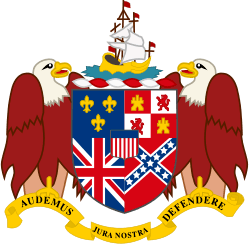
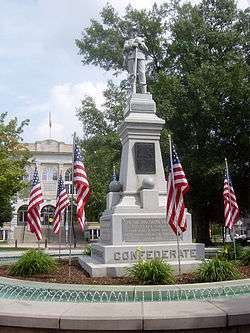
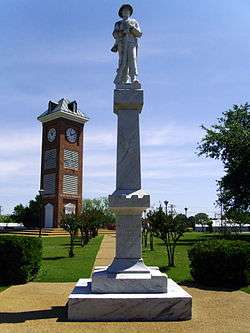
.svg.png)
